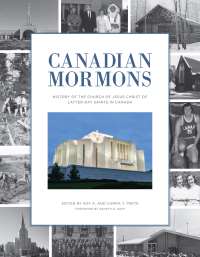The Alberta Settlement
Rebecca J. Doig and W. Jack Stone

Rebecca J. Doig was born in Edmonton, Alberta, and raised in Kingston, Ontario. She earned a BA in history from Brigham Young University and an MA in history from the University of Alberta. She also served a mission in Nagoya, Japan. She is married to Robert P. Doig and is the mother of four children. She has served on several community boards and in many callings in the Church, including Primary president, Young Women president, Relief Society president, and stake Young Women president. She and her family currently reside in Magrath, Alberta. (Rebecca Doig)
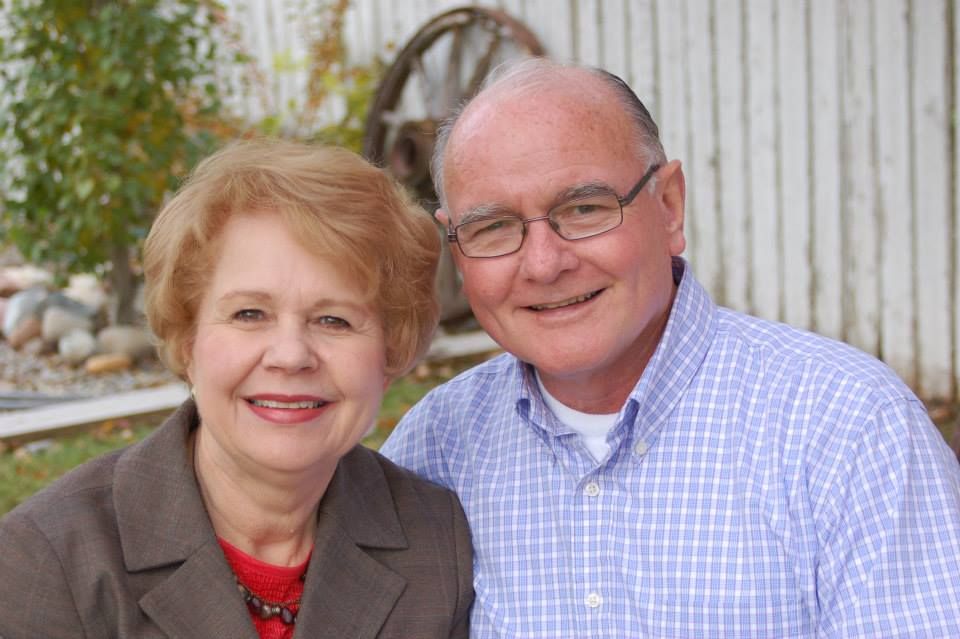
W. Jack Stone was born in Raymond, Alberta. After serving an LDS mission in the eastern Atlantic states, he graduated from Brigham Young University with a BA in English and education, where he subsequently completed an MA in educational psychology and a PhD in educational administration. Making his career in the LDS Church Educational System, he taught in various places, including Cardston and Calgary, Alberta, and Ottawa, Ontario, eventually becoming the CES director for all of Canada for ten years. One of his long-term special interests has been collecting noteworthy stories and materials related to the history of the LDS Church in Canada. He has served as Sunday School teacher, bishop, counselor in two stake presidencies, and counselor in two mission presidencies. He and his wife, Janice, are currently temple workers. They have ten children and thirty-nine grandchildren. (Jack Stone)
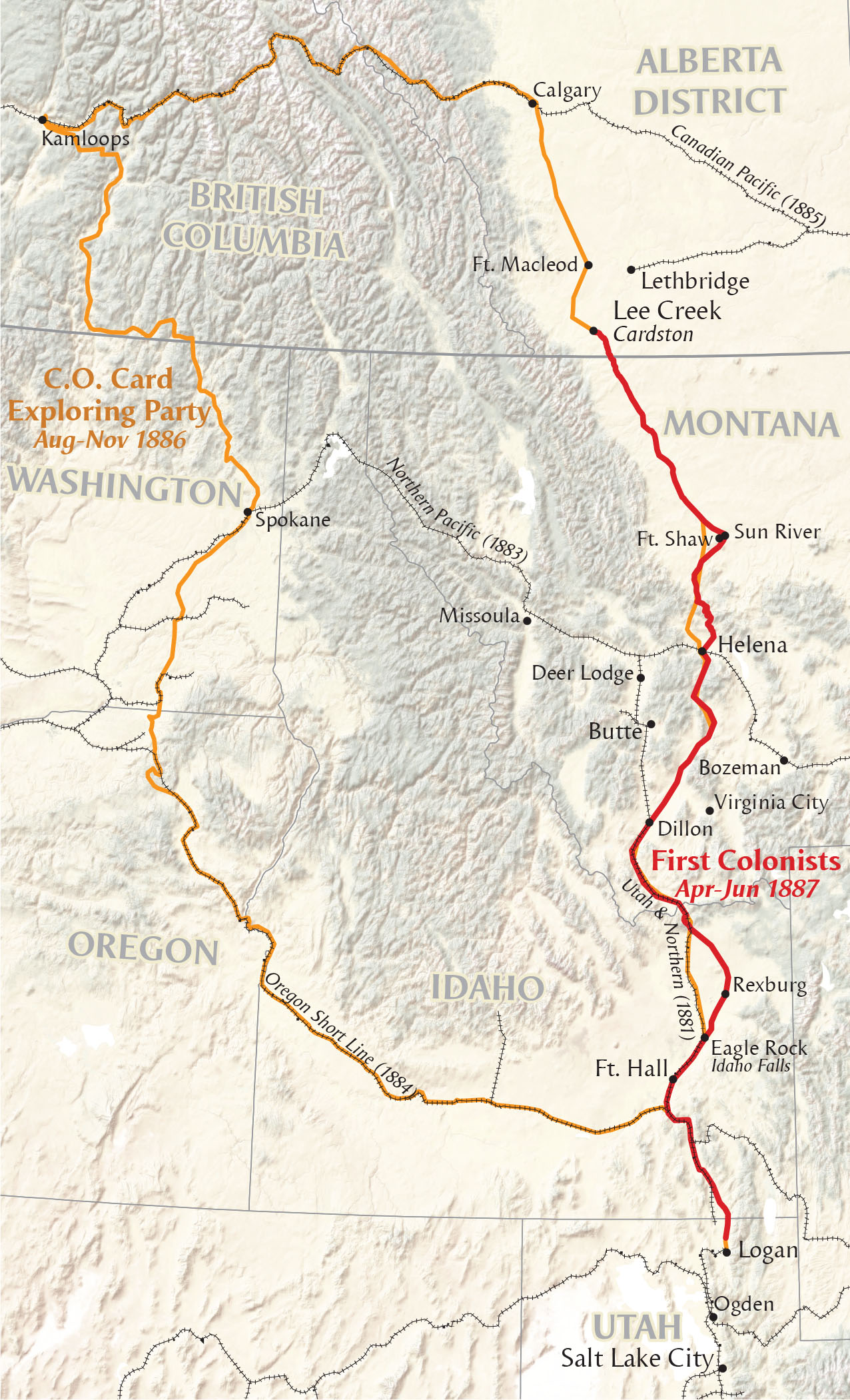 Charles O. Card and two companions made an exploratory trip from Utah to Canada in 1886, travelling from Cache Valley, Utah, to British Columbia and then across the mountains to Alberta. Card decided that southern Alberta would be a suitable place where Latter-day Saints could settle. The following year, he led a small group of forty-one Mormon settlers from Cache Valley to Alberta, establishing a town at Lee Creek,[1] later named Cardston, the focal point for the development of Latter-day Saint settlement in southern Alberta.
Charles O. Card and two companions made an exploratory trip from Utah to Canada in 1886, travelling from Cache Valley, Utah, to British Columbia and then across the mountains to Alberta. Card decided that southern Alberta would be a suitable place where Latter-day Saints could settle. The following year, he led a small group of forty-one Mormon settlers from Cache Valley to Alberta, establishing a town at Lee Creek,[1] later named Cardston, the focal point for the development of Latter-day Saint settlement in southern Alberta.
When Charles Ora Card and his little band of refugees established a settlement at Lee Creek, Alberta, in the spring of 1887, a new era of permanent LDS settlement in Canada humbly began. To these first settlers, Canada was a haven from prosecution for the practice of plural marriage. Many who followed in the next few years found similar refuge in Canada, settling several communities in the Cardston area.[2]
However, it soon became apparent that Canada would also be a land of opportunity for LDS settlers. When economic difficulties hit Utah in the 1890s, many young LDS families looked beyond Utah for a place to settle. Meanwhile, Charles Ora Card and southern Alberta entrepreneurs and land owners Elliott Galt and Charles A. Magrath had been collaborating on an ambitious irrigation building and settlement plan. In the realization of these plans, LDS settlers, many of whom came in response to mission calls, poured into southern Alberta in 1899 and 1900, completing a canal from Kimball to Stirling with a branch to Lethbridge and establishing villages in Magrath and Stirling. Two years later, a fourth major settlement was established when LDS entrepreneur and philanthropist Jesse Knight bought a huge tract of land and committed to building a sugar factory, which would provide employment and open lands for settlement in Raymond and area. This time no mission calls were needed to help Mormon settlers see the opportunities before them. As Mormons spread across southern Alberta in additional settlements, Saints migrated in groups or as individual families to pursue opportunities to homestead, ranch, build industry, or pursue education and employment in cities.
Canada was a place of challenge for Mormon settlers, and these challenges tended to strengthen faith for those who remained. The southern Alberta climate can be harsh. Fierce winds, dry seasons alternating with flood years, hailstorms, untimely frosts, and powerful snowstorms are among the elements southern Albertans have had to contend with over the years. The fickleness of nature on the foothills and prairies of southern Alberta often brought the Saints to their knees in prayer and fasting. Many times throughout the 130-year history of Mormons in southern Alberta, Church leaders have promised rain or some needed change or tempering of the elements in response to the faith of the members, and many times these promises have been fulfilled in seemingly miraculous ways.
In summary, this chapter on the LDS settlement of southern Alberta until 1923 is a story of immigrant Latter-day Saints coming from the United States seeking refuge, responding to mission calls and looking for economic opportunities. It is the story of the establishment of several Church-organized settlements, as well as non-Church-directed settlements and clusters of LDS families across southern Alberta. It is a story of the introduction of irrigation to an arid region and the area’s resulting growth and expansion, including the development of industry and innovation that contributed to the overall development of southern Alberta. This happy story is sometimes interrupted by crop and livestock failures and personal tragedy as the Saints sought to make their way on the unpredictable Alberta foothills and prairies. It is a story of growing acceptance for Latter-day Saints among the general population of southern Alberta, facilitated by the support of Charles A. Magrath and Elliott Galt. It is a story of a humble people living their religion and building their faith. This chapter culminates in the completion of the landmark Cardston Alberta Temple, a symbol of the maturity and faith of the Alberta settlement of Latter-day Saints.
Conditions in Western Canada and Card’s Quest for a Place of Refuge
When Charles Ora Card came to Canada, the Dominion of Canada was only twenty years old, the confederation of four eastern provinces to form the new country having taken place in 1867.[3] The sparsely populated land that later became the provinces of Alberta and Saskatchewan were then part of the Northwest Territories and had been acquired by the Canadian government from the Hudson Bay Company only eighteen years earlier in 1869.
Maintenance of Canadian control of the land north of the 49th parallel was by no means assured. In 1867, the Americans purchased Alaska from Russia. The United States had already established a state in Oregon and a territory in Washington, and, with the purchase of Alaska, the concept of “Manifest Destiny”—that the whole continent was destined to become American—was as strong as ever. Fifty years before Confederation, Canada had been at war with the United States. There were still political tensions between the two nations. Thus, the Canadian government understood the urgent need to take measures to assert sovereignty in the Northwest. By the time Card arrived, the Dominion Land Act of 1872 had already established the pattern for settlement of the Canadian Northwest. The North-West Mounted Police had also been established (1873) with one of its posts located at Fort Macleod.[4] Furthermore, Prime Minister Sir John A. Macdonald had succeeded in his monumental endeavor of building the transcontinental railway, which was finished in 1885.
While these developments tended to assert Canadian sovereignty of the prairies, what was really needed to prevent US encroachment were settlers. However, the prevailing viewpoint, since John Palliser’s report about the prairies was submitted to Parliament in 1865, was that southern Alberta and southern Saskatchewan, which formed the “the Palliser Triangle,” were too arid to support agriculture. In 1887, large land tracts were leased to ranchers, while railway companies held massive land grants and the aboriginal populations had only recently been relegated to designated reserve lands. The Blood Indian Reserve, adjacent to Cardston, was established in the years following confederation with the signing of Treaty #7 in 1877. Though the Dominion Land Act of 1872 had set up the provisions required for homesteading on government-owned lands, southern Alberta had very few farming settlers.[5]
Charles Ora Card’s Legal Trouble and the Advice to Go to Canada
The immediate impetus for the Mormon settlement in Canada was the legal trouble facing Charles Ora Card of Logan, Utah, for practicing plural marriage, trouble that came because of the Edmunds Anti-Polygamy Act of 1882 and its rigorous enforcement which put in jail and fined many Mormon men practicing polygamy. Card had supervised construction of both the Logan Tabernacle and the Logan Temple, and on the day that the temple was dedicated in 1884 he was called to be the president of the Cache Valley Stake.[15] Card was a successful businessman, having been involved in flourmills, sawmills, and general stores.[16] Card had a total of four wives: Sarah (Sallie) Beirdneau, Sarah Jane Painter, Zina Young Williams, and Lavinia Clarke Rigby. However, Card never had more than three wives at a time because Sallie divorced him and filed a suit against him when she became disaffected with the Church and with plural marriage in 1884. This was before Card took his last two wives.[17] All Mormon men practicing polygamy faced the threat of arrest by US marshals, but that threat was particularly acute for Charles Ora Card, both because of his prominence in the Church and community and because of the suit associated with his divorce.
The threat of arrest increased so much in 1885 that Card was in hiding, moving from house to house, staying with friends and families.[18] It became almost impossible for him to carry out his Church responsibilities or provide for his families.[19] On 26 July 1886, Card was arrested and escorted onto a train for Ogden, where he would face incarceration. In Hollywood style, Card jumped from the moving train, mounted a nearby horse, and galloped away through cheering crowds to make his escape.[20]
In September 1886, with wagons already packed for the family to migrate to Mexico,[21] Card sought approval from the President of the Church, John Taylor. Taylor surprised Card, advising against going to Mexico, saying, “No. I feel impressed to tell you to go to the British Northwest Territories. I have always found justice under the British flag.”[22] John Taylor had been born in England and joined the Church in Toronto in 1836. His counsel at this pivotal moment, based on his positive experiences in England and in Canada, changed Card’s plans and eventually led to a permanent Mormon presence in Canada.
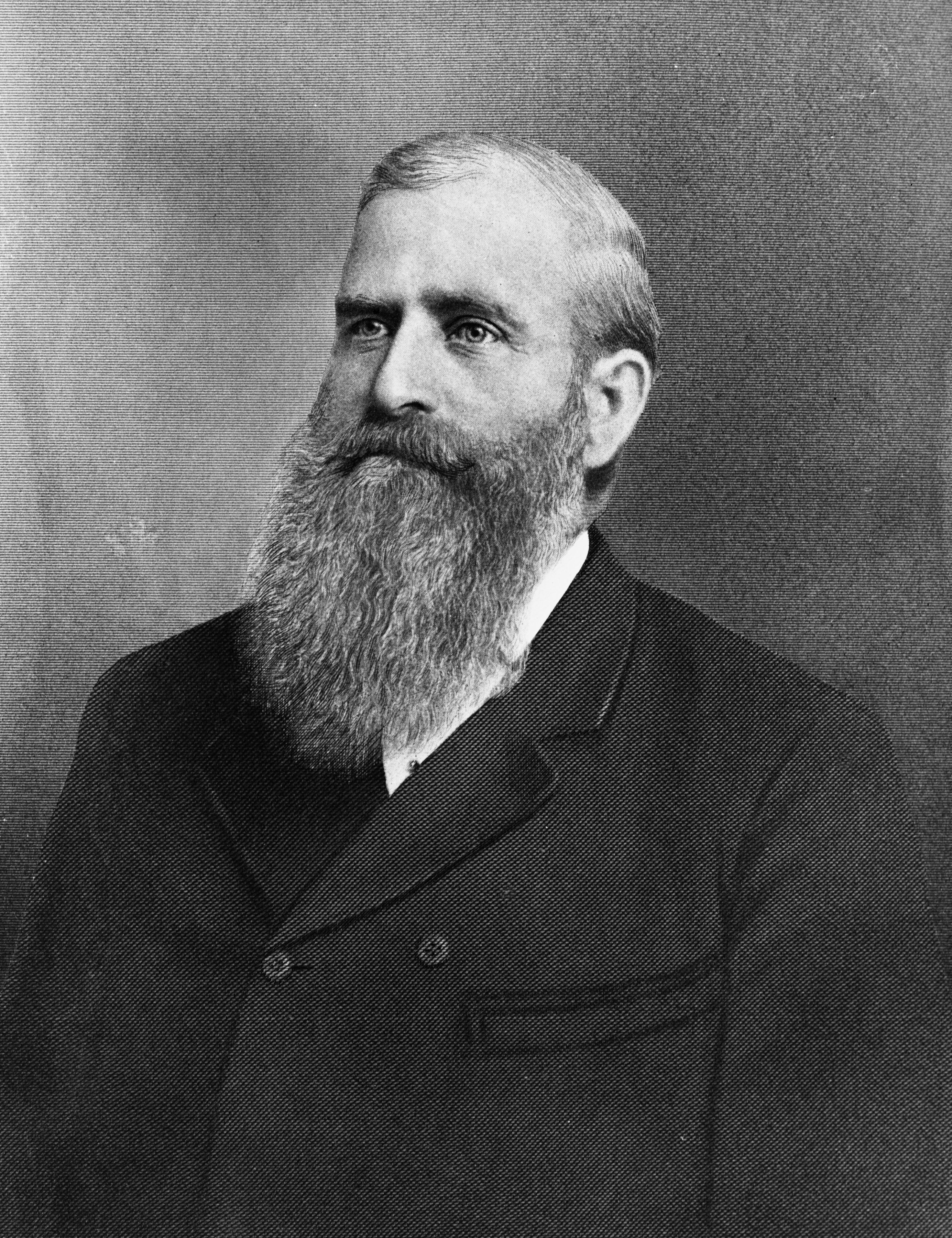 Charles Ora Card led the first group of Mormon settlers to Canada in 1887, where they settled at Lee Creek. (Glenbow Archives NA-1759-1)
Charles Ora Card led the first group of Mormon settlers to Canada in 1887, where they settled at Lee Creek. (Glenbow Archives NA-1759-1)
An Exploration Mission to Canada
A few days later, on 14 September, Card embarked on a Canadian exploration mission with two men who were called to accompany him—James W. Hendricks and Isaac E. D. Zundell. They travelled west by horse and train through southern Idaho up to the area east of Boise, then north through eastern Oregon, and up through eastern Washington state to Spokane. At Spokane, Card and his travelling companions were nearly arrested. As they lay in bed at their hotel room late at night, they heard men outside their door demanding access to the room in search of the “renegade Mormons.” The innkeeper denied the request, preferring to wait until morning. In his journal, Card wrote, “As I lay reflecting over the probabilities of being arrested in the morning, the thought struck me to ask the Lord to cause the party or parties to sleep long enough for us to pack up and get out of the way.” Card’s prayer was answered, and he and his companions were able to leave in the morning undisturbed. They entered British Columbia east of Osoyoos Lake on Wednesday, 29 September 1886. The recent threat of arrest probably made them even more conscious of the refuge Canada offered. As Card recorded: “We . . . crossed the Brittish line and for the first time in my life placed my foot upon the soil of Brittish Collumbia. . . . As we passed the stone monument that designates the line, I took off my hat, swung it around and shouted in Collumbia We are free.”[23]
On Sunday, 3 October 1886, near Osoyoos Lake, the three men held the first known sacrament meeting in western Canada. Card left this record of that meeting, which suggests once again their sentiment that Canada would provide the Saints a place of refuge:
Our prayer is constantly [“]Father direct us by revelation that we may seek the right place.[”] Up to the present we have not had a cross word in our little trio but have night and morn invoked the blessings of God upon us in seeking a haven of rest for the persecuted and imprisoned. . . . We concluded we would hold a meeting today . . . and administered the sacrament. . . . In my [opening] prayer, I Invoked the blessings of God upon the Land and water that it yet would be a resting place for the afflicted and oppressed of the sts [Saints].[24]
Card and his associates found that nearly all the land in that part of British Columbia was already leased in large tracts to ranchers. However, only three days after their sacrament meeting, they met an old mountaineer who told them about the vast buffalo plains east of the Rocky Mountains. Card was deeply impressed with what the man said. Then, reportedly, Card pulled his companions together, put his arms around them, and said, “Brethren, I have an inspiration that Buffalo Plains is where we want to go, that if the buffalo can live there, so can the Mormons.”[25]
Card and his two companions headed further north through the Okanagan Valley, passing through Kelowna, and headed west to Kamloops. Card’s journal tells of selling their horses and paying the lofty sum of $87.60 to board a train for Calgary.[26] After some difficulty, due to arriving in Calgary during a snowstorm, they obtained horses for the rest of their journey and headed south to explore more land for settlement. On Saturday, 23 October, they arrived at Stand Off,[27] and on Sunday, they walked along the Waterton River about two miles west, knelt down, and “dedicated the Land to the Lord for the benefit of Israel both red and white.”[28]
On Monday, 25 October 1886, they returned to their horses and rode south, camping overnight at the “Junction of Lees Creek and St. Marys River [sic],”[29] near the present-day town of Cardston. The next day, the three men started south toward Utah. They finally arrived home on 17 November—their mission to find a place for the Saints having lasted over two months.
It is interesting to note that, while faithful on the exploration mission, neither Isaac Zundell nor James Hendricks chose to settle in Canada. While Card certainly saw potential in the new land, the idea of travelling a thousand miles, leaving wives and children, homes, farms, kindred, and friends behind, to conquer an untamed land in a northern clime was not appealing to everyone.
Recruiting Settlers
After his exploration to Canada, Card returned to Utah to rejoice with his families. Immediately on his arrival, he was busied with family needs, his Church calling, and the urgency of hiding from marshals. Still, Card took every opportunity to speak of the possibilities for a Canadian colonizing mission.[30] In a report he sent to Church President John Taylor, Card presented a list of forty-one men who had told him they would be willing to go to Canada.[31] However, many of them soon backed away from their promise, and Card felt dismayed and alone. On 4 March 1887, Card met with Apostle Franklin D. Richards and told him of his plight of having very few people actually willing to go to Canada. Elder Richards’s reply was insightful, prophetic and encouraging:
He [Richards] stated you can say to them you are going and if your numbers are reduced the[y] will be like the Armies of Gideon and of the right stripe.[32] He encouraged me much and told me if I went I would be a founder of a city and do a good work as a pioneer of a new country and should be known of my good works. He Blessed me as he bade me adieu.[33]
This was the beginning of a pattern for Charles Ora Card. This was not the only time he would have the burden of campaigning to recruit sometimes reluctant settlers to come to Canada. Perhaps one of the reasons for the particularly strong heritage of faith in southern Alberta is that the choice to come in the first place required great faith and strength of character. In other instances, such as after a severe hailstorm in the summer of 1889, the challenges of life in Alberta led some to return to Utah. As Card noted in that instance, “This caused some to become dissatisfied & return to Utah, which had a tendency to weed out many that were not very faithful L.D. [Saints].” Like the armies of Gideon, those who came and stayed were few relative to those who might have, but they were faithful and strong.
The Expedition to Canada
A few Saints gathered in Cache Valley, Utah, in March 1887. Card prepared his family, and, because marshals were watching for him, he disguised himself and secretly headed north with a small group of men who would prepare the way for their families who would soon follow. “They travelled with horse and buggy to American Falls, Idaho, from there to Helena, Montana, by train, and then with teams again to Canada.”[34] Others staggered their departures, believing that if too many men left together they might attract the notice of marshals.[35] On 16 April 1887, Card crossed the border, and he and his fellow travelers spent the next several days in making contacts with the North-West Mounted Police, paying the required duties on imported equipment at the Customs House at Fort Macleod, and making inquiries about obtaining land. They were unsuccessful in getting permission to settle on the land leased by the Cochrane Ranch near Standoff (most likely the land they had dedicated the previous fall), though, interestingly, this land later came into LDS hands when the Church purchased the Cochrane Ranch in the early 1900s. In 1887, however, the vanguard group had to continue looking for a settlement site. The ranching economy was already established, and, though the population density was extremely low, there was very little land actually available to settle. They felt fortunate to find an abandoned lease in the area of Lee Creek,[36] and considered this as a location to settle. This site was appealing because of the creek and because of its proximity to the Blood tribe, for whom these pioneers felt a special sense of mission because of the Book of Mormon promises to them.[37]
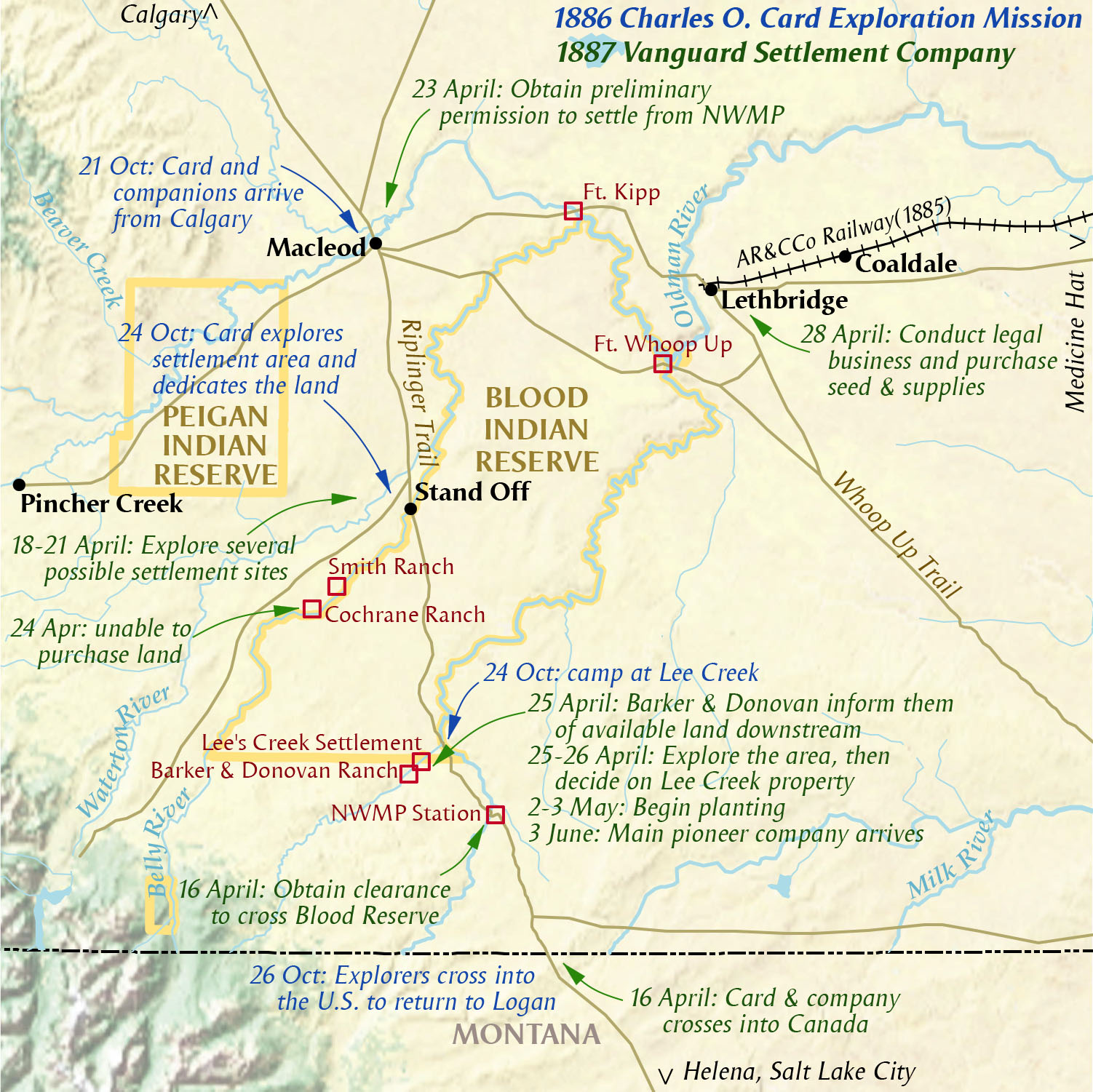
The Cardston Settlement, 1887–1900
On Tuesday, 26 April 1887, Card wrote in his journal, “This evening we voted unanimously that Lee Creek was the best location at present and decided to plant our colony thereon.”[38] On 3 May, Card and his fellow settlers plowed the first furrow, and the following day, they planted onions, lettuce, carrots, beets, radishes, and potatoes. The settlers later planted oats and more potatoes. Card called this his “Pioneer garden.”[39]
The next day, Card began the long, rugged trek south toward Helena to meet his wife Zina who was travelling in a wagon toward Canada along with seven other families, twenty-six cows, and sixteen horses. It was near the town of Boulder, Montana, about halfway between Helena and Butte, where Card had a joyful reunion with his wife, his stepson Sterling, and little son Joseph on Thursday, 12 May 1887.[40] Difficulties accompanied them the entire way, but after nineteen days, they finally arrived in Canada. Card wrote:
Wednesday, June 1, 1887 Today we resumed our march and about 9 A.M. we crossed the north fork of the Milk River [in northern Montana] in a rain storm which lasted about an hour and about 10:30 A.M. we crossed the Boundery line between the Brittish possessions and the United States, halted and gave three cheers for our liberty as exiles for our religion.[41]
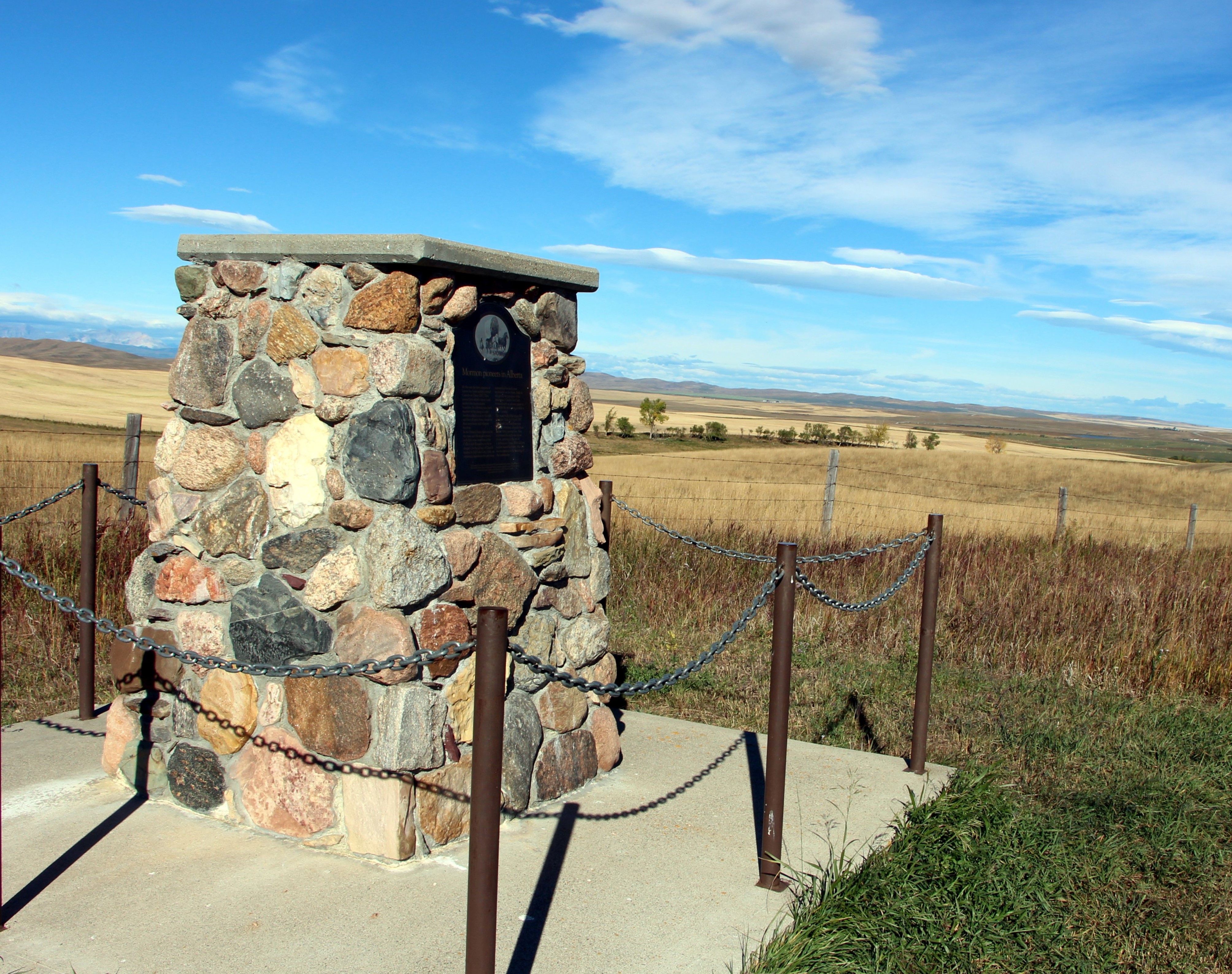 This view of the stone cairn near the US-Canadian border shows the terrain over which the early Mormon pioneers travelled as they entered Canada. (Jack Stone)
This view of the stone cairn near the US-Canadian border shows the terrain over which the early Mormon pioneers travelled as they entered Canada. (Jack Stone)
Beginnings of a Settlement
The next morning, on 2 June, the camp awakened to see four inches of snow on the ground. This must have been a powerful reminder that nature would pose challenges for this brave band of pioneers. They soon began to press forward toward their settlement site. But first, they had to cross the St. Mary River.[43] By the evening of 2 June, the river was so high and fast flowing that they could not cross it. Card counselled the company to “ask the Lord [to] open the way that we might cross the River in safety. We all made it the burthen of our prayers in public & secret.”[44] Their prayers were miraculously answered. The next morning, according to Card, “the stream fell about 18 inches and which just allowed us to cross safely.”[45] According to her account of the same incident, Jane Woolf Bates recorded that, as soon as the seven wagons, livestock, and people were safely on the other side of the river, it began to rain again and the river rose again to its former high level.[46]
Later that day, on Friday, 3 June 1887, Charles Ora Card and his pioneer party arrived at the site along Lee Creek. They set up tents to accommodate their “41 souls, 12 heads of families, 8 with their wives and children.” They were finally home! On Sunday, 4 June, they all gathered into a fourteen-by-sixteen-foot tent to hold a sacrament meeting.[47] A few more families from Utah joined them that first winter, and the first two babies, Zina Alberta Woolf and Lee Ora Matkin, were born in December 1887. Fifteen of the sixteen men in the colony that year were polygamists, many of whom had been in hiding, unable to attend meetings or live openly with their families for some time.[48] Uncertain of the terms on which they might establish themselves in Canada, each came with only one wife.
The new settlers in Canada began plowing fields and planting wheat, oats, and alfalfa. The weather was stormy and difficult for the pioneers but favourable for crops, and the “garden seeds came up in a luxuriant manner.”[49] This colony was unusually blessed with experienced pioneers, many of whom knew from firsthand experience how to settle a new land. The pioneers went about building their colony in a most systematic and productive way. In just the first year, they pioneered roads to get timber from the west, opened a coal bed to mine coal, built and plastered log cabins for their homes, made shelters and corrals for their animals, built a community building that also functioned as a school or church, fenced many acres of land, and made the difficult trek to and from Lethbridge to buy supplies.[50] The Mormons established mutually supportive relationships with their neighbours, inviting local ranchers and police to their Dominion Day celebrations and other parties and events.[51] Card worked hard to establish relationships with Mounties, ranchers, First Nations people, the postman, customs officers, guides, and businessmen in Lethbridge, including perhaps his most important acquaintance, Charles A. Magrath.[52]
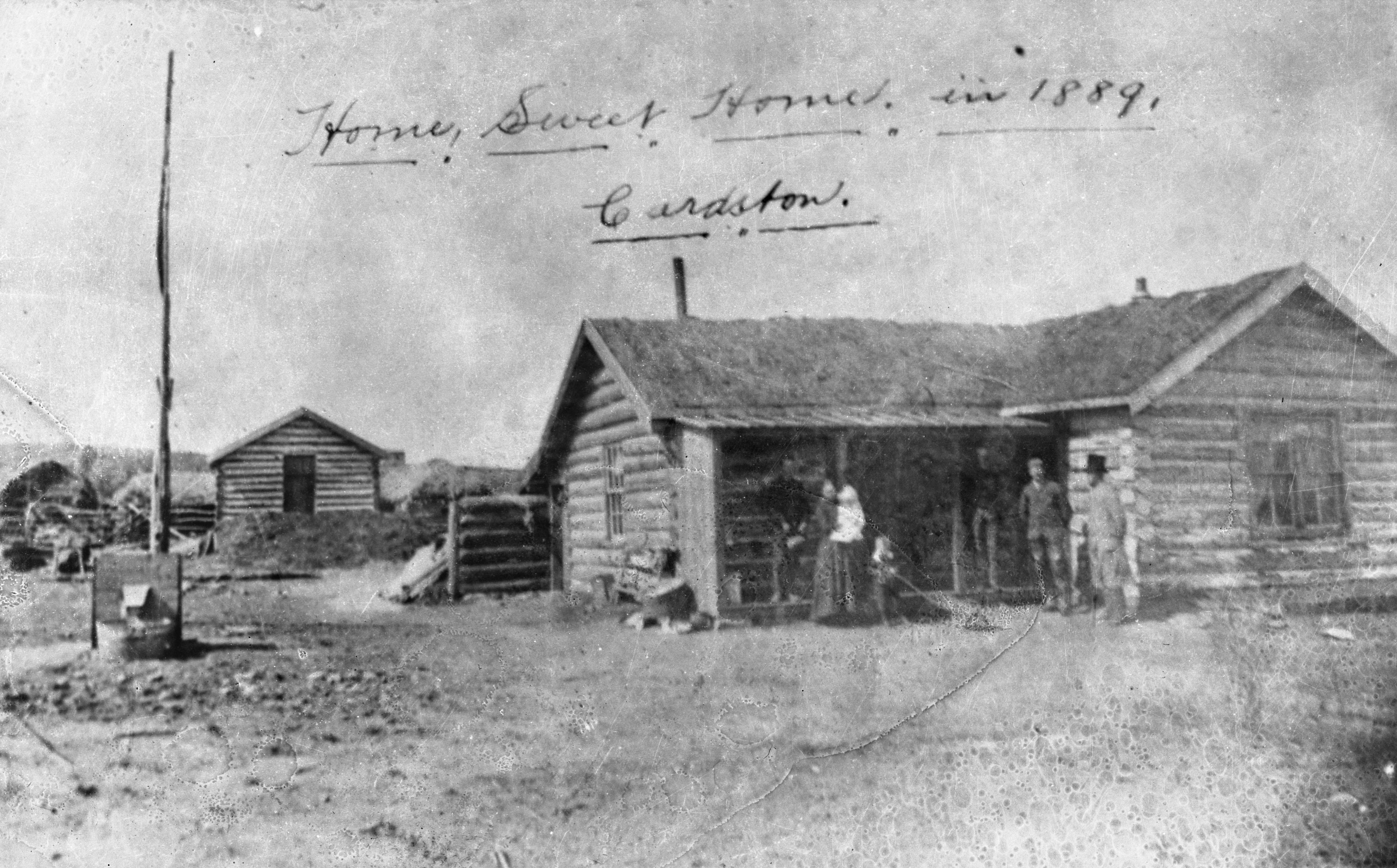 Card Cabin. Charles O. Card, after arriving in Alberta in 1887, built this log cabin in Cardston, where he lived with his wife Zina, a daughter of Brigham Young. It was in this cabin that he and Zina hosted and entertained many government and Church officials and other visitors. (Glenbow Archives NB-3-1)
Card Cabin. Charles O. Card, after arriving in Alberta in 1887, built this log cabin in Cardston, where he lived with his wife Zina, a daughter of Brigham Young. It was in this cabin that he and Zina hosted and entertained many government and Church officials and other visitors. (Glenbow Archives NB-3-1)
It did not take long for the pioneers to learn the peculiarities of the southern Alberta climate, including chinook winds. On 23 January 1888, the day they were plastering the log cabin school, Card recorded that the thermometer registered –20˚F in the morning but showed 40˚F by 1 or 2 p.m. He further wrote, “Although we were enjoying 8 inches of snow It was all gone and the Boys played ball on the Prairie on the 26th.”[53] Mild, pleasant weather seemed to alternate with stormy, freezing weather during the winter,[54] but the faithful pioneers made the best of all kinds of weather, taking advantage of when the rivers were frozen to explore and travel on routes that were otherwise difficult to travel.
Card provided spiritual leadership as much as temporal leadership. He turned to prayer in difficult moments, such as when some wagons loaded with supplies were nearly lost, and the lives of the men and horses along with them, while crossing the St. Mary River in July 1887.[55] When the men were worried about providing for their families, he offered an inspired promise that they would be able to get work, and they soon had jobs haying on the Cochrane Ranch.[56] At each moment of difficulty, Card responded with faith, writing on one occasion in what was a common theme for him, “The Lord has always provided for our wants and certainly we can trust him in the future.”[57]
Early Prophecies of a Temple
The colony felt the spirit of prophecy from the very beginning. On 19 June 1887, less than three weeks after the main company’s arrival, Sunday School superintendent Jonathan E. Layne wrote in his journal about a Sunday School meeting where he spoke. His account is as follows: “While speaking, the Spirit of Prophecy rested upon me and under its influence I predicted that this country would produce for us all that our Cache Valley homes and lands had produced for us, and that Temples would yet be built in this country. I could see it as plain as if it was already here.”[58]
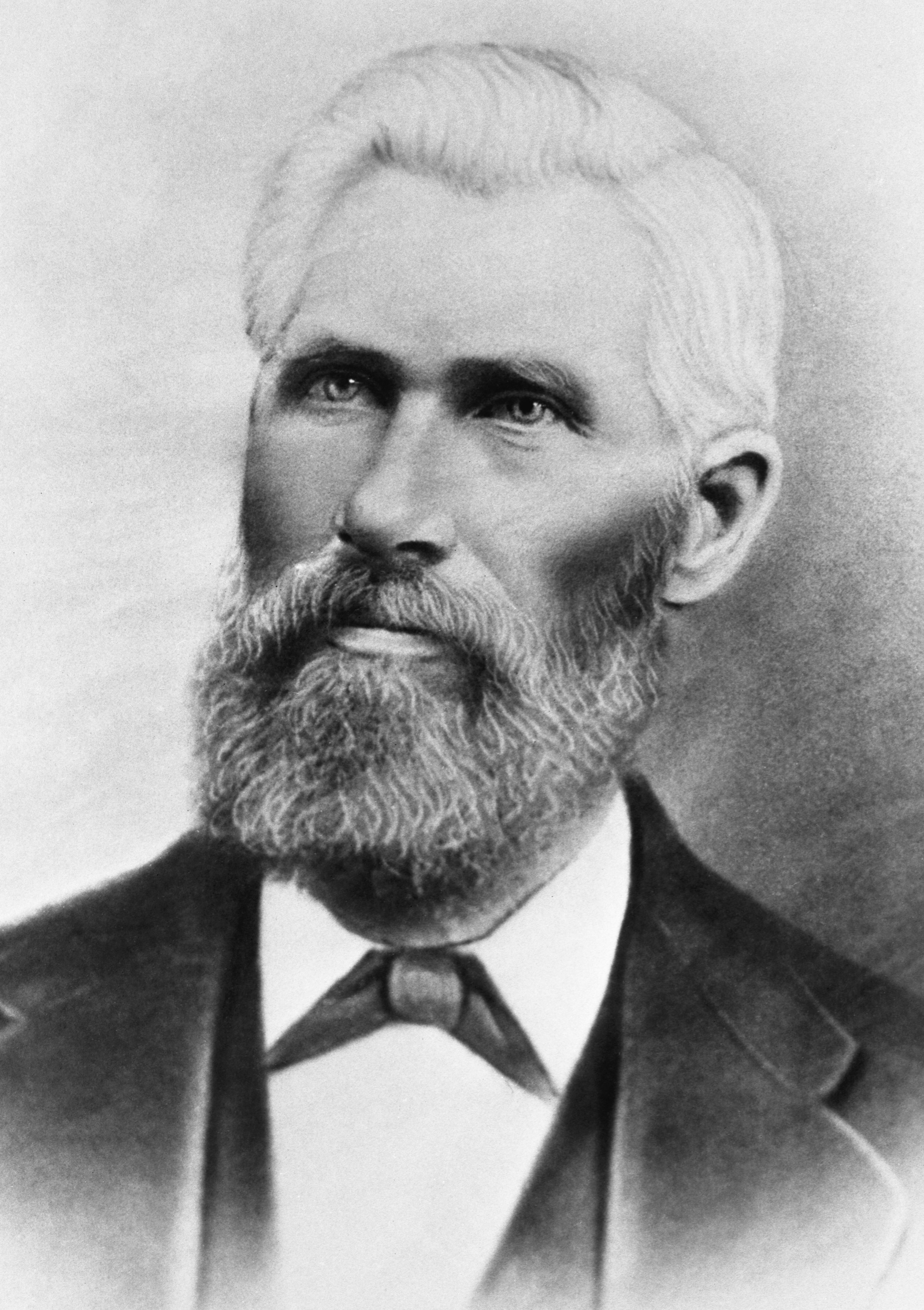 Jonathan E. Layne was one of the original settlers in Cardston and was serving as Sunday School superintendent when he made a remarkable prophecy about a future temple in Canada. (Glenbow Archives NA-114-5)
Jonathan E. Layne was one of the original settlers in Cardston and was serving as Sunday School superintendent when he made a remarkable prophecy about a future temple in Canada. (Glenbow Archives NA-114-5)
In October 1888, a year after the colony was founded, two Apostles, Francis M. Lyman and John W. Taylor (son of Church President John Taylor), came to visit the Saints. A conference was held on 7 October in which the Card Ward of the Cache Stake was created, with John A. Woolf as Bishop.[59] Charles O. Card was still serving as president of the Cache Valley Stake in Logan, Utah, at that time, and the Card Ward became part of that stake.
On Monday, 8 October, Card took the Apostles and others with him up the hill on the west, pointing out the survey of the town site. When they reached the block set aside for the tabernacle, they formed a circle of seven men and seven women, and Apostle Taylor offered a dedicatory prayer, dedicating the land to “the habitation of the saints.”[60] During the prayer, he is recorded as saying, “I now speak by the power of prophecy and say that upon this very spot shall be erected a temple to the name of Israel’s God and nations shall come from far and near and praise His high and holy name.”[61] This prophecy was astounding! The tiny settlement was only one year old, yet a temple was dedicated only thirty-five years later on the very spot.
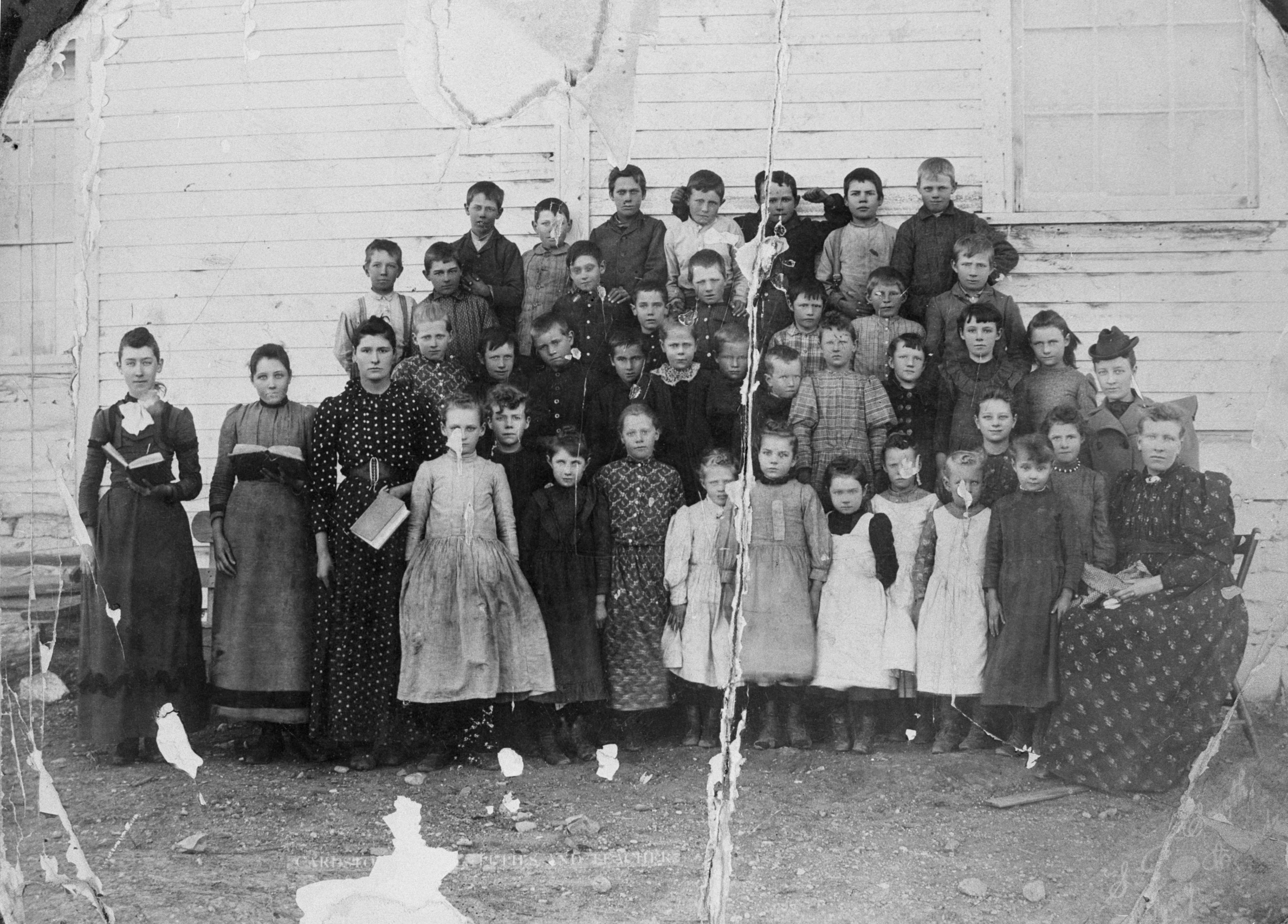 Students and teachers, Cardston Public School, 1895. Education of children was an early priority despite pioneer conditions. (Glenbow Archives NA-147-2)
Students and teachers, Cardston Public School, 1895. Education of children was an early priority despite pioneer conditions. (Glenbow Archives NA-147-2)
Delegation to Ottawa[62]
Only a few days later, Charles Ora Card, accompanied by the two Apostles, left on a landmark 4,000-mile round trip to Ottawa, via the Canadian Pacific Railway, to meet with government leaders, including Prime Minister Sir John A. Macdonald and Edgar Dewdney, Lieutenant Governor of the Northwest Territories. It was important for Card and his associates to ascertain whether the Canadian government was agreeable to the establishment of a Mormon colony and to clearly establish the terms on which they could settle in Canada.
On Friday, 9 November 1888, Card and Apostles Taylor and Lyman met with Dewdney, requesting government permission for the Saints to purchase land and settle in Canada. They asked for permission to purchase coal lands and to use timber and rock for domestic purposes. They discussed the use of water for milling, manufacturing, irrigation, and other purposes. They also addressed the use of tithing by the Church and asked permission to carry out this principle.[63]
The next day, Saturday, 10 November, they met with Sir John A. Macdonald, Prime Minister of Canada, and reviewed the items that had been presented to Dewdney the day before.[64] They also presented their most important request—and least likely to be accepted—permission to practice plural marriage in Canada. As Card recorded:
Bro. Lyman appealed to Him in behalf of those who had Entered in to the covenant of Eternity of Marriage whom at this date were suffering in prisons of the U.S. besides being heavily fined and not allowed to mingle with their families with the repetition of fines and imprisonment and it had become very Grievous to bear. He then asked Sir John if he did not think that this Government would give them a resting place upon their Soil for they were the choicest of men and had many sons and ample means to sustain themselves and would bring wealth into the Dominion. Then Bro. John W. Taylor Explained further the great principle of plurality of wives as viewed by the sts [Saints] and as practiced in its purity for the purpose of observing God’s Laws in multiplying and replenishing the Earth.[65]
The Prime Minister heard them out and seemed to them somewhat sympathetic to their plight.[66] They also obtained audiences with the Post Office General, the Minister of Agriculture and the Minister of Customs. In these meetings, they asked for postal service, a reduction in customs duties and other favours as well.[67]
The matter of Mormon settlers in the Northwest Territories was tricky for the Government of Canada. On the one hand, they had just built the Canada-Pacific Railway at an enormous expense in the hope of asserting Canadian sovereignty on vast prairie land between the provinces of Manitoba and British Columbia. However, since the government had had very little success encouraging settlement, and since the land nearest the border was arid and considered by many to be unfit for agriculture, it was an incredible boon to the government to have such a capable, experienced, and community-oriented people with a grudge against the United States willing to settle. On the other hand, polygamy was extremely unpopular, and the government could not be seen as doing favours for polygamists and could not possibly allow its practice without absolutely assuring a loss at the polls in the next election. The Minister of Agriculture explained to Card that he had tried to openly assist the Mormon settlement, “but it had risen such a hue & cry from the tradesmen that popular clammer [sic] forbade it.”[68]
Hence, Sir John A. MacDonald, Edgar Dewdney, and their associates had to walk a fine line. In essence, their response to the Mormon petitions was to allow all items to be settled according to existing law. The Saints were allowed to buy a half section of crown land for the town site, but they could not obtain additional crown lands except by following existing homestead requirements of the Dominion Land Act of 1872.[69] They were advised of existing laws which allowed for free use of water and stone (except when stone was quarried, in which case there was a 5 percent tax),[70] and the need to obtain a permit to use timber.[71] They would be subject to the usual taxes, duties, and tariffs, but they were advised how to minimize these obligations within existing law.[72] Vague support was given for establishing a postal service.[73]
Perspectives on Mormon Polygamy in Canada
Their request to bring their plural wives to Canada was denied, and within three years the government passed more stringent laws against polygamy.[74] Card gave his promise to Sir John A. Macdonald that Mormon men would not keep more than one wife in Canada.[75] Two years later, an accusation of the practice of polygamy and cohabitation among Mormon settlers reached Ottawa, and Deputy Interior Minister A. M. Burgess relayed the accusation to Card. Card replied “that our good faith in this matter has not been broken [emphasis by Card].”[76] He went on to say, “I desire most earnestly that your department make such investigations as you deem necessary through the Police or otherwise that the Mormon Colony on Lees Creek may be freed from the onus they are branded with by those who delight in misrepresentations against an inoffensive people.”[77] Card did his best to ensure that the Mormon settlers remained true to this promise and the practice of having two wives in Canada was extremely rare.[78]
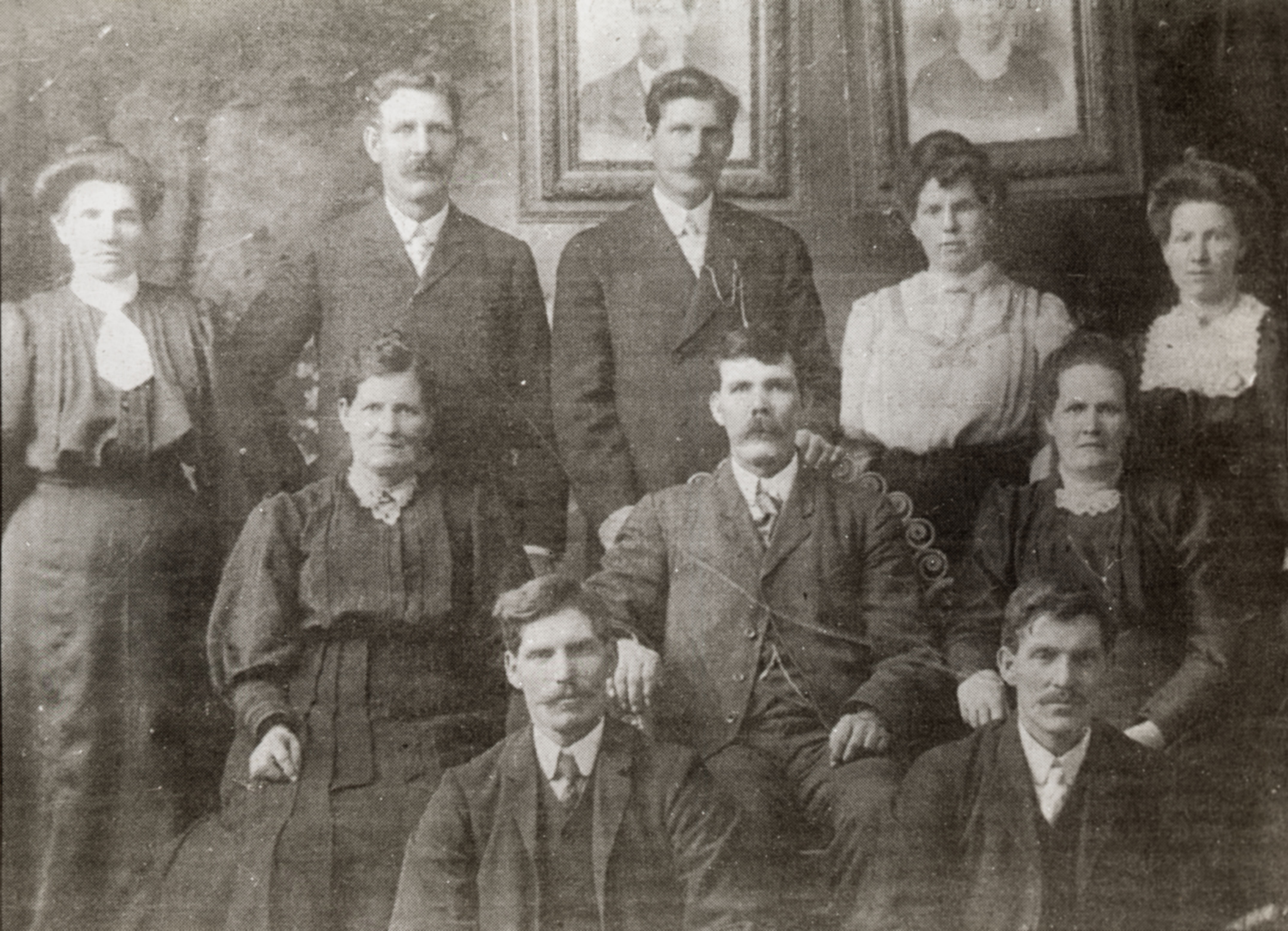 Children of Thomas Rowell Leavitt, one of the first settlers in Cardston, and his wife Ann Eliza Jenkins Leavitt. Front, left to right: Edwin Jenkins Leavitt, Edward Jenkins Leavitt; seated, left to right: Ann Eliza Leavitt, Thomas Rowell Leavitt Jr., Martha Ellen Leavitt; standing at back, left to right: Mary Emmerine Leavitt, William Jenkins Leavitt, Franklin Dewey Leavitt, Louisa Hannah Leavitt, and Sarah Leavitt. Thomas Rowell Leavitt is one of three men known to have had two wives in Canada, though it was only for a short time from 1890 until his death in 1891. Of twenty-three Leavitt children who lived to adulthood, twenty-one lived in Canada as adults, with nineteen of these staying in southern Alberta until their deaths.[79] The settlement of Leavitt was named after Thomas Rowell Leavitt. (Daughters of Utah Pioneers)
Children of Thomas Rowell Leavitt, one of the first settlers in Cardston, and his wife Ann Eliza Jenkins Leavitt. Front, left to right: Edwin Jenkins Leavitt, Edward Jenkins Leavitt; seated, left to right: Ann Eliza Leavitt, Thomas Rowell Leavitt Jr., Martha Ellen Leavitt; standing at back, left to right: Mary Emmerine Leavitt, William Jenkins Leavitt, Franklin Dewey Leavitt, Louisa Hannah Leavitt, and Sarah Leavitt. Thomas Rowell Leavitt is one of three men known to have had two wives in Canada, though it was only for a short time from 1890 until his death in 1891. Of twenty-three Leavitt children who lived to adulthood, twenty-one lived in Canada as adults, with nineteen of these staying in southern Alberta until their deaths.[79] The settlement of Leavitt was named after Thomas Rowell Leavitt. (Daughters of Utah Pioneers)
However, that does not mean that the principle of plural marriage was denounced by early Mormon settlers. The men who initially settled Cardston had additional wives and children in the United States, and most did their best to stay in touch and provide what limited support they could. Some returned to Utah to visit and provide for their families, especially during semiannual general conferences. Still, a few, despite reproofs from Church leaders, never returned to see the wives and children they had left behind.[80] Despite passing an antipolygamy law in 1890 directed specifically at Mormons, the Canadian government turned a blind eye to this cross-border practice of plural marriage so long as only one wife was present in Canada.[81] Local Mounties were frequently on the lookout for any second wives living in Canada but never succeeded in gathering the evidence to make a case.[82]
Meanwhile, the United States government was passing increasingly punitive antipolygamy laws. Those who practiced plural marriage were subject to fines, disenfranchisement, and imprisonment. The Edmunds-Tucker Act of 1887, which was upheld by the Supreme Court in May 1890, allowed for government seizure of all Church assets over $50,000.[83] This would have resulted in temples and meetinghouses falling into the hands of the state. At this time, Church President Wilford Woodruff received a bleak vision of what would happen if the Church did not comply with these laws.[84] As a result, in September 1890, Wilford Woodruff issued a Manifesto counselling the Saints to “refrain from contracting any marriage forbidden by the law of the land.”[85]
This Manifesto largely ended the contracting of new plural marriages within the United States, though most men continued to live with and support their existing families for the duration of their lives well into the twentieth century.[86] However, this first Manifesto was not necessarily considered a renunciation of the principle of plural marriage. After 1890, a lesser number of plural marriages were quietly solemnized outside the United States, including in Canada and in Mexico. Individual Apostles, including John W. Taylor and Matthias Cowley, who were frequently in Canada, understood themselves to be authorized to perform plural marriages outside temples when outside the United States.[87] For example, Theodore Brandley, the first bishop of Stirling, left two wives in the United States, and, shortly after arriving in Canada in 1899, married Rosina Zaugg, who stayed with him in Canada.[88] At the time the Alberta Stake was split in 1903, both of the new stake presidents were counselled by Apostle John W. Taylor to take second wives.[89] Taylor Stake President Heber S. Allen took a second wife, Elizabeth Hardy, in 1903. Their six children were all born in Salt Lake City where she lived.[90] Alberta Stake President E. J. Wood also quietly took a second wife, Adelaide Solomon, sister to his first wife, Mary Ann, in February 1904. Adelaide lived in Salt Lake City, and they had two children.[91] These post-1890 plural marriages were not common.[92] There is evidence that there may have also been people during this period who journeyed to Canada from the United States in order to have their plural marriage solemnized, and then they would return home after that.[93]
In the April 1904 general conference, Church President Joseph F. Smith issued a second Manifesto attaching Church disciplinary action to anyone performing or contracting plural marriages.[94] After this time, plural marriages were no longer sanctioned by the Church. Apostle John W. Taylor, one of plural marriage’s most ardent proponents, was unable to accept this Manifesto, and because of this, he was removed from the Quorum of the Twelve Apostles in 1905. He was excommunicated in 1911 after it became known that he took an additional wife in 1909.[95] Matthias Cowley also continued to advocate for plural marriage following the Second Manifesto and was disfellowshipped but was later reinstated after admitting his error.[96]
Colony Expansion
The 1888 visit to Ottawa, while disappointing on some levels, provided a clear understanding of how the Mormon settlement stood in relation to the Canadian government. Having been denied the purchase of crown land, Card immediately began negotiations to purchase land from Charles A. Magrath, the land manager for the North Western Coal and Navigation Company. That company had received huge land holdings from the government for building a narrow-gauge railway from Dunmore to Lethbridge and was happy to sell land to Mormon settlers, both because they needed cash from the land and because of the potential added business to their railway and coal operations. Over time, Magrath and Card developed a deep mutual respect for each other. Magrath sincerely admired the LDS people and recognized the value they added to the development of southern Alberta. Over the years, they would have many interactions.
Agricultural Villages and the Plat of Zion
As they did in Utah, the Saints settled in farm villages, reminiscent of the Plat of Zion, organized on a grid with settlers living in the village and farming land outside the village.[97] Agricultural villages allowed the Saints to participate in the full program of the Church with all its recreational, cultural, social, service and spiritual components. It also made education, medical care and community businesses and services more accessible (see chapter 6).[98] The rich community life in the Mormon agricultural villages contrasted starkly against the isolated lifestyle of most prairie homesteaders. Some Mormon settlers homesteaded, but Card encouraged them to move into the settlements after they had met the six-months-per-year, three-year residence required to “prove up” on the isolated homestead land.[99]
Card led out in promoting cooperative industries and businesses, many of which operated under the charter of the Cardston Company (chartered in 1892). In his business endeavors, Card was aided by the considerable inheritance of his wife Zina from the estate of Brigham Young. Among the industries established in Cardston before the turn of the century were a store, a sawmill, a gristmill, a cheese factory, and a creamery. There were also cattle and sheep ranching, pig farming, grain and vegetable farming, hay selling, local irrigation projects, a bank, and a newspaper. “The Cardston Company Ltd. expanded to include a butcher shop, farm implements store, a coal mine, ice business, and a glove, boot and shoe factory.”[100] Often, Card travelled far and wide to obtain the best equipment and expertise and to try and secure financing for these projects—a difficult task. He, and even more so, his wife Zina, invested much of their personal money in Canadian land and in these projects, often at considerable sacrifice. The Church provided funds to support the colony from time to time, and this show of official support probably lent credibility to the colony for potential Mormon settlers. The settlers brought in trees, including fruit trees, shrubs, rhubarb, berries, and flowers to beautify the settlement and add variety to their diet.[101]
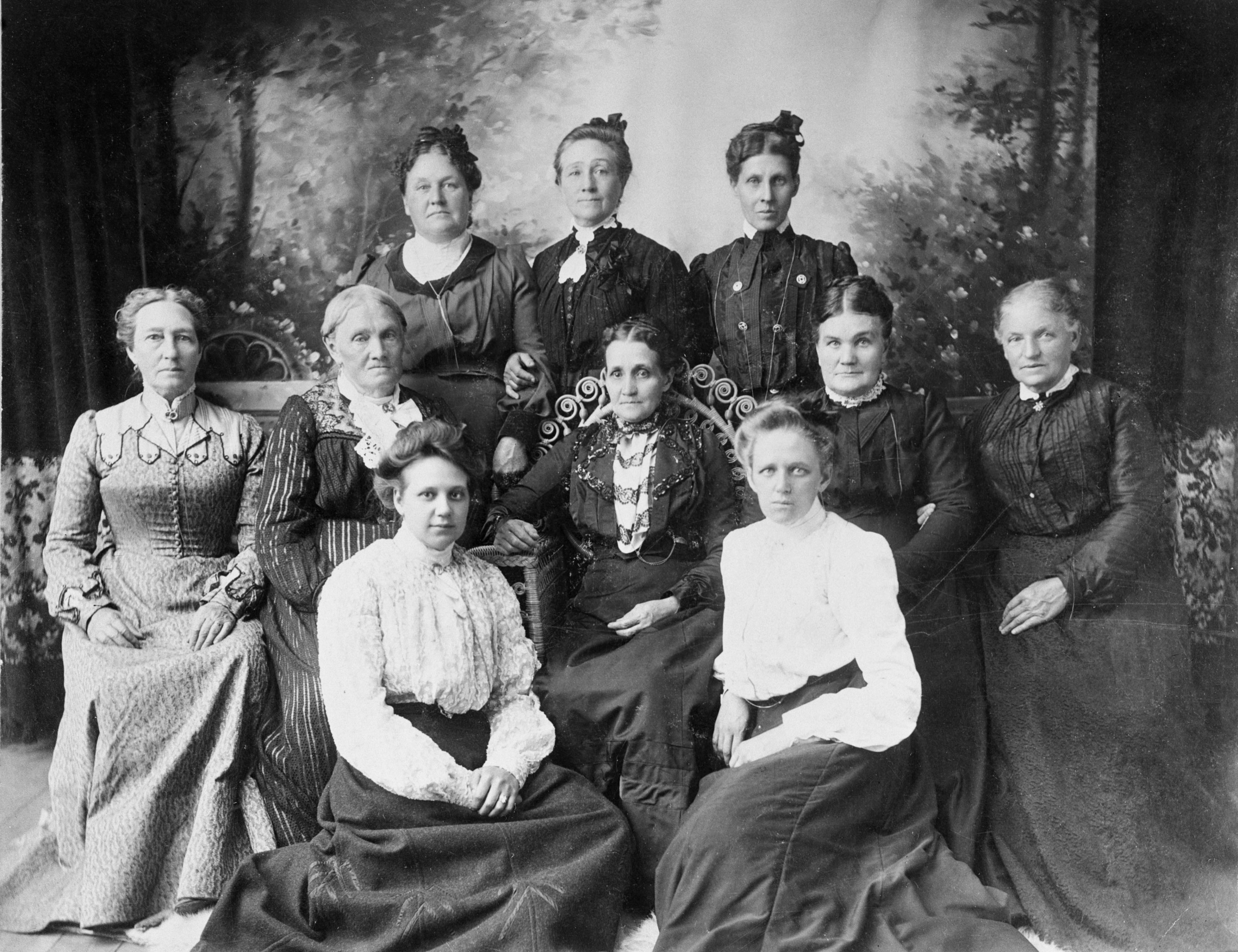 Some of the first women in the Cardston settlement, about 1900. Back row, left to right: Elizabeth Hammer, Zina Y. Card, Lydia J. Brown. Middle row, left to right: Catherine Pilling, Rhoda C. Hinman, Mary L. Woolf, Jane Hinman, Sara Daines. Front row, left to right: Mary L. Ibey, Jane Elizabeth Bates. (Glenbow Archives NA 147-4)
Some of the first women in the Cardston settlement, about 1900. Back row, left to right: Elizabeth Hammer, Zina Y. Card, Lydia J. Brown. Middle row, left to right: Catherine Pilling, Rhoda C. Hinman, Mary L. Woolf, Jane Hinman, Sara Daines. Front row, left to right: Mary L. Ibey, Jane Elizabeth Bates. (Glenbow Archives NA 147-4)
In addition, the settlers tackled transportation and communication problems. They soon built a bridge across Lee Creek and the St. Mary River and mapped out a wagon road to Lethbridge. Rail transport continued to expand and improve, and, by 1890, with the completion of the narrow-gauge Great Falls & Canada Railway, it was possible to travel by rail from Utah to Lethbridge, though the trip required layovers and switching railways. In 1892, after a few years of picking their mail up in Fort Macleod and Lethbridge, a post office was opened in Cardston.[102] The Saints also built the telephone line to Lethbridge, and service was completed in 1894.[103]
Reception of Mormons in a New Land
When Mormons arrived in Canada, they were met with a notably negative reception from the national press and from Protestant churches, while receiving a more favourable reception from government and business officials. Anti-Mormon and antipolygamy articles appeared frequently in newspapers around the country, and “the Mormon Problem” was a hot topic for the Methodist and Presbyterian churches.[104] However, the Lethbridge News and the Macleod Gazette frequently came to the defense of the Mormon settlers when they were attacked by newspapers in Edmonton, Calgary, eastern Canada, or elsewhere.[105] Only after the 1888 delegation to Ottawa, when Card, Lyman, and Taylor requested permission to practice polygamy in Canada, did the Lethbridge News temporarily turn on the Saints, condemning the “hideous aspect of polygamists.”[106]
The reception from government and business leaders was more favourable than the national press, though their position against polygamy was clear and unequivocal. The local customs officer, Dr. William Cox Allen, had instructions from the government to “do all he could to encourage our people to settle in this country, which he said he intended to do.”[107] Whenever dignitaries or government officials were in the area, the Mormon settlers reached out, with Card often entertaining the guests in his own home. In 1889, Card hosted the Honourable Mackenzie Bowell, Minister of Customs, and his associates for two days.[108] Bowell returned to Ottawa with such high praise for the Mormon settlers that he was teased that perhaps he would “resign his seat in parliament and join the Saints.”[109] Thomas Shaughnessy, vice president of the CPR, described the Saints as “the most efficient colonizing instruments on [the] continent.”[110] Similarly, irrigation surveyor J. S. Dennis visited the Lee Creek colony in 1888 and wrote, “Any person visiting the colony cannot help being struck with the wonderful progress made by them during the short time they have been in the country, and I may say that I have never seen any new settlements where so much has been accomplished in the same length of time. I am satisfied that they are an exceedingly industrious and intelligent people, who thoroughly understand prairie farming.”[111]
Gradually, Mormon settlers gained greater acceptance, and, by World War I, Canadian nativism was directed toward immigrants from enemy countries as well as visible minorities. Mormons who were white, middle class, and well-educated were no longer the main focus of negative national press. Overall, Canadian Mormons experienced much less prejudice than other ethnic and religious groups settling in Canada, some of whom were subject to restrictive immigration measures and limitations on human rights.[112] Mormons were also accepted better in Canada than in most other countries in that period. Anti-Mormon sentiment did not lead to violence as it did in the American South or Great Britain, and missionary work was not banned as it was in some European countries.[113]
Relations with Aboriginal Peoples
When exploring southern Alberta, Card was very conscious of being in “Indian country.” While near Standoff in October 1886, he wrote, “I saw good wheat and Oats raised here on the Belly River, By the Blood Indians. This would be in the heart of an indian country. . . . Here would be a good place to establish a mission among the Lamanites.”[114] The Book of Mormon, a primary religious text for Mormons, is the religious history of an ancient-American Christian people. Mormons believed that aboriginal peoples were descended from the Lamanite people of the Book of Mormon. They therefore felt an affinity for these peoples and a desire to teach them about their ancestors. Once they settled just south of the Blood Reserve, Card and the other settlers worked to build friendly relations with First Nations people. Card hosted Blood Tribe members in his home and invited them to social events in Cardston.[115] He recorded the following in 1896, with regard to the Cardston Co. store: “We have always kept friendly relations with the Indians & lead out in giving them 100 cents in goods for each dollar & and treated them with the same consideration as white people giving them 16 oz to the lb. in tea, Sugar & coffee while former traders only gave 12 oz to the lb. cheating them in net [weight].”[116] Card met with Chief Red Crow, the Blood chief, in 1894 and satisfactorily negotiated to allow the LDS sheep ranch to use reserve lands.[117] Card even smoked the peace pipe with Red Crow.[118] However, despite Card’s initial assessment, it does not appear that any organized missionary efforts were directed toward the neighbouring tribes until years later.
Growth
The Lee Creek Settlement, renamed Cardston in 1889, grew, and other nearby settlements emerged. Aetna (1888), Mountain View (1890), Beazer (1891), Leavitt (1893), Kimball (1897), Caldwell (1898), Taylorsville (1898), and Wolford (1900) are the settlements that became large enough to have church units.[119] The mid-1890s were a time of limited economic opportunities in Utah, but the opportunities available in the Alberta settlement were quite well known in Utah due to frequent visits back and forth between the Alberta settlement and Utah, as well as the publication of pamphlets[120] about Canada and reports of Alberta Stake conferences in the Deseret News.[121] Card recorded in his journal on several occasions that on his frequent visits to Utah, he answered many enquiries about Canada.[122]
As each community became firmly established, corresponding wards and branches were created. In 1895, although the LDS population in Canada was only about 780,[123] the First Presidency approved Card’s request for the creation of an Alberta Stake, the thirty-fifth stake of the Church, and called him as stake president. By this point it must have been clear the colony would experience continued growth. The creation of a stake itself encouraged growth by adding strength and stability to the settlement. By the end of 1898, the settlements had grown and there were 1597 Saints living in eight communities in the southern Alberta foothills.[124] It should be noted that those who settled in the area in the 1890s were not necessarily polygamists; the primary motivation for settlement for many was economic.
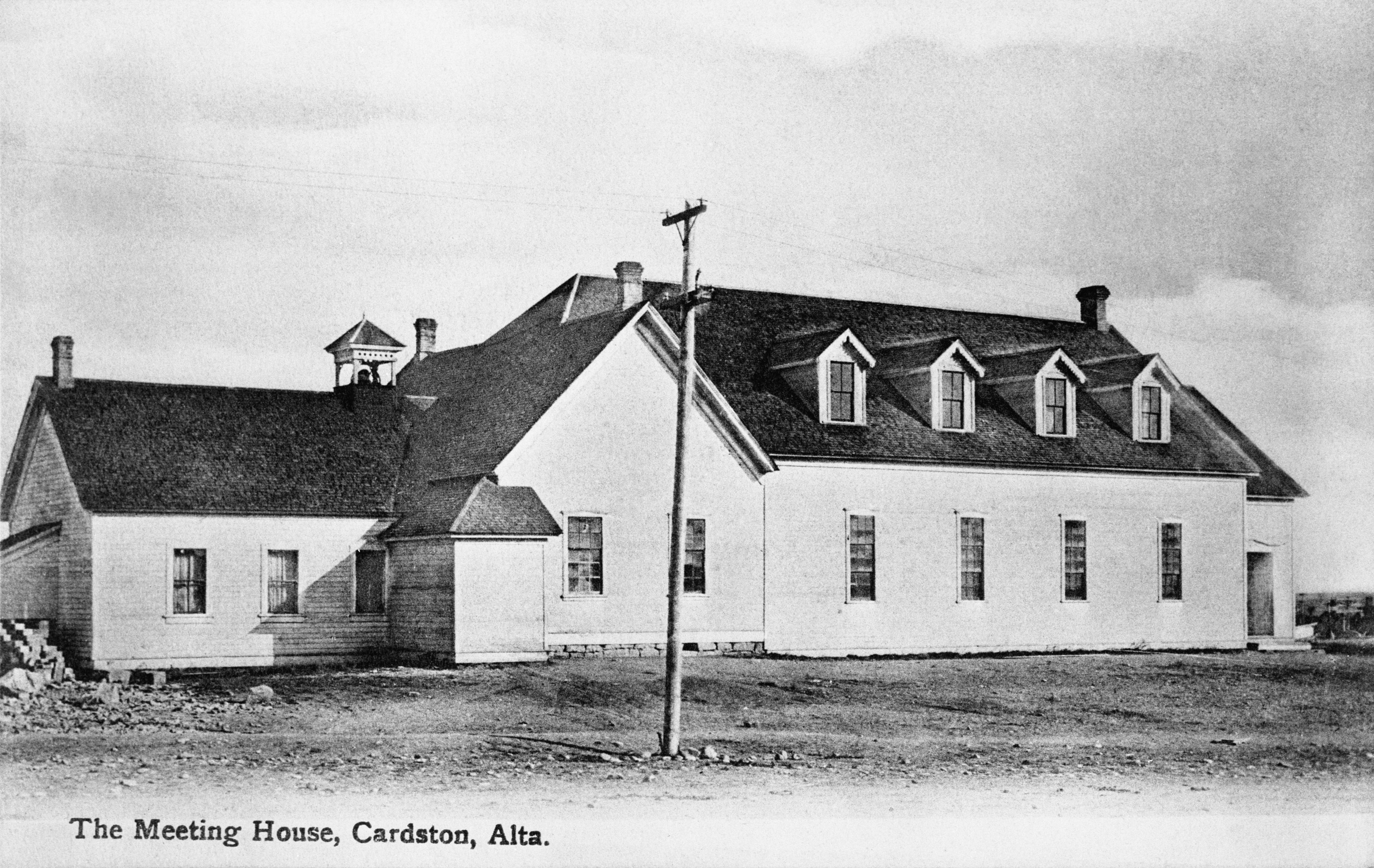 Cardston meetinghouse, 1910. (Glenbow Archives NA-114-19)
Cardston meetinghouse, 1910. (Glenbow Archives NA-114-19)
The Church in Alberta was not just growing in size, but it also experienced a Pentecostal feast of gifts of the Spirit. At many meetings, Saints (usually women) spoke in tongues. Always accompanying this gift was another who was given the gift to interpret tongues. On these occasions, people made prophecies and gave words of blessing and caution.[125] Other people uttered additional prophecies, including some by Card,[126] with Apostle John W. Taylor being mouth of many other prophecies that were later fulfilled.[127] Many times, priesthood holders were called on to administer to the sick, and witnesses reported corresponding healings. The Saints often met together in fasting and prayer to ask the Lord to temper the elements, or to help them in times of need.[128] These spiritual gifts offered hope, joy and consolation to this faithful band of pioneers who felt exiled from their homes and families for choosing to live the laws of God, as they understood them.[129]
 John W. Taylor, a member of the Quorum of the Twelve Apostles, took a particular interest in the Alberta settlement. He made frequent visits there, where he made prophecies about the future of the settlement and promoted various business enterprises, including irrigation and sugar beets. (Glenbow Archives NC-7-534)
John W. Taylor, a member of the Quorum of the Twelve Apostles, took a particular interest in the Alberta settlement. He made frequent visits there, where he made prophecies about the future of the settlement and promoted various business enterprises, including irrigation and sugar beets. (Glenbow Archives NC-7-534)
Irrigation and the Beginnings of Magrath and Stirling
Levi Harker’s Vision
Levi Harker first settled in the Cardston area in 1892,[130] where he and his brother Ephraim, both monogamists, pioneered sheep farming under Card’s direction.[131] One day, as Levi was out riding his horse, herding sheep, looking down on a completely uninhabited and untamed prairie landscape, a vision opened to his mind:
As he rode and looked north from his vantage point on the northern slope of the Milk River Ridge, . . . suddenly he felt impelled to stop his horse and look north, when a vision opened to his view. . . . He saw the country criss-crossed with wire fences, divided into fields, prosperous farms; well-travelled roads ran between the section lines; a canal wound its way along the slope of the Milk River Ridge and fields of golden grain were everywhere. Interspersed were green fields of sugar beets or hay. Prosperous farm-steads dotted the fields. On the north bank of Pothole Creek he saw a prosperous town with beautiful trees and comfortable homes. He looked in wonder as he saw beneath the soil rich reservoirs of gas and oil, potential wealth of the future. A voice seemed to say, “You will see all this come to pass and more.” The vision faded— the wind blew in his face, bent the prairie grass eastward as he turned his horse west toward Cardston and home.[132]
In 1899, the vision began to be fulfilled when Levi Harker was called to serve as the first bishop of the new settlement of Magrath. He served in that capacity for thirty-two years and also filled two terms as mayor. So beloved was he for his work in building up that community that he was termed the “father of Magrath.”[133]
The St. Mary Canal-Building Project
God’s hand was in the founding of the communities of Magrath and Stirling. One evidence is God opening this vision to Levi Harker. Another evidence is the miraculous confluence of circumstances that unfolded in the 1890s to bring about the monumental contract between the LDS Church and the Alberta Irrigation Company resulting in the building of the first large-scale irrigation canal in Canada and the LDS settlement of communities in Magrath and Stirling in 1899. When Card and his fellow settlers came to Cardston, they brought with them irrigation experience from the Cache Valley in Utah and immediately recognized the potential for large-scale irrigation projects to turn the arid southern Alberta prairie into productive farmland. As Magrath related, the Mormons “understood irrigation, and Lethbridge being their market town, we were continually told of the wealth that could be created by diverting onto the land the waters running to waste down the rivers.”[134] Card, Apostle John W. Taylor, Richard Pilling, and others promoted southern Alberta irrigation among Canadian officials, potential investors, and the LDS Church over a period of many years before they were able to see the dream of a large-scale irrigation project in southern Alberta.[135]
Soon after the Mormon pioneers settled in Cardston, they began small-scale irrigation projects, even though the Cardston area, being in the foothills of the Rocky Mountains, often gets adequate rain for crops. They built at least two irrigation ditches near Cardston. The first was completed on 15 July 1890 but began operation June 1894. It powered the gristmill and irrigated town lots and adjacent farms.[136] A second project, the Pioneer Irrigation Canal, supplied water to eight hundred acres on south side of Lee Creek. Both projects were in operation until 1902, when they were damaged by flooding.[137] The success with these small projects demonstrated to others in the area the potential of irrigation and instilled in them the belief that Mormons were the ones who could do it.
In 1891, with great optimism about the future of irrigation in southern Alberta, Charles Card and John W. Taylor negotiated a contract with Elliott Galt and his land agent Charles A. Magrath to purchase seven hundred thousand acres at $1.00 per acre on condition of providing it with irrigation by 1895.[138] However, there were many obstacles to building a large-scale irrigation project, such as the lack of irrigation law, the company land being located in alternating townships, the feasibility of the project not having been formally studied, lack of investors, reluctance for the LDS Church to get involved, and unwillingness for its members to come and build the canal and settle. It proved impossible to overcome these obstacles within the time frame agreed to, and the contract lapsed.[139]
Elliott Galt, son of Alexander T. Galt, a father of Confederation, was a talented and well-educated entrepreneur and colonizer with strong connections in government and with investors. He teamed up with Charles A. Magrath, who later married Galt’s sister. Magrath was an expert surveyor, enthusiastic land developer, and faithful associate. The two men were the key players in a succession of companies that first began mining coal at Lethbridge in 1882.[140] Their second project, completed in 1885, was to build a narrow-gauge railway from Lethbridge to Dunmore to connect with the CPR to provide a market for their coal. They also built the Canadian portion of the Great Falls & Canada Railway, which connected Lethbridge with Great Falls, Montana, by December 1890.[141] For each project, they were awarded massive land grants. Later, when they widened their railways to standard gauge, they were granted even more land. In total, they were granted a whopping 1,592,368 acres of land.[142] Land was usually allocated to railways in alternating sections (a section is one square mile), but they arranged for land in alternating townships (a township is six square miles) so that the blocks of land would be large enough for ranches. However, leasing their land to ranchers was not very profitable. In order to pay their stockholders, they needed to convert their land into money, and the key to making their land habitable was irrigation. After Taylor and Card’s contract lapsed, Galt and Magrath moved to the forefront in promoting a major irrigation project which required the unlikely cooperation of the Canadian government and British and local investors, including the CPR, and the LDS Church.
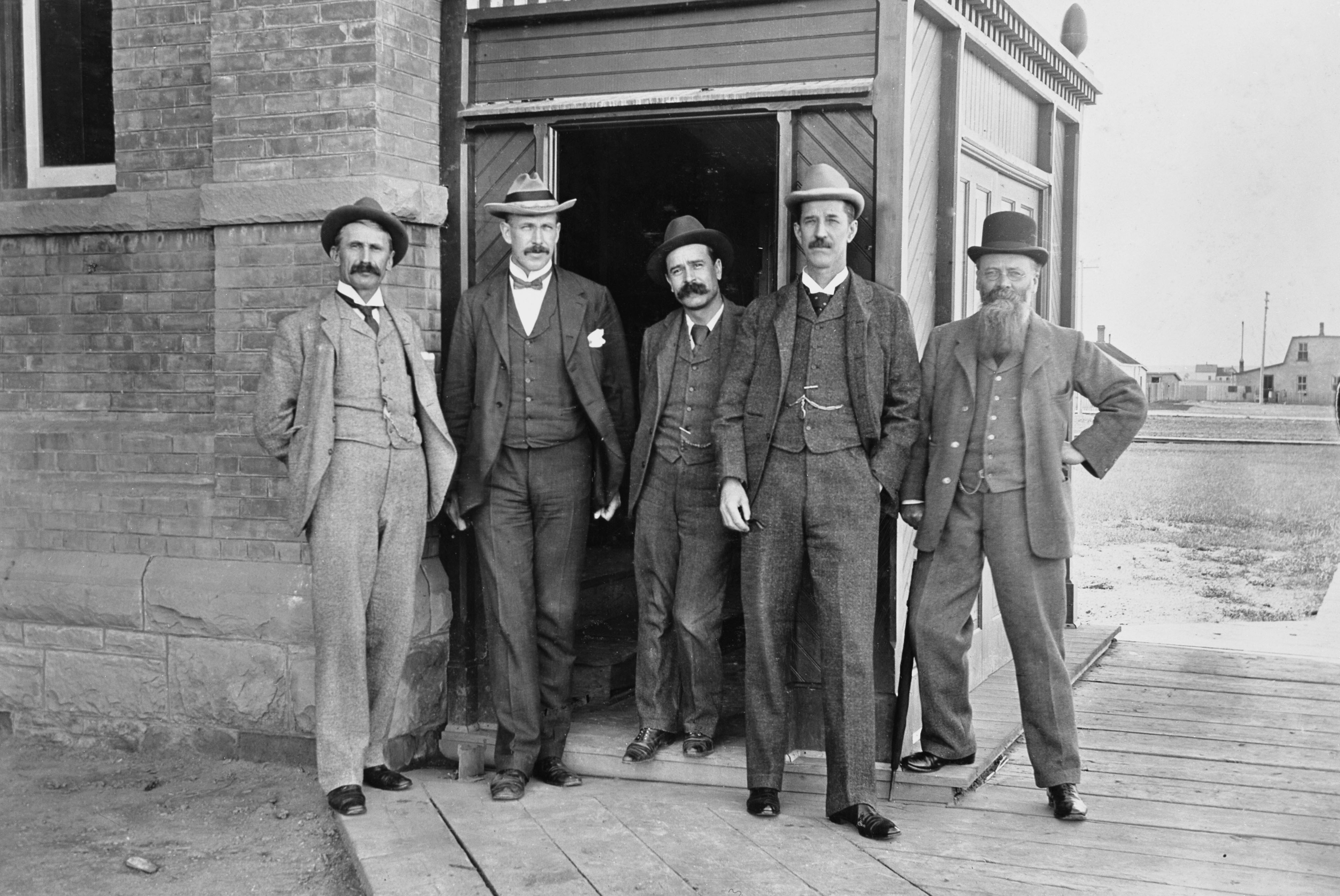 The Alberta Railway and Coal Company, 1898. Canadian business leaders and entrepreneurs recognized opportunities for profitable partnerships with the industrious Mormon settlers to develop and settle arid lands in southern Alberta. Left to Right: W. D. Barclay, manager of the Bank of Montreal; C. Magrath, ARCC Land Commissioner; G. G. Anderson, consultant; Elliot Galt, ARCC President; and Jeremiah Head, consultant. (Glenbow Archives PD-301-19)
The Alberta Railway and Coal Company, 1898. Canadian business leaders and entrepreneurs recognized opportunities for profitable partnerships with the industrious Mormon settlers to develop and settle arid lands in southern Alberta. Left to Right: W. D. Barclay, manager of the Bank of Montreal; C. Magrath, ARCC Land Commissioner; G. G. Anderson, consultant; Elliot Galt, ARCC President; and Jeremiah Head, consultant. (Glenbow Archives PD-301-19)
Meanwhile, William Pearce, a land surveyor, successful irrigation entrepreneur in the Calgary area, and a senior employee in the federal department of the interior, was promoting to the Canadian Government the idea of expanding irrigation to solve the problems of settling the arid Palliser Triangle. After 1882, in his capacity as inspector of land agencies, he reported directly to Prime Minister Sir John A. Macdonald. In the early 1880s, he travelled to the US Midwest and Intermountain West, including Utah, where he studied Mormon irrigation and settlement methods. By 1883, he was convinced that Mormon irrigation and land settlement practices should be applied to the Canadian West. He began promoting his ideas in 1885 within the Department of the Interior through speeches and reports, but the federal government did not receive his ideas well, because they worried that his talk about irrigation might actually discourage settlement in parts of the Northwest where there was adequate rainfall for agriculture. He was soon forbidden to speak publicly about irrigation, but he continued to promote irrigation in the government and was ultimately influential in changing the anti-irrigation climate in Ottawa.[143] Pearce, meanwhile, experienced success with some small-scale irrigation projects of his own in Calgary, and this success was a necessary precursor to the St. Mary project, as it encouraged otherwise skeptical investors.[144]
Various councils and lobby groups were established in the 1890s to promote irrigation, and the press in Lethbridge, Fort Macleod, and Medicine Hat[145] also clamoured for irrigation development. However, the Conservative government only began to reconsider its hostility to irrigation when a major drought started in the late 1880s and continued through the mid-1890s, and when Pearce brought to their attention that the Montana government was looking at diverting the water from the St. Mary River to the Milk River for a large-scale irrigation project of its own.[146]
Finally, in 1894, the government enacted legislation based on Pearce’s recommendations, which formalized irrigation law and retained riparian (meaning “adjacent to a river bank”) rights to the government to enable large-scale projects rather than piecemeal development. Beginning in 1895, the government undertook a survey of the St. Mary River area to determine the feasibility of a large-scale project. Later, the Alberta Irrigation Company (the latest Galt company) commissioned a second survey, which improved plans for the canal and greatly reduced expenses by making use of the existing Pinepound and Pothole Creeks as main arteries for the canal.[147]
Two important events proved providential to the irrigation scheme: the election of the Liberal Government of Wilfrid Laurier in 1896 and the appointment of Clifford Sifton from Winnipeg, who was also an enthusiastic promoter of Western Canadian settlement, as Minister of the Interior. After years of the previous government’s unsuccessful lobbying, Minister Sifton quickly agreed to a major concession that was necessary to the irrigation project—the consolidation of railway lands from alternating townships into solid blocks.[148] Without this concession, they would have needed to obtain rights of way and build around other people’s land, which would have made the project inefficient and thereby unrealistic. In addition, Galt succeeded in convincing Sifton to reimburse the cost of the canal survey. This concession, though not very expensive for the government, was enough to signal to investors the support of the government that was needed to satisfy their jitters.[149]
With irrigation law established, surveys completed, lands consolidated, and investors secured, the final step was to find a way to get the canal built and people settled on the land. This is where the Mormons came into the picture once again. Prime farmland in Utah had been parceled out by the 1880s, and Mormon settlements had expanded into fertile valleys throughout the Intermountain West. By the late 1890s, there were many Saints trying to eke out a living on marginal lands. In addition, the Cleveland Panic of 1893 resulted in an economic depression and high unemployment in Utah in the late 1890s.[150] Thus, there was a providential alignment of both a “push” from Utah and a “pull” toward Canada, which brought many settlers.
By 1897, Church leaders were interested in negotiating an irrigation agreement, with their primary goal being to provide employment and economic opportunity for Church members.[151] Initial proposals from C. A. Magrath, which would have provided land at $1.00 per acre provided the Church built the irrigation system, were unsatisfactory to the Church, as the Church was not able to finance the project.[152] Later proposals involved other investors providing capital, with the Church providing labour compensated in equal parts of cash and land at $3.00 per acre. On 14 April 1898, the terms of the contract were decided. Work on the canal was to begin before 1 September 1898, and by 31 December 1899, Mormon contractors were required to have earned $100,000 ($50,000 in cash and 16,667 acres of land). By April 1900, the Church was required to have established two hamlets with 50 families (250 residents) each and to have earned $150,000 ($75,000 in cash and 25,000 acres of land). Labour was to be paid at a rate of 12.5 cents per cubic yard of ordinary soil with rockwork, cement, side hill work paid at a higher rate. The land was to be available in two large, nearly square blocks around each of the two hamlets.[153] Water rights were then available to farmers at a rate of $2.00 per year, which could be earned by working on the canal or the railroad.[154] Though the initial project called for the building of a canal from Kimball to Stirling, residents of Lethbridge protested being left out of the plan and a branch line to Lethbridge was included in the project. Water flowed through the completed canal from Kimball to Lethbridge and Stirling beginning in July 1900.[155]
The communities of Stirling and Magrath were laid out as classic Mormon farm villages, with wide streets oriented north– south and east– west and square blocks divided into lots large enough for a family to keep animals and a garden. Farmland for town residents would be located outside the community. Centre blocks were designated for businesses, recreation, churches and schools.
Mormon Canal Building
The Church gave Charles Ora Card both the authorization and responsibility to encourage settlement and canal building and to make sure the terms agreed to by the Church were fulfilled.[165] It was no small task, but as always, Card relied on his faith in God to help him with the task. In his journal, Card wrote:
April 26, 1898 I met with Prests [Presidents] Cannon & Woodruff [Wilford Woodruff was President of the Church and George Q. Cannon was his Counselor in the First Presidency] & talked Canal matters over about Alberta & the construction of the Canal the Church had engaged to do $100000.00 worth of Labor. . . .I was told in this interview that the Church depended on me to see that the work was done & contract carried out. . . .
I am left to paddle my canoe as before & trust in the Lord as my brethren seem powerless, the Church is behind so much. [This refers to the Church’s financial debt at that time.] I will here record for the sake of my children in the future the Lord has never required anything through his Servants that I have not been able to perform. . . . & all I can do is to be industrious and continue to lean on the Lord. [166]
Construction on the canal began on Friday, 26 August 1898, south of Kimball, with Charles Ora Card digging the first furrow.[167] In 1898, work began to build the headgates to supply the canal with water diverted from the St. Mary River and on the section of canal between Kimball and Spring Coulee.[168] This work was done by Saints already living in southern Alberta.
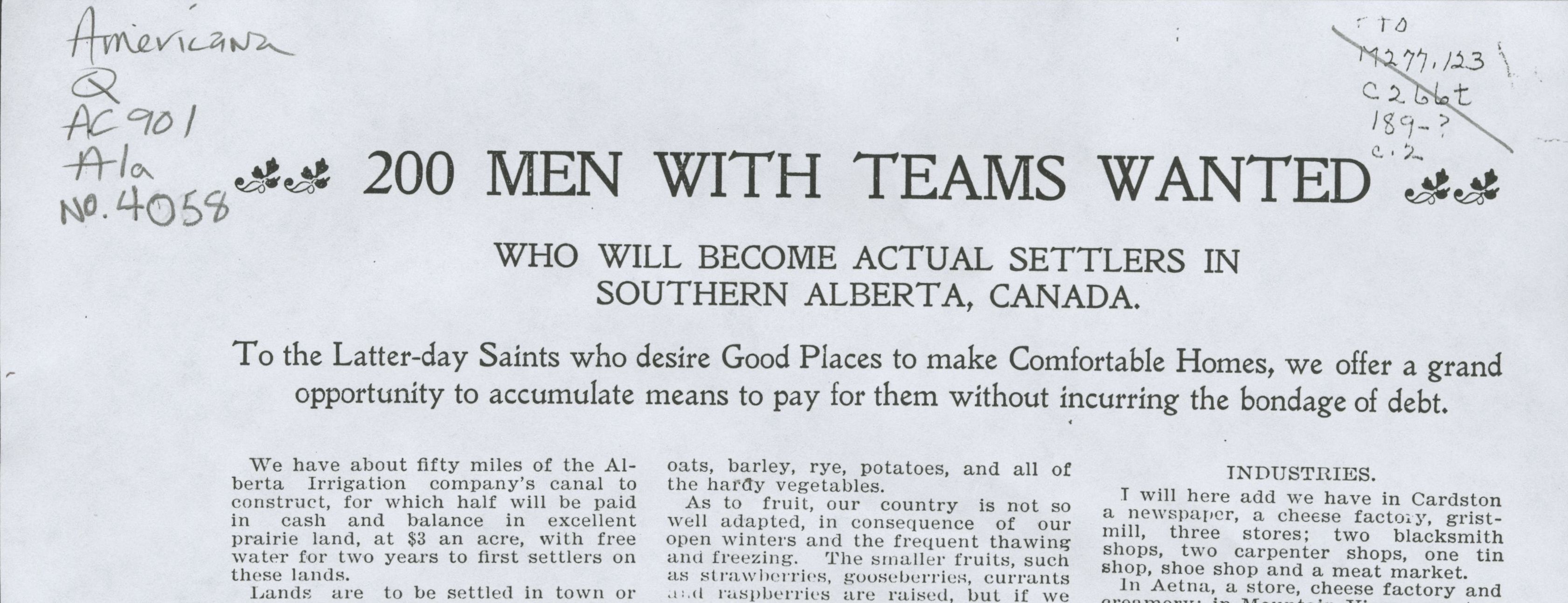 Charles Ora Card travelled all over Idaho and Utah in the winter of 1899 promoting the southern Alberta irrigation project. This article, which appeared in the Deseret News in January 1899 and was also printed as a circular, was part of his campaign. (Photo Archives, L. Tom Perry Special Collections, Harold B. Lee Library, Brigham Young University)
Charles Ora Card travelled all over Idaho and Utah in the winter of 1899 promoting the southern Alberta irrigation project. This article, which appeared in the Deseret News in January 1899 and was also printed as a circular, was part of his campaign. (Photo Archives, L. Tom Perry Special Collections, Harold B. Lee Library, Brigham Young University)
From December 1898 until April 1899, Card travelled all over Utah promoting the Canadian irrigation project. He kept an exhausting pace, speaking to congregations, publicizing through pamphlets as well as articles and advertisements in the Deseret News, and answering questions in person and by letter.[169] Despite the recruiting efforts of Card, John W. Taylor, and others, there were not enough people with the needed teams, equipment, leadership skills, and expertise volunteering to come to Canada. In early 1899, the Church began issuing mission calls, some for canal building and others for both canal building and settlement, in an effort to assure that they could meet their contract obligations and establish successful settlements.[170] Church members responded to the calls, and by the end of 1899, there were 424 settlers in Magrath and 349 in Stirling.[171] One of the first people called on a colonizing mission was Theodore Brandley. On 4 May 1899, he arrived by train at the Stirling junction with his family and company of 24 souls, the first settlers of Stirling. His call was to direct the settlement of Stirling.[172] As new families arrived, he met them at the train station, helped them choose a town lot for their future home and get started on canal building.[173]
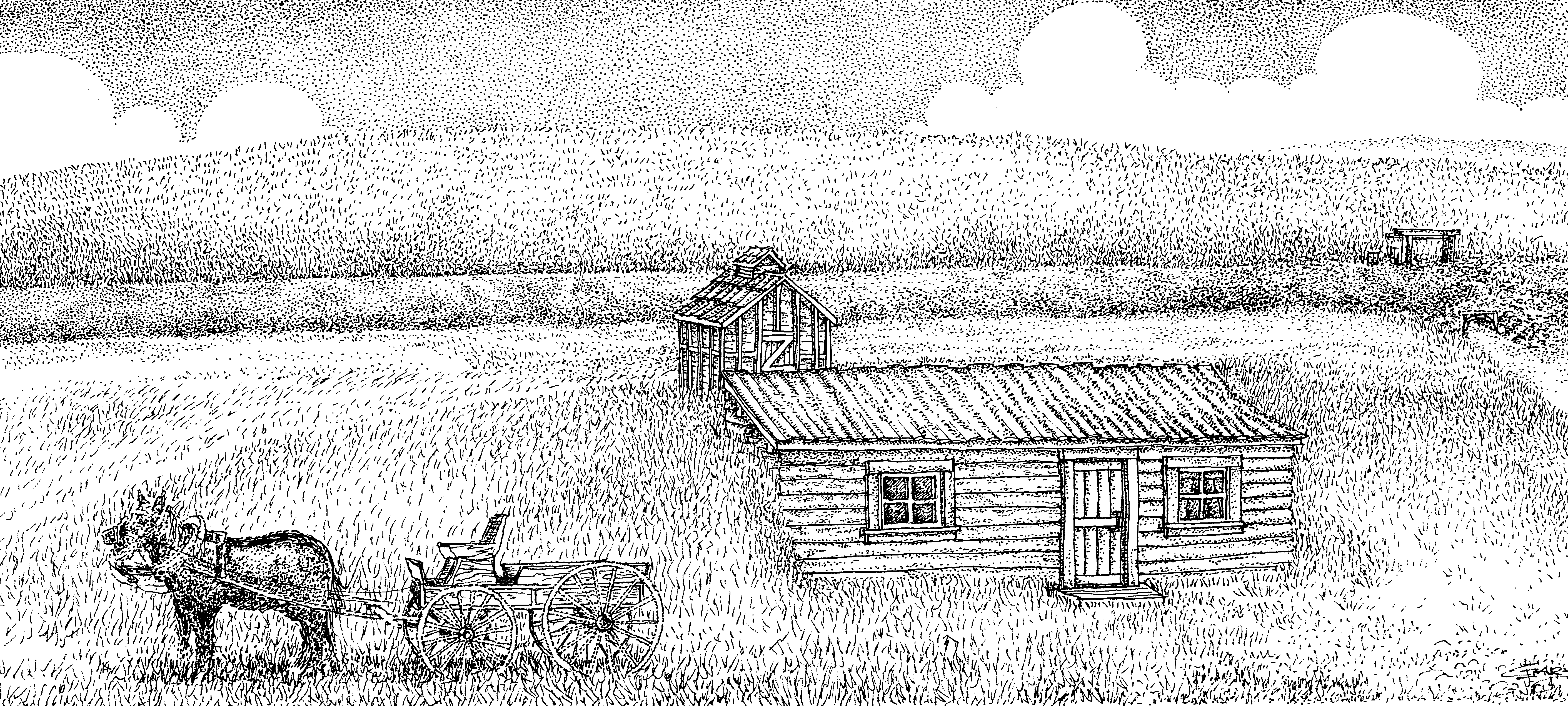 Charles Heber Dudley was the first settler in Magrath. He came alone and took a contract for a particularly challenging one-mile section of canal just east of today’s Highway 62, which came to be known as “Gumbo Point.” He returned to Utah for his family in the spring of 1900. This picture is a depiction of the twenty-four-by-eighteen-foot dugout home, excavated into the hillside, where his family lived for four years. (Alan Dudley)
Charles Heber Dudley was the first settler in Magrath. He came alone and took a contract for a particularly challenging one-mile section of canal just east of today’s Highway 62, which came to be known as “Gumbo Point.” He returned to Utah for his family in the spring of 1900. This picture is a depiction of the twenty-four-by-eighteen-foot dugout home, excavated into the hillside, where his family lived for four years. (Alan Dudley)
The first families began arriving in Magrath in April 1899. On 20 April 1899, C. H. Dudley was the first person to arrive in Pothole, which was renamed Magrath in May 1899. The Rasmussen family arrived shortly after and claimed the honour of being the first family to arrive. Some, like Theodore Brandley and his company, came to Canada by rail, while others came by wagon. Though rail service was available as far as Stirling, it was logistically difficult and expensive for those travelling with animals, equipment, and household belongings to travel by rail. Those who travelled by wagon faced a six-week-long journey on rutted trails over mountain passes, through frigid rivers and across barren plains in often cold, stormy weather.[174] Truly, this was a new generation of Mormon covered-wagon pioneers. Receiving a mission call to leave behind lands, businesses, friends, and relatives just to uproot family and tame a new northern wilderness was no small thing. Responding to the call required great faith, and the Mormon settlements in Magrath and Stirling were blessed to be populated by this calibre of faithful and faith-filled pioneers.
 To encourage more Latter-day Saints to settle in Alberta and participate in the canal-building project, Church leaders issued mission calls to faithful and industrious men and their families to relocate in Canada. This mission call letter, dated 19 May 1899, was addressed to Willard G. Richards and signed by Joseph F. Smith of the First Presidency. It is an example of many similar letters that were sent. (Courtesy of Jack Stone)
To encourage more Latter-day Saints to settle in Alberta and participate in the canal-building project, Church leaders issued mission calls to faithful and industrious men and their families to relocate in Canada. This mission call letter, dated 19 May 1899, was addressed to Willard G. Richards and signed by Joseph F. Smith of the First Presidency. It is an example of many similar letters that were sent. (Courtesy of Jack Stone)
Canal building was done with teams of horses plowing the ground to loosen it and removing the dirt with a horse-pulled slip scraper, not aided by any machinery. It is estimated that by the time the Lethbridge branch line was completed in 1900, over 1,121,000 cubic yards of dirt had been moved, and over one million feet of freighted-in lumber had been used to build gates, sluiceways, and buildings.[176] Canal building was an arduous task under the best of conditions, but in the spring of 1899, canal workers faced anything but optimal conditions. According to the story told by Samuel Woolley Taylor, son of Apostle John W. Taylor, two weeks of heavy rain in June 1899 slowed progress on the canal to almost a standstill and severely discouraged workers, who wondered why irrigation was needed in a country with so much rain. The men were growing increasingly concerned that with work on the canal going so slowly, they would not have time to plant crops in time to reap a harvest before winter. Some were ready to give up on the canal. However, at this critical moment, John W. Taylor travelled around to the work camps, encouraging the workers. He reminded them of the Church’s contract and of their responsibility to uphold the integrity of the Church. He promised them that if they would fulfill their canal obligations, the Lord would temper the elements and they would obtain a harvest, though the season was late. He also encouraged them to hold dances and play music at their camps to lighten their spirits. Eventually, the weather improved and the canal work progressed. Apostle Taylor’s promises were fulfilled. Miraculously, the summer season was extended, and the Saints were able to harvest their crops.[177]
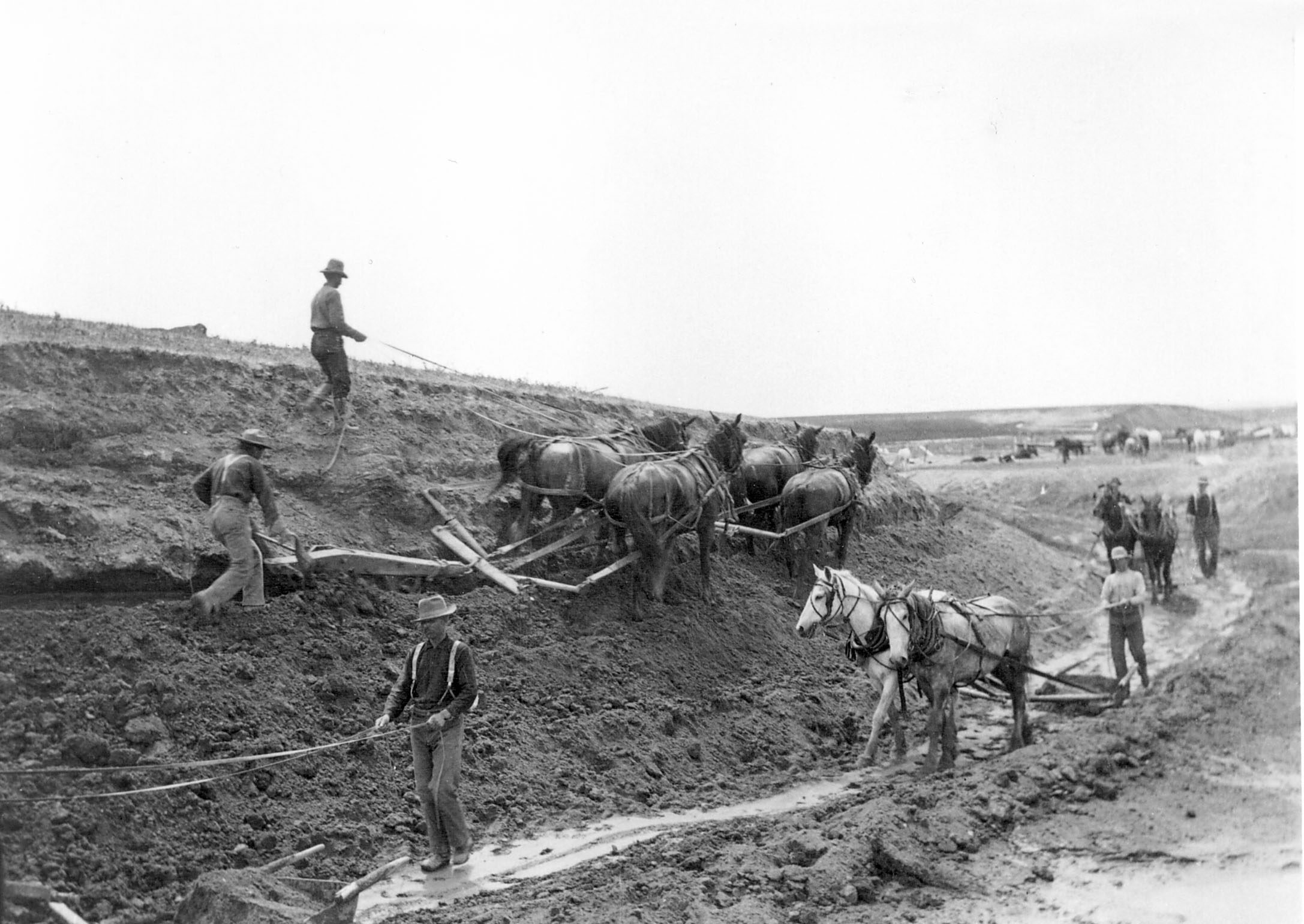 From 1898 to 1900, Mormon settlers built the irrigation canal from Kimball to Stirling with a branch line to Lethbridge. Teams plowed the ground to loosen the earth, then moved the soil one-tenth of a meter at a time with a horse-drawn slip scraper. (Sir Alexander Galt Museum and Archives)
From 1898 to 1900, Mormon settlers built the irrigation canal from Kimball to Stirling with a branch line to Lethbridge. Teams plowed the ground to loosen the earth, then moved the soil one-tenth of a meter at a time with a horse-drawn slip scraper. (Sir Alexander Galt Museum and Archives)
During the period of canal construction, new settlers received a visit from Joseph F. Smith of the First Presidency of the Church. In a meeting held 6 November 1899, President Smith spoke powerfully and prophetically of the importance of LDS settlement in Canada. He told the Saints that they were in the Lord’s vineyard where God wanted them and that they were “laying the foundation of a great work that [they could not] comprehend.” He told them that God would bless them there and not forget them.[178] Little could these weary pioneers imagine the strength their little communities would contribute to the Church in Canada.
The canal had an inestimable value in opening up the Canadian prairies for settlement and assuring Canadian sovereignty north of the 49th parallel. The canal itself brought in many settlers, but perhaps more importantly, its success proved that the Palliser Triangle could be settled with the help of irrigation. It was the first of many large-scale irrigation projects in this arid region. According to geographer Lynn Rosenvall, irrigation canals and water systems constitute “the most important Mormon contribution to agricultural development in Western Canada.”[179] These systems continue to contribute to the agricultural productivity of southern Alberta in the twenty-first century.
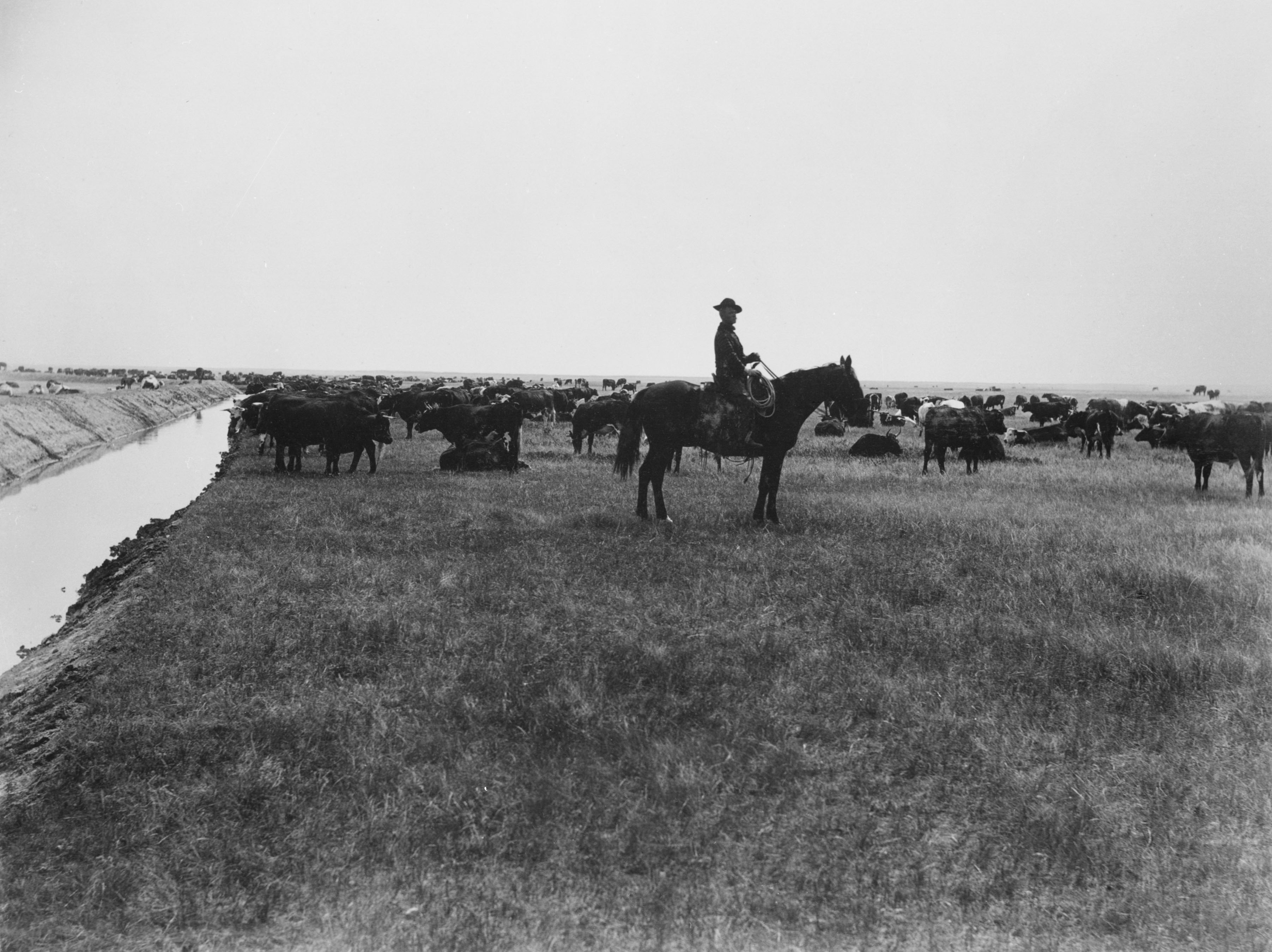 A cowboy watches his cattle beside a newly dug irrigation canal in Stirling, 1900. Irrigation soon transformed grasslands, which had previously served for the grazing of cattle, into farmlands. (Glenbow Archives NA-922-18)
A cowboy watches his cattle beside a newly dug irrigation canal in Stirling, 1900. Irrigation soon transformed grasslands, which had previously served for the grazing of cattle, into farmlands. (Glenbow Archives NA-922-18)
Community Building in Magrath and Stirling
Settlers in Magrath and Stirling had the advantage of Church organization in place early. The first Church services were held in Magrath on 28 May 1899. Two weeks later, Levi Harker, the sheep farmer who had been living in the Cardston area and who had the vision of the future of Magrath, was sustained the first bishop of the Magrath Ward. On the same day, Theodore Brandley was sustained as bishop of the new Stirling Ward.[180]
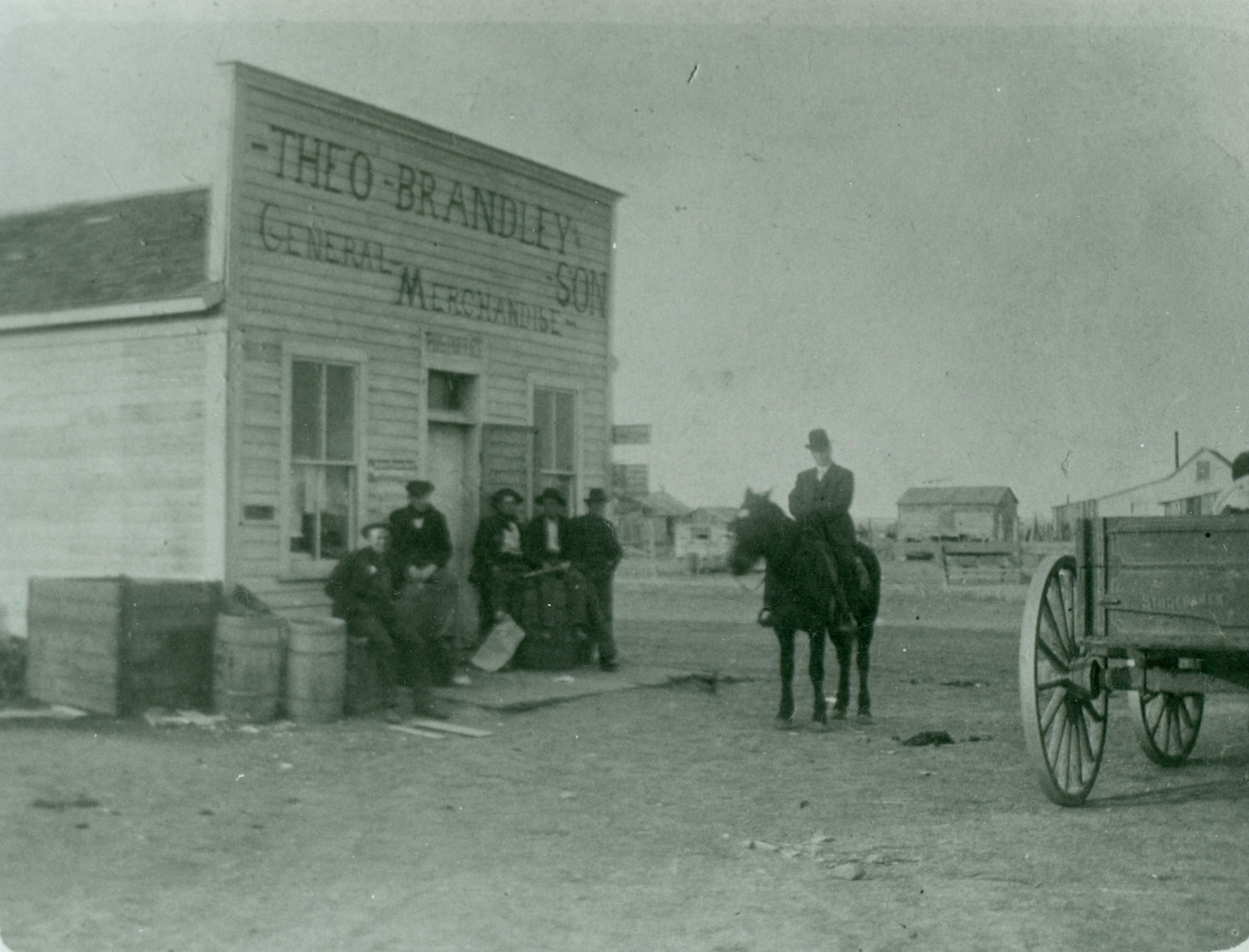 The Theodore Brandley General Store in Stirling. (Church History Library)
The Theodore Brandley General Store in Stirling. (Church History Library)
Nevertheless, conditions were especially difficult for the settlers the first year. Having been so occupied with canal building, some settlers did not have time to build homes. Some spent the winter in dugouts on a hillside, while others lived in tents. After a tough winter, they had to build houses for their families. They also had to break the virgin soil, raise crops and livestock, and help build community facilities. Some helped build the railway to Cardston and took contracts to build additional canals.[181] They were industrious in all these labours and soon had productive communities. In 1902, despite severe flooding which damaged the canal and many homes, Charles Ora Card reported to the First Presidency that the colonies were stable enough to stand alone without further assistance from Church headquarters in Salt Lake. By 1903, Stirling had telephone service, rail service to Cardston, two stores, a post office, a church, a school, two lumberyards, and irrigation to town lots.[182]
Magrath enjoyed similar progress. It was incorporated as a town in 1907.[183] Both communities had an active community life with sports, recreational activities, bands, dramatic productions, and so on.[184] The communities continued to grow as new waves of LDS settlers arrived from Utah.[185] By 1911, Magrath had 995 residents and Stirling had 514.[186] Farmers organized themselves into cooperatives known as irrigation districts to expand and manage the irrigation system. This was parallel to the pattern that was common in the American Mormon settlements.[187] Several large ranches were also established in the area, particularly on the Milk River Ridge.
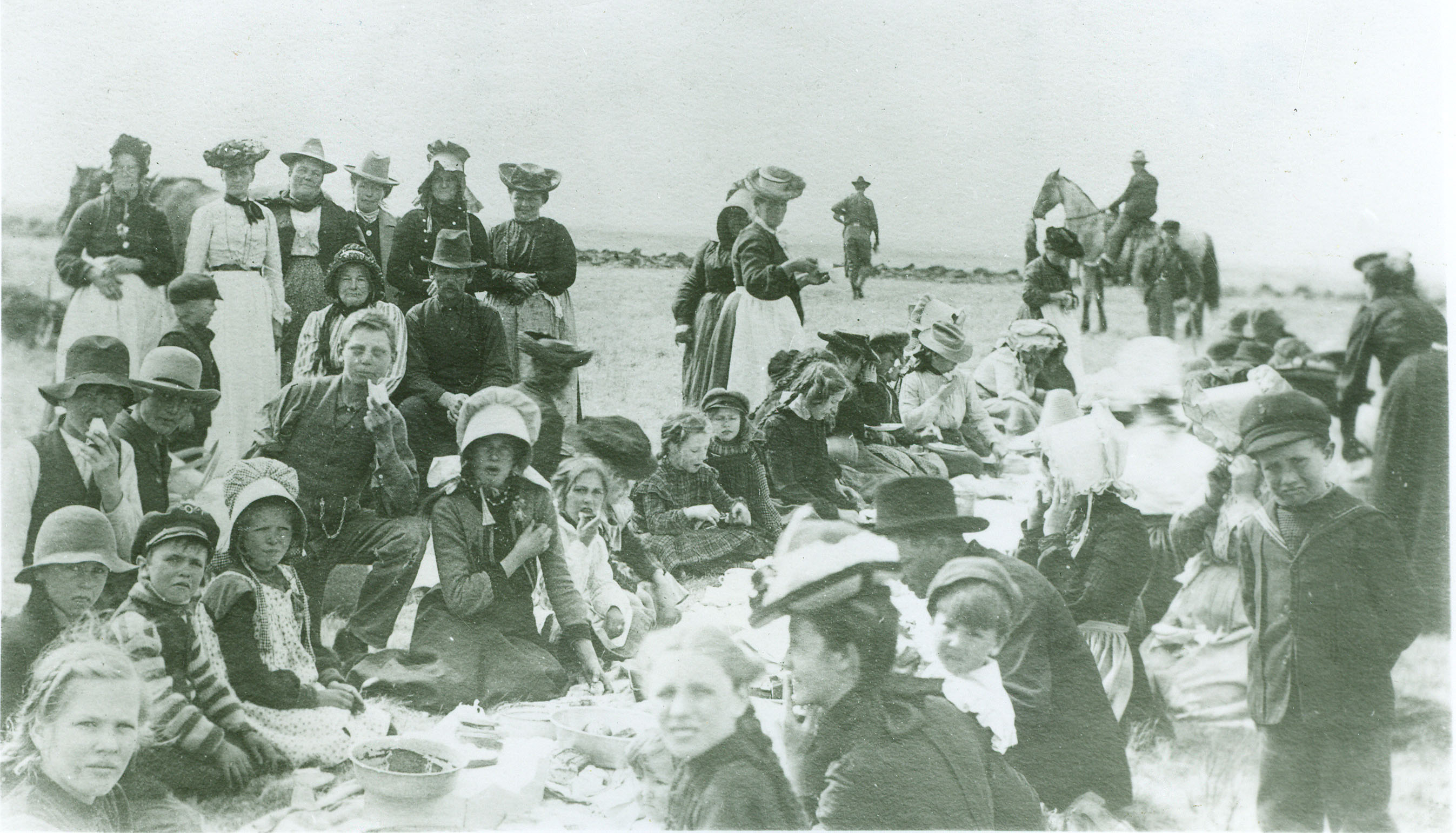 A picnic for members of the Magrath Ward during a workday at the missionary farm, 1903. Proceeds from the farm supported missionaries and missionary work. The first five missionaries from Magrath left that same year. Church farms in southern Alberta have been an important source of funds for Church building projects, ward budgets, and welfare needs. (Magrath Museum)
A picnic for members of the Magrath Ward during a workday at the missionary farm, 1903. Proceeds from the farm supported missionaries and missionary work. The first five missionaries from Magrath left that same year. Church farms in southern Alberta have been an important source of funds for Church building projects, ward budgets, and welfare needs. (Magrath Museum)
The Settlement of Raymond
The story behind the settlement of Raymond is a tale that captures the imagination. It is tied up in the fascinating life story of Jesse Knight, the dynamic personality of John W. Taylor, the expansion of southern Alberta irrigation, and the push for land development by Charles A. Magrath and Elliott Galt and their Alberta Irrigation Company. The story also centres on the promise of a southern Alberta sugar beet industry. Raymond was not established with the direct involvement of the First Presidency of the Church like Cardston, Magrath, and Stirling were. However, Apostle John W. Taylor played an important role in Raymond’s settlement, as did Jesse Knight’s response to a discourse by Church President Lorenzo Snow.
Sugar Beets in Southern Alberta
The idea of a sugar beet industry in Canada was probably first considered after a sugar-beet factory, built and operated with significant financial support from the Church, was opened in Lehi, Utah, in 1891. The rationale for Church involvement was to provide economic opportunities to Church members. Sugar beets were a cash crop for Utah farmers, and the factory employed Church members. As early as 1892, Apostle John W. Taylor suggested to Charles A. Magrath the idea of growing sugar beets in southern Alberta.[188] In October 1895, Charles Ora Card visited the sugar factory in Lehi and, according to his journal, “spent 2 or 3 hours in looking over the mammoth [institution] that works up about 150 tons of Beets per day & yield about 40000 lbs. sugar daily. Employ[s] 150 hands.”[189] Over the next few years the concept of a Canadian sugar beet industry germinated in the minds of Card, Taylor and Magrath. In 1900, Magrath purchased 50 lbs. of seed and distributed it among farmers in Magrath, Stirling and Lethbridge. A few of the beets grown were then sent to Utah for analysis, where they were found to be of excellent quality with very high sugar content.[190]
John W. Taylor was a fervent promoter of all things Canadian. According to C. A. Magrath, “he talked Alberta in season and out of season in the south country [Utah/
The Story of Jesse Knight
Jesse Knight was the son of Newell and Lydia Knight, who were prominent and faithful early Church members. Jesse was born in 1845 in Nauvoo, and his father died while the family was staying in Winter Quarters in the winter of 1846. His mother suffered many privations to raise her seven children, cross the plains, and establish a new life in Utah. The family was poor, and Jesse worked many jobs, from a young age, some of which put him in the company of rougher elements of society. At some point, he became disaffected with the Church. Though he married an active Church member, he remained aloof from the Church for many years. In 1887, his two-year-old daughter Jennie became deathly ill. Jesse’s wife begged for him to allow the elders to give her a blessing. The blessing was given and miraculously she was healed. Jesse knew he had seen the hand of God in healing little Jennie, and he began a process of repentance.
Once he became anchored in his faith, Jesse Knight focused his study from that time forward to try to make up for all the years he had been out of the Church. God saw fit to bless him with a tremendous capacity to do so. One day, while in the Godiva mountain area, Knight sat under a tree and heard a voice tell him, “This country is here for the Mormons.”[192] Jesse understood the voice to mean that that particular mountain contained mining wealth that would be used to bless the Latter-day Saints.
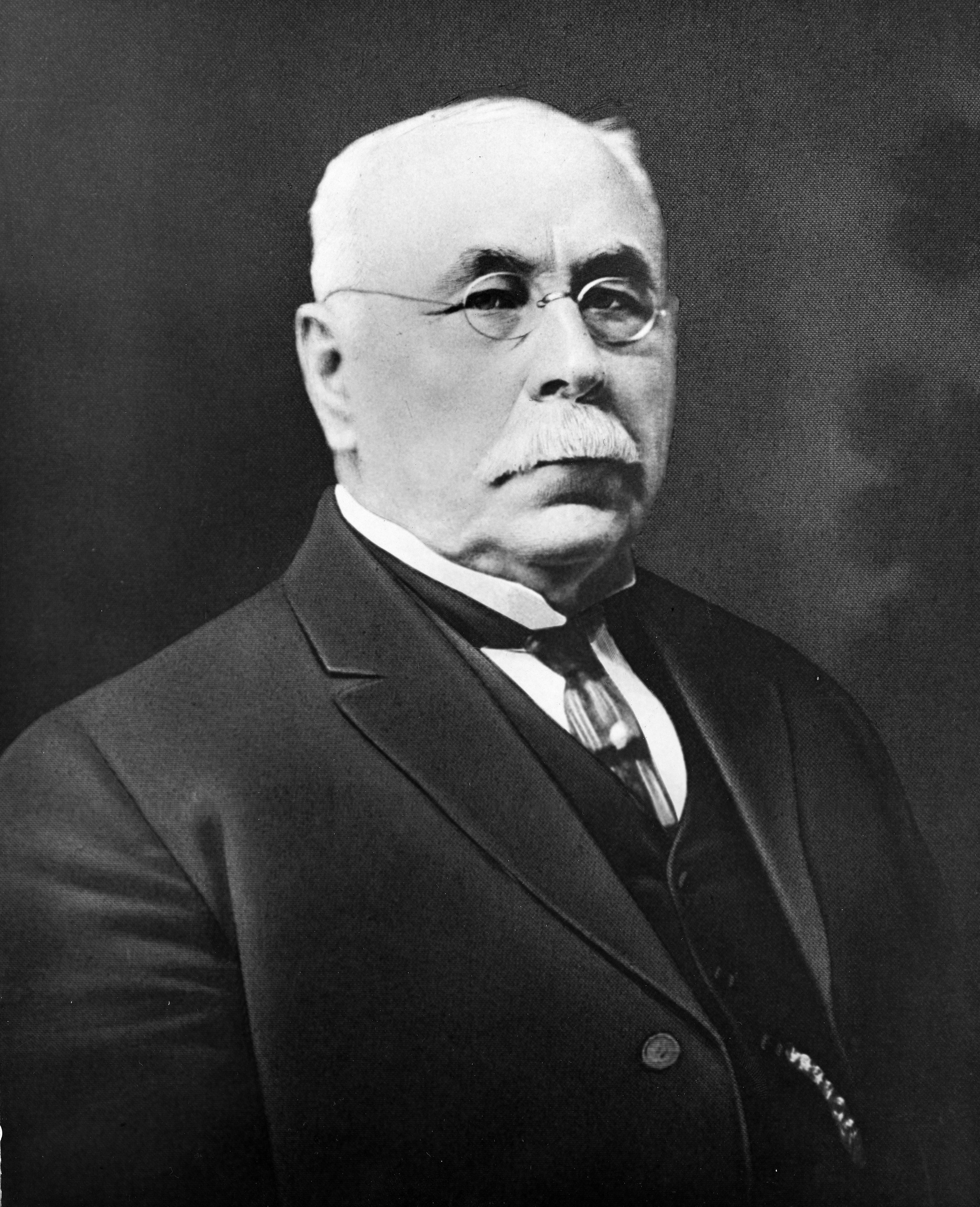 The town of Raymond owes its origin to the philanthropy of Jesse Knight, a Utah mining mogul whose greatest desire was to use his wealth to provide opportunities for Latter-day Saints to work and to flourish. (L. Tom Perry Special Collections, Photo Archives, Brigham Young University)
The town of Raymond owes its origin to the philanthropy of Jesse Knight, a Utah mining mogul whose greatest desire was to use his wealth to provide opportunities for Latter-day Saints to work and to flourish. (L. Tom Perry Special Collections, Photo Archives, Brigham Young University)
He began mining, and in 1896 at his Humbug mine, he found an incredibly massive and valuable deposit of precious metals. He bought up all the surrounding claims and, in the following years, extracted more than ten million dollars’ worth of ore.[193] He became one of the richest men in Utah, but he felt keenly that he had been led to that wealth by inspiration, that he was no more than a steward of the wealth, and that God intended it be used to help the Latter-day Saints. Knight became involved in many ventures which were usually as much philanthropic ventures as they were business enterprises.
Knight Family Investments in Canada
On 1 January 1901, Church President Lorenzo Snow delivered a “Greeting to the World,” in which he gave the following call to action:
Men and women of wealth, use your riches to give employment to the laborer! Take the idle from the crowded centers of population and place them on the untilled areas that await the hand of industry. Unlock your vaults, unloose your purses and embark in enterprises that will give work to the unemployed, and relieve the wretchedness that leads to the vice and crime which curse your great cities, and that poison the moral atmosphere around you. Make others happy, and you will be happy yourselves.[194]
This talk was so powerful to Knight that he carried a copy of it in his pocket for years afterward. It gave him direction on how to use his wealth to help members of the Church. A few days after the talk was given, as he walked down a street in Salt Lake City, Jesse Knight met John W. Taylor. Apostle Taylor greeted him, and, looking straight into Jesse’s eyes, he pointed his finger at Knight and declared, “Brother Knight, that talk was for you!! I know exactly where you need to go and build up industry and create employment and places where the saints can gather in safety and prosper in peace. The Lord needs you to go to Canada and create employment for the saints up there!” Taylor suggested building a sugar beet factory and settling a new community. The purchase of ranch land was also discussed. At first Knight thought the whole idea was “absurd,” especially the part about the sugar factory, but Taylor persisted, and, later in January 1901, he sent his sons, Ray and Will, to Canada to take a look at the land.[195] They were very impressed with what they saw in spite of the fact that it was in the middle of winter, and to Charles A. Magrath’s “utter amazement” they purchased thirty thousand acres of ranchland near Spring Coulee.[196]
Within a few months, Will and Ray Knight had stocked the ranch with four thousand head of cattle. Jesse had not yet come to Canada, but at the request of Apostle Taylor, he travelled to southern Alberta and arrived on 26 May 1901. He was met by Taylor and Jesse’s two sons. Together they travelled on horse and buggy across southern Alberta, looking at the vast country. Heavy rains that spring had left the countryside green and beautiful. Knight was duly impressed. Within two days he knew what he would do. He met with Charles A. Magrath on 28 May and began working out the terms to purchase 226,000 acres[197] of land at a reduced rate on condition of creating a town and building a sugar beet factory to be completed by 1903 and to operate for a minimum of twelve years. Knight also agreed to plough three thousand acres in the fall of 1901 to prepare for coming settlers and to pay $50,000 as an initial deposit and guarantee of good faith.[198]
 The town of Raymond was named after Raymond Knight, a son of Jesse Knight. Ray Knight was involved in establishing the Bar K2 Ranch, later purchased by the Church, and was a pioneer in Canadian rodeo. He is shown here receiving a rodeo award from the Prince of Wales in 1919. (Glenbow Archives NA-2117-5)
The town of Raymond was named after Raymond Knight, a son of Jesse Knight. Ray Knight was involved in establishing the Bar K2 Ranch, later purchased by the Church, and was a pioneer in Canadian rodeo. He is shown here receiving a rodeo award from the Prince of Wales in 1919. (Glenbow Archives NA-2117-5)
Emergence of the Town of Raymond
Jesse Knight decided the town would be named Raymond, after his son. The location for the settlement was to be halfway between Magrath and Stirling. With the irrigation canal and railway both running through the area, and a coulee available for drainage for the sugar factory, the site where Raymond now stands was considered ideal. On Sunday, 15 August 1901, with a crowd of 150 present, Charles Ora Card dedicated the site for the town.[199] In September, the first families arrived, and in November, the Raymond Ward was organized with Jesse’s son J. William Knight as its first bishop.[200]
Jesse Knight had big plans for the settlement. It would not just be an industrial and agricultural centre, but a religious and cultural hub with recreational opportunities. As with other Mormon agricultural villages, residents would live in town and farm the land outside the town. Owners would have to forfeit titles to land if they established businesses where alcohol was sold, gambling was permitted or prostitution practiced.[201] The town was laid out on a grid but with diagonal streets also radiating out from the centre of the town, in grand style like Paris. “Uncle Jesse,” as he was affectionately called, provided employment to the large numbers of settlers arriving. They were paid to plough the land, build the factory, and then work in the completed factory. The settlers were able to purchase land on easy terms with no payments for the first three years.[202] Knight also funded the building of a church that first year with a seating capacity of five hundred.
Creation of the Taylor Stake
With arable land still scarce in the American Intermountain West, the opportunities in Raymond, Alberta, were highly appealing. Settlers poured into the area, and within four years Raymond had a population of 1500, eclipsing the eighteen-year-old settlement in Cardston.[203] By 1903, there were 5,500 Mormons in Alberta—enough to merit the division of the Alberta Stake[204] to create the Taylor Stake, affectionately named after their beloved “resident Apostle,” John W. Taylor.[205] The Taylor Stake was organized in August 1903 with Heber S. Allen, formerly of Cardston, as president and Theodore Brandley and J. William Knight as counselors. Allen would serve as both a spiritual and temporal leader for the people of his stake for thirty-three years.[206] The stake, which was centred in Raymond, also included Magrath and Stirling and soon included wards in Welling, Taber, Barnwell, and Burdett. The stake had 3,243 members by the end of 1903.[207] Church President Joseph F. Smith presided at the conference[208] where the Taylor Stake was organized as the fifty-first stake of the Church.
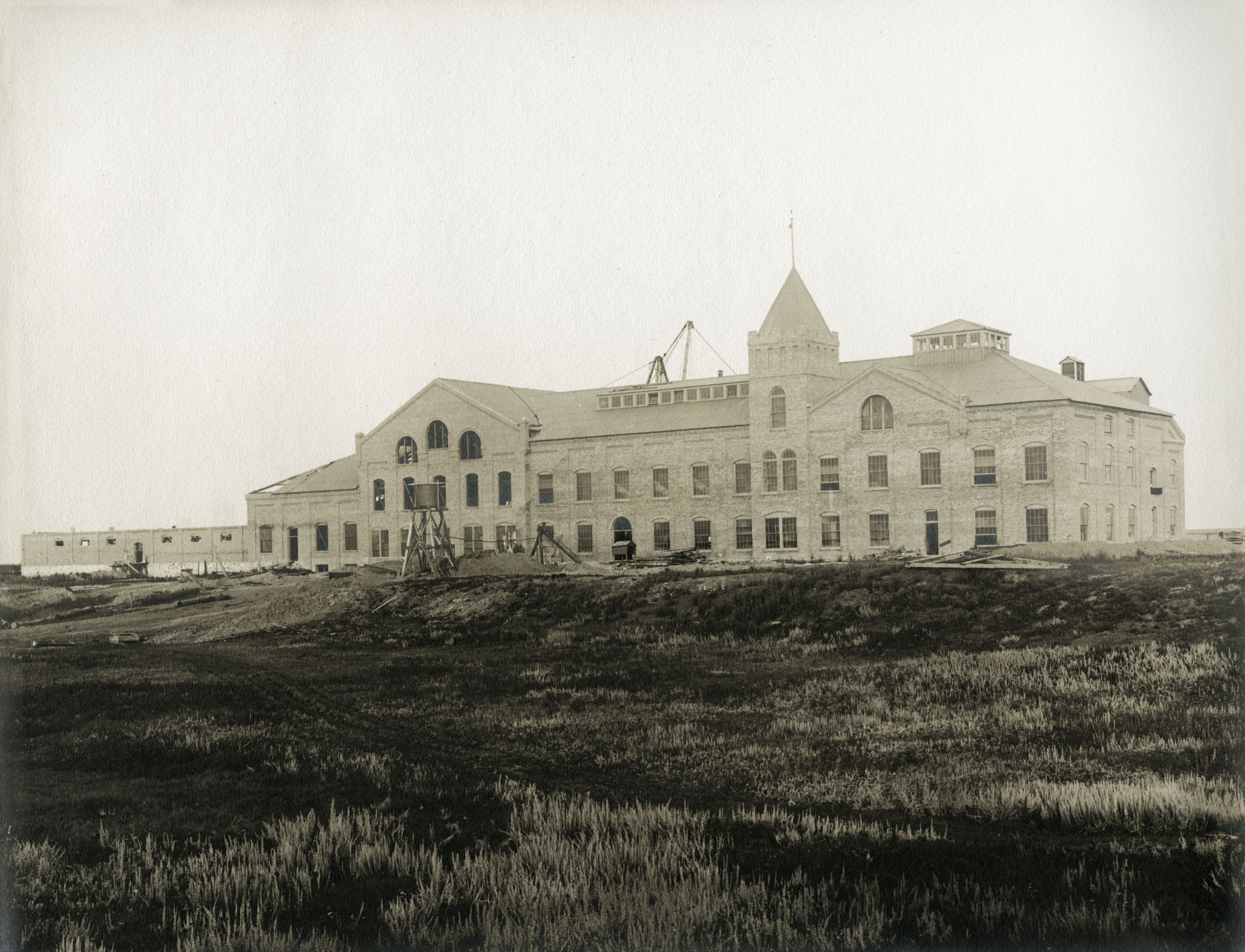 The Knight sugar factory in Raymond, July 1904. Jesse Knight introduced the sugar beet industry to Canada. (Glenbow Archives PD-310-82)
The Knight sugar factory in Raymond, July 1904. Jesse Knight introduced the sugar beet industry to Canada. (Glenbow Archives PD-310-82)
Early Raymond Industry
An incredible spirit of optimism pervaded the community of Raymond. Some predicted it would become the “Winnipeg of Alberta.” Knight persuaded successful entrepreneur Ephraim P. Ellison to come to Raymond to run the sugar factory. In a meeting with Knight and Church President Joseph F. Smith, Smith also encouraged Ellison to establish a flour mill, as the Saints at the time had to get their flour from Montana or Wyoming. Ellison agreed to both proposals and sealed the deal “with a handshake in the presence of the prophet of the Church.”[209] Like the sugar factory, the Ellison Milling and Elevator Company began operations in 1903. The mill was expanded to Magrath in 1906 and to Lethbridge in 1907, though operations by this point been had turned over to George W. Green, who also proved to be an able manager. By the mid-1920s, milling was centralized in Lethbridge, with elevators in several locations.
The sugar industry proved to be more challenging than wheat farming and milling. Operations began on schedule in 1903 and were very successful for the first five years, especially as farmers refined their cultivation methods and adapted to the Canadian climate.[210] Output increased and dividends were paid to shareholders.[211] However, in 1908, the British Columbia–based Rogers Sugar, a cane sugar refinery, began lowering its prices in an effort to put the Knight Sugar Company out of business.[212] Knight fought this by requesting a tariff on cane sugar. No tariffs were introduced, but taxes were waived for the Knight Sugar factory and a subsidy of fifty cents per hundred pounds of sugar was divided among farmers and the Knight factory.
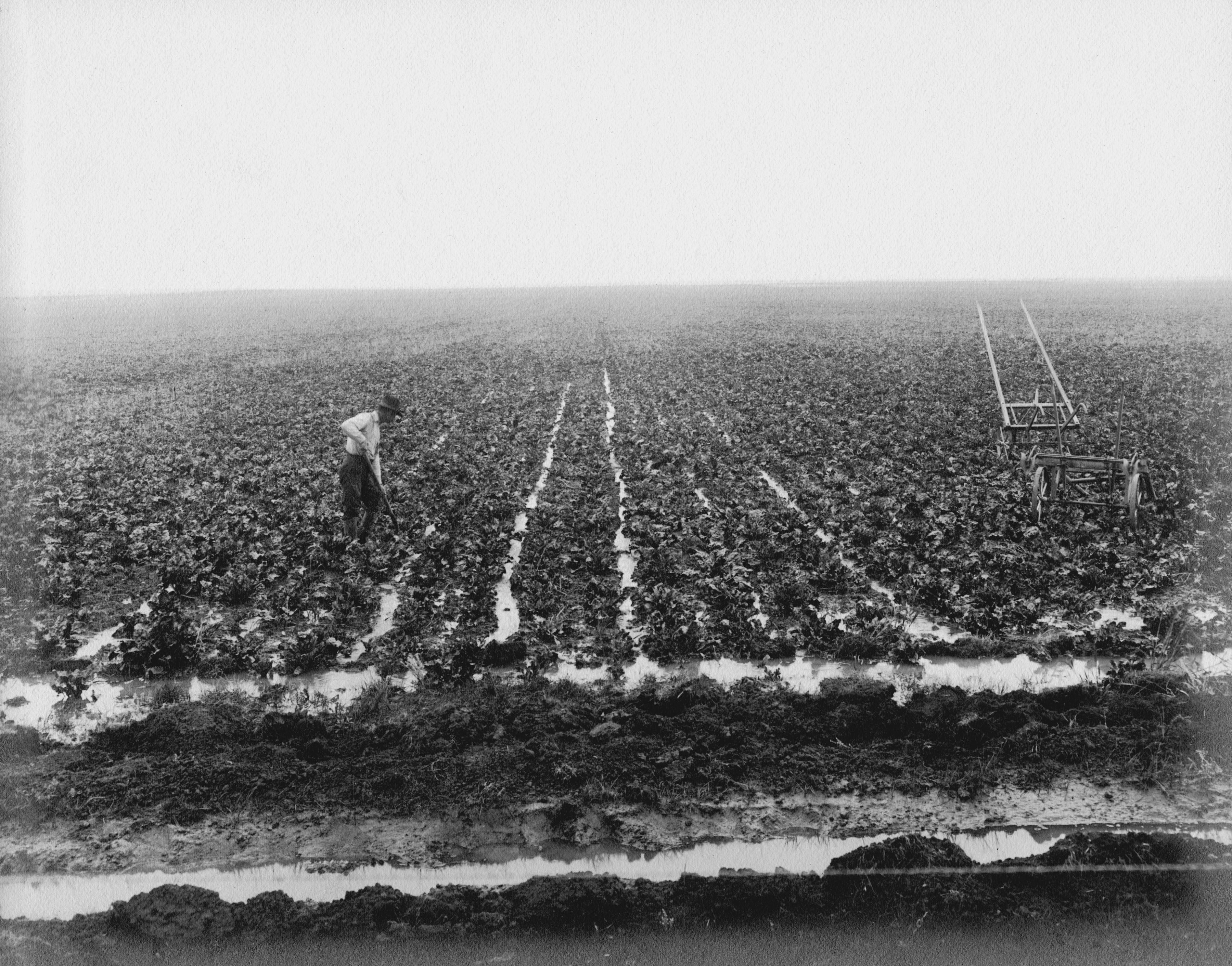 Flood irrigation of a sugar beet field in Raymond, 1904. Sugar beets were grown successfully on irrigated lands in southern Alberta, but they required intensive work. (Glenbow Archives PD-310-153)
Flood irrigation of a sugar beet field in Raymond, 1904. Sugar beets were grown successfully on irrigated lands in southern Alberta, but they required intensive work. (Glenbow Archives PD-310-153)
A greater threat to the industry was increasing reluctance of farmers to grow sugar beets. Since the cultivation of sugar beets was very labour-intensive, requiring hoeing, weeding, thinning, digging, topping, and loading by hand, many farmers found that they preferred to grow grain. This was especially true because grain prices were high during this period. Many desperate pleas from the factory to increase sugar beet cultivation seemed to fall on deaf ears. The company began cultivating beets on its own property, bringing in workers from First Nations Reserves, mostly from the Blood Reserve, but some coming from further away, from China, Japan and Belgium to provide the labour.[213] Most of the workers in this period were contracted for seasonal work and did not stay in southern Alberta. However, enough Japanese settled in Raymond that a Japanese Society was organized in 1914, and many Belgian immigrant families resided on one street in Raymond known as “Belgian Row.”[214]
Ultimately, only a small fraction of the beets needed for the factory were grown locally, and huge shipments of beets were imported from Europe as late as 1914. After World War I began, this foreign supply dried up, and it became impossible to keep the factory open any longer. The year 1915 was supposed to be the final year of operation, according to the terms of the deal with Jesse Knight. However, operations had already ceased. The factory was meant to be dismantled and rebuilt in Layton, Utah, when the CPR, which then owned the contract once signed by the Alberta Railway and Coal Company, obtained an injunction preventing the dismantling. A completely new factory was built in Layton, Utah, and the Knight Sugar Factory was dismantled after the injunction was lifted.[215] This was not the end of sugar beet cultivation in southern Alberta or in Raymond, however. Having learned from early mistakes, investors built a second, more successful factory which began operations in Raymond in 1925, and the sugar beet industry later expanded to Picture Butte and Taber, where a modern factory operates today.
Other businesses opened their doors in Raymond in its early years, including an automobile dealership, bakeries, banks, barbershops, brickyards, a dairy, stores, a butcher shop, pharmacy, lumberyard, and more. In addition to industry and business, sports, rodeo, and musical and dramatic arts quickly became focal points of the community (see chapter 6), with perhaps Raymond’s most ambitious project being the building of an opera house in 1909. Raymond became home to a regional LDS secondary school—the Knight Academy—which was operated by the Church from 1910 to 1921.[216]
Some may argue that the Knight sugar factory was not a successful venture, but that would only be true in terms of business profitability. As a settlement agent, a means of providing employment, homes, and farms for many Latter-day Saints, and the impetus for the establishment of a Latter-day Saint community with a proud and lasting history, Jesse Knight’s factory was a resounding success. One hundred years after the factory was dismantled, the community continues strong and faithful, its contribution to the Church in Canada and throughout the world incalculable. It is one of Jesse Knight’s most enduring legacies. Charles A. Magrath was so grateful for the role that Jesse Knight played in solidifying southern Alberta that he wrote the following:
My opinion is that Southern Alberta should never forget what it owes to Jesse Knight, because I happen to know from actual efforts, how impossible it was to get capital interest in such an enterprise in a new and sparsely settled country like our northwest until Mr. Knight came along. I question if there would be a sugar beet grown in Alberta today if it were not for Jesse Knight and the good will that existed between his Church leaders and our Irrigation Company.[217]
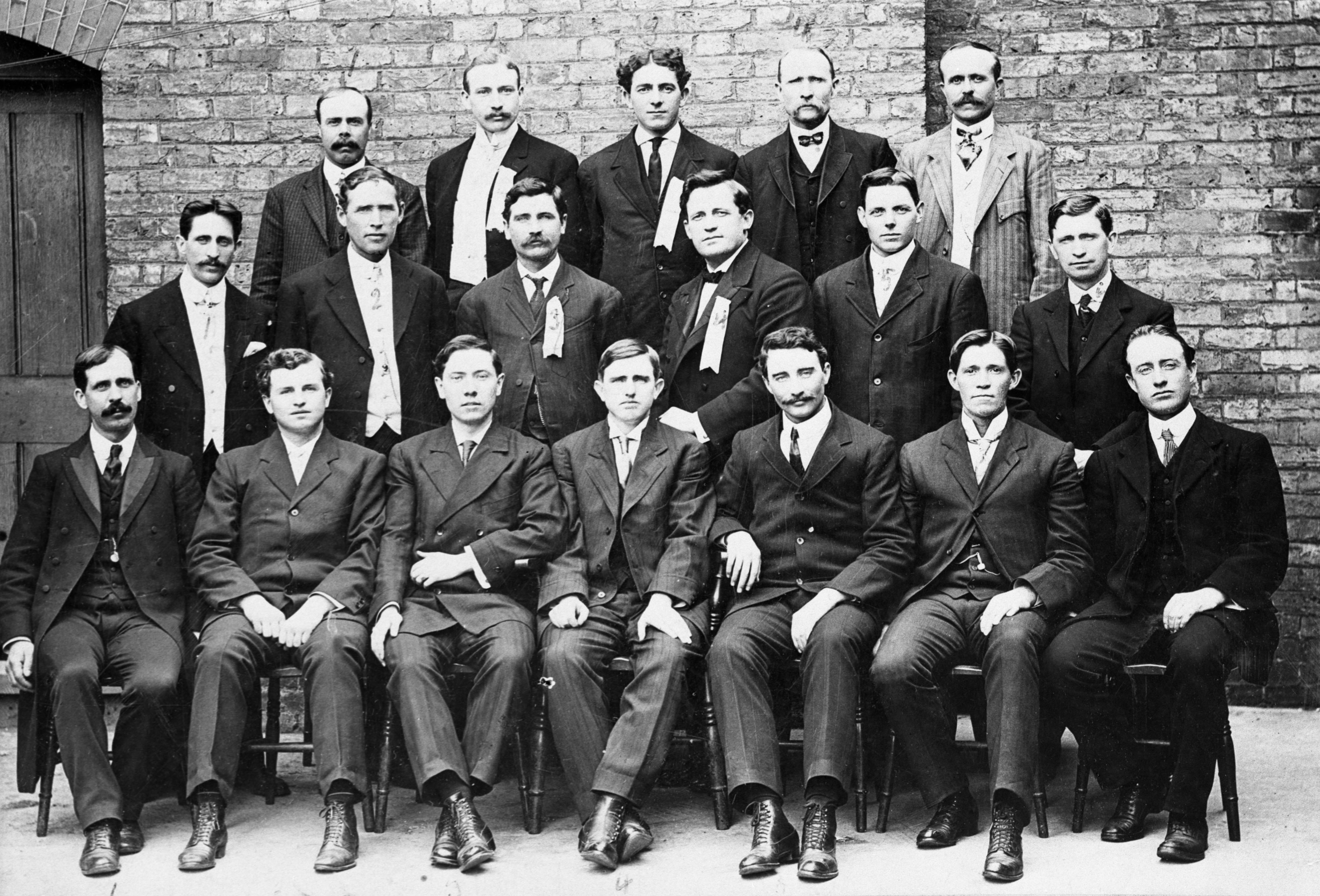 Southern Alberta Latter-day Saint missionaries in Britain, 1908. Front row, left to right: William Duce, Delsel Salmon, Spencer Young, William Card, Henry C. King, James Turner, and W. Wynder; middle row, left to right: Scott Brown, Loron Little, John Layne, Walter H. Caldwell, Fay Hatch, and Charles W. Burt; back row, left to right: J. Y. Card, William B. Woolford, William A. Glen, and John B. Merrill. The establishment of strong LDS settlements in southern Alberta contributed to the Church’s missionary program. (Glenbow Archives NA-143-15)
Southern Alberta Latter-day Saint missionaries in Britain, 1908. Front row, left to right: William Duce, Delsel Salmon, Spencer Young, William Card, Henry C. King, James Turner, and W. Wynder; middle row, left to right: Scott Brown, Loron Little, John Layne, Walter H. Caldwell, Fay Hatch, and Charles W. Burt; back row, left to right: J. Y. Card, William B. Woolford, William A. Glen, and John B. Merrill. The establishment of strong LDS settlements in southern Alberta contributed to the Church’s missionary program. (Glenbow Archives NA-143-15)
Geographic Expansion and Population Growth After 1901
In the early 1900s, settlers from the United States, Eastern Europe, and elsewhere began to flood into the Canadian prairies, as Clifford Sifton’s aggressive immigration campaign began to yield results. A significant number of these immigrants in southern Alberta were Mormons, but the majority were not. Thus, the settlement pattern after 1901 typically involved Mormons settling alongside non-Mormons.
Southern Alberta experienced a drought in the 1890s, which was an important impetus to the building of the St. Mary irrigation project. This project brought large numbers of Mormon immigrants to Canada. However, as soon as canal construction was underway, southern Alberta experienced several very wet years. While some Mormon immigrants between 1900 and 1910 settled on irrigated land in the new Mormon settlements, the Alberta Irrigation Company did not sell nearly as much land as hoped.[218] Irrigated land cost money and homestead land was free. Since there appeared to be adequate rainfall, homestead land became quite appealing. The timing of these dry-then-wet years ensured maximum immigration and the widest spread of Mormon settlers across southern Alberta. Had the drought continued, perhaps the Mormons would have remained clustered in communities along the canal. As it was, many LDS settlers arrived either in groups or as individuals and settled on homestead land across southern Alberta, with some moving north of Calgary as well. An example of a turn-of-the-century LDS community settlement is Caldwell, northwest of Cardston. Here, in 1898, David Henry Caldwell emigrated from Tooele County, Utah, in 1898, bringing twelve of his fourteen adult children with him.[219] Similarly, in 1901, six families from Idaho settled Orton, just outside Fort Macleod.[220]
The first people to take out homesteads on the land that became Taber were the Latter-day Saint Hull brothers from Hooper, Utah, who arrived in 1903, choosing the location because of the fine, level land and the proximity to “Tank 77,” a water tank along the Lethbridge-to-Dunmore rail line.[221] Jim Hull surveyed his homestead into lots, in a pattern similar to other Mormon agricultural villages. These lots became the town of Taber. Most of the first settlers in Taber were LDS, and the full church program was available to its faithful members, many of whom lived in the town (at least in winter) and farmed the surrounding lands.[222] A ward was formed in 1904.[223] The first LDS church buildings in Taber doubled as schools.[224] The community of Taber grew quickly and attracted LDS and non-LDS settlers alike. While the Church continued to grow, Mormons became the minority in that community.[225]
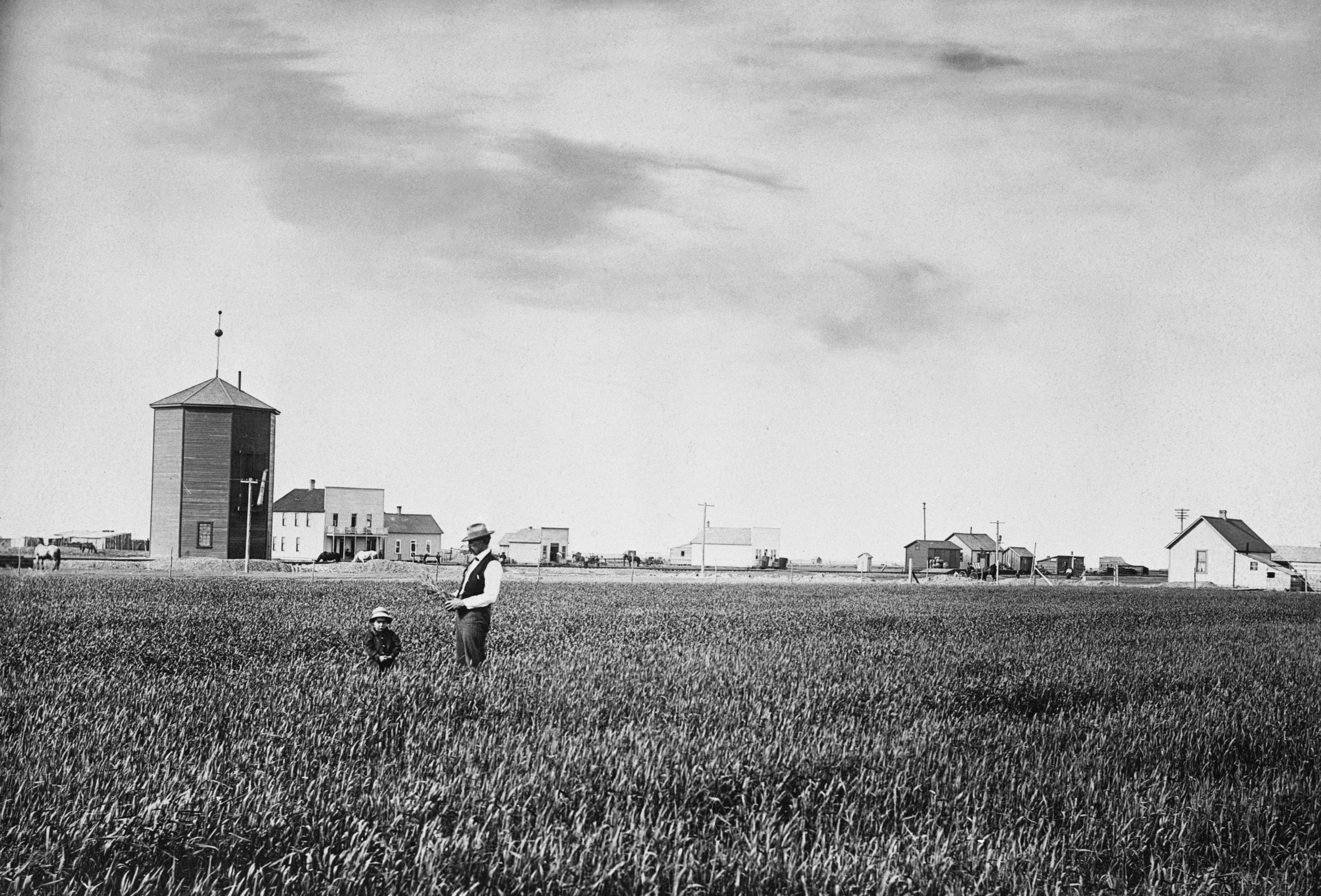 The Hull brothers were the first to homestead in the Taber area in 1903. Jim Hull’s homestead became the townsite. In this photo, he is shown in a grain field with the young town in the background, ca. 1910. (Glenbow Archives NA-432-6)
The Hull brothers were the first to homestead in the Taber area in 1903. Jim Hull’s homestead became the townsite. In this photo, he is shown in a grain field with the young town in the background, ca. 1910. (Glenbow Archives NA-432-6)
Just a few miles west of Taber, another group of LDS men, including Petersons, Johnsons, Andersons, and Edwardses who had been living in Raymond, became the first homesteaders in the Barnwell area, originally called Bountiful and Leonard, in 1903. In Barnwell, most of the men worked their land and built the required homes to “prove up” on their homesteads during six months of the year, and returned to be with their families in Raymond during the winter months. The families joined them once they were more established.[226] A ward was established in 1908, and the full Church program was available.[227] Barnwell remains a predominantly LDS community.[228] After some years of hardship, mostly from a shortage of water, cooperatives, known as irrigation districts, organized by farmers, finally succeeded in getting the irrigation system expanded to the Taber and Barnwell districts in 1921.[229] These areas have been highly productive farmland ever since.
A few Latter-day Saints also settled further east in the Grassy Lake, Purple Spring, Rosemary, and Burdett Districts. Some filled in the land closer to the existing Mormon settlements in the communities such as Welling, Wrentham, Milk River, and Coutts, while others settled on homesteads to the north, near communities like Claresholm, Starline, Frankburg, Stavely, Pine Coulee, Gleichen, and Champion.
One of the challenging tasks for Church leaders was to find these members of the Church scattered throughout southern Alberta and beyond and to organize them into Church units and help them establish as much of the Church program as they could under their varying circumstances. In some cases, where members were very scattered, it was challenging to gather for Church meetings and to run Church programs. Automobile transportation was in its infancy, and roads were poor or nonexistent. Thus, a distance of even a few miles from other Church members or from the meetinghouse could make full activity in the Church very difficult.
Nevertheless, between 1904 and 1923, wards or branches were organized in Del Bonita, Woolford, Orton, Welling, Taber, Barnwell, Orion/
The Alberta Stake under the Direction of Edward James Wood
Edward James Wood became the dominant spiritual figure in the Alberta Stake beginning in the early twentieth century. After being raised in Utah and serving as a young missionary and then as a mission president in Samoa, thirty-five-year-old Wood moved his young family to southern Alberta in late 1901.[233] His arrival in southern Alberta coincided with a decline in the health of Charles Ora Card. Card was released as stake president in 1901 and returned to Utah to be with his families in 1903. He died in 1906. Wood’s tremendous capacities, both spiritual and practical, were immediately recognized when he arrived in Cardston. In less than two years, he began his thirty-nine-year service as president of the Alberta Stake. Wood was to be Card’s successor as the spiritual and temporal leader of the Alberta settlement of Latter-day Saints.
 Edward J. Wood served as president of the Alberta Stake from 1903 to 1942, as president of the Alberta Temple from 1923 to 1948, and as an important community and business leader. (Courtesy of Joyce Steed)
Edward J. Wood served as president of the Alberta Stake from 1903 to 1942, as president of the Alberta Temple from 1923 to 1948, and as an important community and business leader. (Courtesy of Joyce Steed)
Wood seemed larger than life. He “was known far and wide as a man who honored his appointments at all costs.”[234] He risked his life travelling through blizzards, severe cold, and other extreme weather to be at ward conferences or attend to other duties. Once, in 1911, after he kept appointments to review the tithing accounts of four wards, travelling in an open sleigh in temperatures of – 40˚ F, he wrote, “I am glad we went. We took no harm and the example may do others good.”[235] He visited all the northern units twice a year without fail during the seventeen years they were in his stake.[236] He was beloved by the people he visited, providing both spiritual and temporal assistance. Once on a visit to Orton in 1908, Wood sympathized with the settlers having to haul water from miles away for their families and animals. While with them, he was inspired to tell them where to dig a well. They dug in the spot indicated and soon had a good well near their homes.[237]
Wood was unfailingly optimistic about Canada and energetically encouraged the Saints to stay in Canada despite hard times and homesickness. The confidence the people had in their leader inspired many to persevere through tough times.[238] He was legendary for his prophetic powers. His counsel, along with fasting and prayer, was, for many Saints, the key to salvaging their crops when the weather was bad. In June 1921, he asked the members to fast and pray for rain, and in his journal he recorded that “it will surely rain upon our crops.”[239] Three inches of rain came that very week.[240] Other times, he predicted that needed moisture would not come, and he strengthened the Saints by reminding them that they were spared from worse calamities, such as the carnage of World War I, and by helping them to see that when they were less prosperous, they became more reliant on the Lord.[241] Sometimes he told the Saints which crops to plant and when to sell them. His counsel was so profitable that several nonmembers attended priesthood meetings to inform their crop decisions.[242] Wood also enjoyed the gift of healing[243] and had visits and communications from beyond the veil.[244]
Outmigration and Those Who Returned to the United States
The story of the cutworm miracle refers to settlers who were discouraged and considered returning to the United States, as well as those who came to Canada to make money with the expectation of later returning home to Utah. While the population of Mormons in southern Alberta steadily increased throughout the time period in this chapter, there are incidents and anecdotes and personal and family histories that suggest that many did in fact go back to the United States while others needed encouragement to stay. What percentage of settlers stayed in Canada is not known.
The Purchase of the Cochrane Ranch and the Establishment of Glenwood, Hill Spring, and Hartley
President Wood was every bit as effective as a temporal leader as he was a spiritual leader. He supervised the construction of the Cardston Tabernacle, which was completed in 1911 and which soon became the centre of religious and cultural life in Cardston.[247] Early in the twentieth century, he observed the difficulty some of the far-flung and isolated members faced. He was anxious to provide colonization opportunities for Church members to live in LDS communities with the advantages of the full Church program. Hence, when the sixty-five-thousand-acre Cochrane Ranch northwest of Cardston went up for sale, President Wood spearheaded negotiations between the Church and ranch owners to purchase the land for colonization. This was likely the land Charles Ora Card had originally dedicated for the settlement of the Saints during his exploration mission in 1886. Altogether, the Cochrane Ranch land was a strip of land six to eight miles wide and twenty-eight miles long between the Waterton and Belly Rivers. The land was purchased in 1905, and by 1909, it had been surveyed for irrigation, and the Cochrane cattle had been removed. Meanwhile, three townsites, Glenwood, Hill Spring, and Hartley, were established, and families began arriving. Wood himself established one of the first farms in Glenwood. Land on the western part of the Cochrane Ranch was used as a Church cattle ranch.
 E. J. Wood took great pride in his Glenwood farm and modelled diversified farming for the Saints. (Glenbow Archives NB-3-21)
E. J. Wood took great pride in his Glenwood farm and modelled diversified farming for the Saints. (Glenbow Archives NB-3-21)
The settlements were meant to be become strong wards of the Church. Lands were only sold to faithful Latter-day Saints, and the Church reserved the right to resell the land when owners moved away.[248] The first several years after the settlements were established were difficult for the new farmers in the area. In addition to the necessary pioneering, they suffered from dry seasons and damaging frosts. Throughout these times of hardship, Wood provided spiritual and temporal counsel. Those who followed his advice weathered the various storms. A canal, begun in 1921 and completed in 1923, provided irrigation water to the area, and thereafter the settlements’ prospects improved.[249] Wood worked with others to establish industries in the Glenwood area, including a creamery, butcher business, and a packing plant.[250] The communities of Glenwood and Hill Spring each have maintained a population of two to three hundred residents for over a century, while Hartley is smaller. Though small, these tight-knit communities have been a source of strength to the entire Church. Ardeth Greene Kapp, former Young Women General President who grew up in Glenwood, tells of a time when she was on Church assignment in Hong Kong with two other General Authorities, both also from Glenwood. When Hong Kong Church leaders observed this coincidence, they were astounded to find out this was a hamlet of just 250 people.
Church units were established in the communities on the former Cochrane Ranch as soon as there were enough settlers. Wards were established at Glenwood in 1909 and Hill Spring in 1910.[251] There was a branch in Hartley from 1928 to 1937 and a ward from 1937, until declining population and improved transportation resulted in it being discontinued and combined with the Glenwood and Hill Spring wards in 1962.[252]
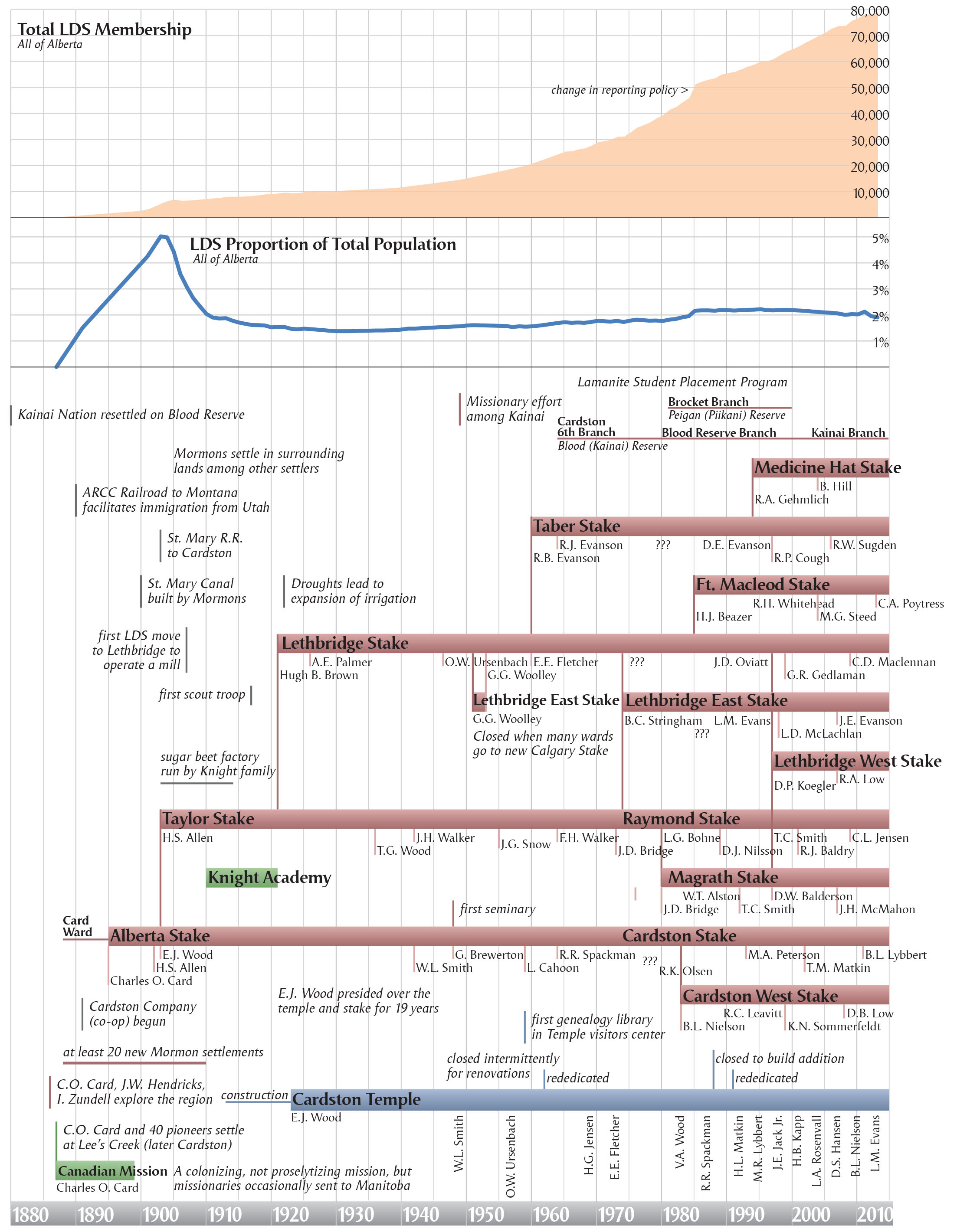
Pioneering the Church in Lethbridge
It is significant that Lethbridge was the first place in Canada where Latter-day Saints made their permanent homes in an existing community where they were in the minority. Many of the early experiences of the Lethbridge Saints—such as meeting sporadically at first and then meeting in homes and rented buildings, encountering prejudice and hostility from the community, fund-raising for buildings, and reaching out to the community—have been mirrored time and again as the Church became established in communities all across Canada throughout the twentieth century. However, in the case of Lethbridge, Latter-day Saints first came when Lethbridge was barely twenty years old and had only 2,100 residents. Thus, Latter-day Saints have been an important part of the fabric of that city through most of its history.
The first known members of the Church to reside in Lethbridge were men from Magrath and Stirling who went to Lethbridge to work in the coal mines in the winters of 1899 and 1900 to supplement their incomes.[253] At least four members of the John Steele family from Magrath, as well as members of the Jack Bridge family, also from Magrath, are among those known to have gone.[254]
Charles A. Magrath was the first mayor of Lethbridge and was a leading citizen and community builder. He recognized the expertise LDS settlers brought with them from Utah and was eager to partner with or otherwise encourage Mormons with needed skills to aid in the industrialization and growth of Lethbridge. C. A. Magrath’s encouragement led to several LDS families moving to Lethbridge in the early 1900s and playing key roles in the progress of the community. Among the first to do so were John Silver, who partnered with Magrath in the Lethbridge Iron Works, and Emil Weed, who was an employee.[255] Magrath offered incentives for Ephraim P. Ellison of the Raymond Flour Mill to expand to set up a mill in Lethbridge, which was named the Ellison Milling and Elevator Company at Magrath’s suggestion.[256] About twenty LDS men worked in the construction of the mill,[257] beginning in 1907, and over time, several other strong members of the Church moved to Lethbridge to work in the mill, including George W. Green, Lethbridge’s second bishop and member of its first stake presidency.[258] The mill was important to the Church in Lethbridge, as it loaned the Church money for the first meetinghouse and its employees were often allowed to give Church service while on company time.[259] Even baptisms were held on mill property in a hole they dug out.[260]
Other families moved to Lethbridge for employment, including the Robert J. Gordon family, who arrived in 1907. Gordon was a civil engineer from Utah who had worked on surveying the canal. Magrath influenced him to stay in Canada and arranged for him to become a Dominion Land Surveyor. He eventually became the district surveyor and engineer for southern Alberta and helped survey the High Level Bridge for the CPR. This bridge is considered a monumental engineering accomplishment for its time and is still the longest and highest trestle bridge in the world.[261]
In 1909, a branch was organized in Lethbridge, with average attendance of about eighteen, but illnesses and other factors reduced the numbers such that by 1910, only a Sunday School was being held. However, new families moved in and the Church began to grow in 1912. Now too big for homes, the branch met in a series of rented buildings. On 19 May 1912, with only about fifty members, the Lethbridge Ward of the Taylor Stake was organized with Brigham S. Young, grandson of Church President Brigham Young, as bishop. Stake President Heber S. Allen charged them with the task of constructing a building, leaving to Bishop Young the problem of how to accomplish such a formidable task. Plans were made for a unique Greek-style building. By 1913, the First Presidency had committed to pay $3,000 if the local Saints raised the remaining $1,500. In the end, the building cost over $11,000 of which the Church paid $5,000. Members undertook several fundraising projects. One member, John Revill, a convert, participated in a contest sponsored by the Lethbridge Herald. Whoever was able to get the most subscriptions to their paper would win $1,200. Revill travelled among all the LDS settlements in southern Alberta getting subscriptions. He won the contest and donated the money to the building project.[262] In 1914, after only five months of construction, the Saints began holding meetings in the basement. World War I slowed construction, but by mid-1918 meetings for nearly 150 Saints were held upstairs. The building was dedicated in 1923.
 This photo shows the Lethbridge Ward Sunday School ca. 1920 outside its beautiful Greek-style brick building. Though the building is no longer owned by the Church, it still stands today. (Glenbow Archives NA-3702-10)
This photo shows the Lethbridge Ward Sunday School ca. 1920 outside its beautiful Greek-style brick building. Though the building is no longer owned by the Church, it still stands today. (Glenbow Archives NA-3702-10)
In 1921, Lethbridge had grown to eleven thousand, of whom five hundred were LDS. On 10 November 1921, Rudger Clawson of the Council of the Twelve presided at the meeting where the Lethbridge Stake (eighty-fourth in the Church) was organized, with Hugh B. Brown, who had recently moved to Lethbridge, as its first president and George W. Green and Asael Palmer as counselors. Though the stake was centred in Lethbridge, there was only one ward in the city and the vast majority of the stake’s membership lived in wards and branches in farming communities outside the city, including Claresholm, Taber, Barnwell, Frankburg, Pine Coulee, Star Line, Gleichen, and Orton. There was also a branch in Calgary. The stake boundary on the south was a line about where the Lethbridge airport is currently located; the western and eastern boundaries were the British Columbia and Saskatchewan borders; and the north boundary was the North Pole. In 1941, when the Western Canadian Mission, headquartered in Edmonton, was formed, the boundaries were reduced.[263]
World War I and Latter-day Saints in Southern Alberta
Tensions were building in Europe from the early 1900s, and war seemed inevitable. As a result, in 1909, Canada began to train a militia, encouraging young men to spend a few weeks each year in military training. The government sent a recruiter to the Mormon settlements in southern Alberta. However, according to Hugh B. Brown’s account, the recruiter’s cockiness and general demeanor made him “in every way the kind of a man our young men would not wish to follow.”[264] He was completely unsuccessful in recruiting LDS men to the militia. Unfortunately, after the recruiter returned to Ottawa, a report soon circulated that the Mormons were not loyal Canadians and should be expelled.[265]
The Member of Parliament assigned to southern Alberta, W. A. Buchanan, understood and was friendly to the Church, though he was not LDS himself. He disputed the report and suggested that if the Mormons would be recruited by one of their own, they would serve. Soon thereafter, President E. J. Wood called Hugh B. Brown on a mission “to go to Calgary and train as an officer in the Canadian army.”[266] Wood had handpicked Brown to be the one to rally the Saints to military service. Brown trained every summer and was very successful, despite being singled out and criticized for living the Word of Wisdom. He was promoted to captain and later to major. Other select LDS men also trained as officers.[267]
Brown was appointed to lead the C Squadron of the Twenty-Third Alberta Rangers, a cavalry squadron. He was to recruit from among the Mormon settlements, and he gathered more than two hundred recruits by doing so.[268] The C Squadron was a well-trained force which achieved many honours prior to the war. However, the whole squadron had to be retrained as infantry after trench warfare made cavalry units obsolete. Eventually, small groups of infantry from the squadron entered the front lines during the battle of Vimy Ridge as replacements for the B Squadron, which had experienced massive casualties. As a result of some jealousies and intrigue on the part of Brown’s superiors, he was not given the opportunity to lead his men in battle but was sent back to Canada to recruit. This was a bitter disappointment to Brown and is the setting of the story of the currant bush, which has become famous in the Church. In this story, the blessings of adversity and divine guidance in our lives are extolled.[269]
In contrast to the poor support for the first recruiter, the Mormon communities of southern Alberta settlements ultimately had high rates of participation in the war. For example, Raymond had ninety-eight servicemen, of whom ten were killed.[270] In Magrath, six of sixty servicemen never returned.[271] Not all the servicemen were part of the C Squadron. Others participated in the air force, or in other units.
The Saints on the home-front did their part to support the war effort as well. For example, in the Alberta Stake, a quota of $100,000 was requested for the Victory Loan Drive. The stake ended up raising $160,000.[272] Apart from the tragic loss of life, the years during World War I were a prosperous time in southern Alberta. Bumper crops and a high price of grain strengthened the economy in southern Alberta and its importance to the country.[273]
Announcement, Construction, and Dedication of the Cardston Alberta Temple
In 1912, there were 7,500 Saints in two stakes in southern Alberta.[274] The Alberta settlement was securely established and growing numerically and spiritually. This faithful group of Saints, nonetheless, did not have local access to temple blessings. In 1901, Joseph F. Smith remarked in general conference, “I foresee the necessity arising for other temples or places consecrated to the Lord for the performance of the ordinances of God’s house, so that people may have the benefit of the House of the Lord without having to travel hundreds of miles for that purpose.”[275] Church leaders who often visited Canada were conscious of the faithfulness of the Saints and their need for a temple. Still, the Canadian Saints were stunned and electrified by President Joseph F. Smith’s announcement in the October 1912 general conference that a temple would be built in Canada.
The exact location of the temple had not yet been determined by the First Presidency, so the Taylor and Alberta Stakes were asked to submit proposals for the site. Despite earlier prophecies regarding the construction of a temple in Cardston, the Saints in Raymond hoped the temple would be built in their community.
A Salt Lake City newspaper at that time recorded:
There is a keen rivalry between these two places [Cardston and Raymond] for the temple. Each has reserved its most beautiful and commanding site for the edifice and both are making every effort to secure it. Cardston is located in a rolling country near the eastern foothills of the Rocky Mountains, and the site which it has reserved is on a hill which rises in the centre of the town to a height above that of any other part of the immediate surroundings. Raymond is situated further to the east in the midst of a broad plain, with no mountains for many miles. But at the foot of the main street of the city a conspicuous knoll rises above the town and above the surrounding plain, overlooking the country for a great distance. This knoll has been set apart from the beginning of the settlement as a future temple site and has been locally called Temple Hill. Cardston is the oldest “Mormon” settlement in Alberta, and probably has a greater population than Raymond. The Church academy is located at the latter place, which is also the site of the sugar factory. The first Presidency and the council of the twelve will in due time give the final decision as to which place secures the site for the proposed structure.[276]
The two stakes submitted photos of proposed sites to leaders of the Church in Salt Lake, and in early 1913, Church leaders announced that they had decided to build the temple in Cardston on the exact site that Apostle John W. Taylor prophesied it would be twenty-five years earlier. Soon after the site was selected, E. J. Wood, president of the Alberta Stake, was appointed to be chairman of the Temple Building Committee with President Heber S. Allen of the Taylor Stake as one of the committee members. William Baxter was appointed to be the supervisor of construction.[277]
The architecture of the Cardston temple was both innovative and majestic. The First Presidency invited several architects to submit designs to the Presiding Bishopric. In the instructions to architects, the Presiding Bishopric departed from tradition and indicated that towers were not an essential element in the design. The winning design was by architect Harold Burton and engineer Hyrum Pope from Salt Lake, who were heavily influenced by the famous American architect Frank Lloyd Wright.[278] They designed the temple in the octagonal shape of a Maltese cross, thirty-six metres square with a three-metre-high granite retaining wall surrounding the entire building. Joseph Young Card described the temple as having “Grecian massiveness” and “A Peruvian touch” as well as being “similar only to the ancient temples of the Aztecs.”[279] The designs of the Hawaii and Arizona Temples were influenced by the design of the Cardston Temple.[280]
To say that initial estimates of the cost and timeframe for building the temple proved to be low would be an understatement. Bishop David A. Smith of the Presiding Bishopric estimated that the building would be complete in one year. Initial cost estimates were $50,000, revised to $150,000 once the drawings were done.[281] When construction was ready to begin, President Joseph F. Smith insisted on altering the original plan to build the temple out of concrete. He preferred granite for this temple at the base of the Rocky Mountains. He later insisted that the retaining wall also be made of granite. These changes catapulted the temple cost and greatly extended the time frame for completion.[282] Bishop Smith also recounted how whenever President Wood approached the First Presidency about increased expense for the temple, including for woodwork, artwork, and furnishings, his requests were never denied. In the end, the temple cost over $750,000, of which the Canadian Saints paid $50,000.[283] Bishop Smith’s calculation likely did not include the many hours of volunteer labour the members of the Church felt privileged to donate to help build their temple.[284]
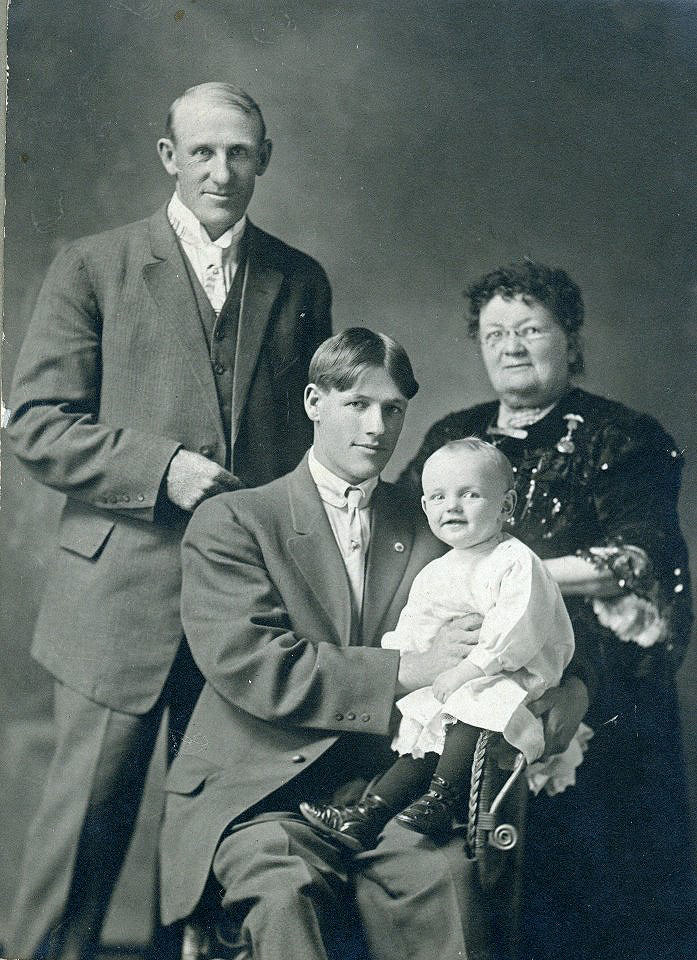 Harold A. Christensen, a pioneer of the Church in Calgary and a successful contractor, supervised the below-ground and basement construction of the Cardston Temple. He is pictured here in a four-generation photo with his mother, Emma Christensen, son Harold E. Christensen, and grandson Harold B. Christensen. (Courtesy of Linda Davis)
Harold A. Christensen, a pioneer of the Church in Calgary and a successful contractor, supervised the below-ground and basement construction of the Cardston Temple. He is pictured here in a four-generation photo with his mother, Emma Christensen, son Harold E. Christensen, and grandson Harold B. Christensen. (Courtesy of Linda Davis)
Construction of the temple proceeded steadily for eleven years, with major events featuring visiting General Authorities marking the various milestones of construction, including the dedication of the site (27 July 1913), the groundbreaking (5 November 1913), the laying of the cornerstone (15 September 1915), and the laying of the capstone (23 September 1917). Building a temple was a monumental task. Members hauled granite from the quarry to the train station in Nelson, BC, by train to Cardston and from the train station to the temple site by horse-drawn wagons. They did much of the work without the benefit of modern machinery. Years after the temple was dedicated, Jenny Hinman Vance shared her fond memory of the construction that she witnessed as a young girl:
I can remember the summer times when I was a child, watching it all take form. At that time there were no motored machines to dig and haul. Horses pulled the big “fresnoes” that dug the great hole for the foundation. And horses also pulled the great wagons of stone from the railway station and worked the pullies that unloaded and placed them.
I well remember the summer that many big supporting walls in the great hole were finished. They formed long, narrow hallways, that wound around a centre square. And that centre square, said the workmen, was to be the base of the font, a baptismal font. That was a new word for us as children. We were all baptized in the creek, and to have a special place, a font for baptizing, that was exciting.[285]
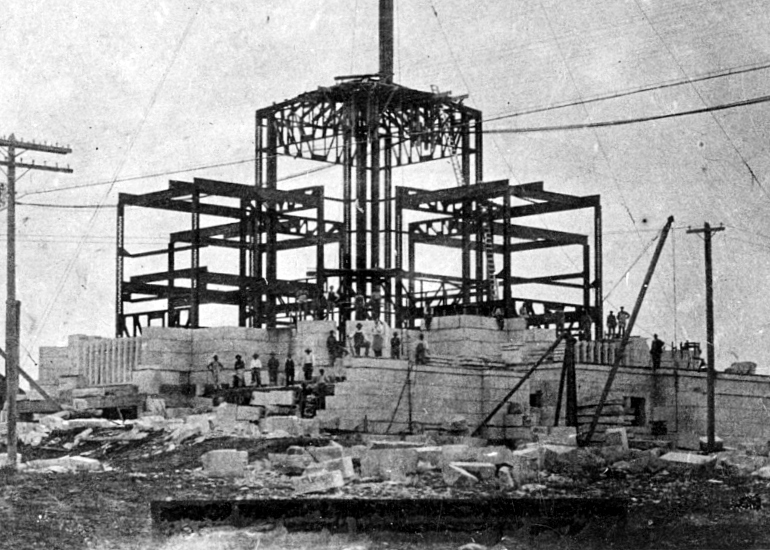 Construction of the Cardston Alberta Temple took nearly ten years, from the groundbreaking in 1913 to its dedication in 1923. (Sir Alexander Galt Museum and Archives)
Construction of the Cardston Alberta Temple took nearly ten years, from the groundbreaking in 1913 to its dedication in 1923. (Sir Alexander Galt Museum and Archives)
Once the capstone was laid in late 1917, the interior work began. It included priceless murals and sculptures, exceptionally fine wood, and magnificent metal work. The best craftsmen and artists of the time worked on the temple interior. Rare and precious woods were imported from around the world, including African mahogany and South American walnut, as well as ebony, rosewood, tulipwood, maple, and oak. LeConte Stewart, Lee Greene Richards, Edwin Evans, and A. B. Wright were the chief artists who painted the murals in the ordinance rooms. Their paintings vividly tell the story of the gospel principles. Torlief Knaphus, a Norwegian convert and sculptor, carved the bas-relief at the front entrance of the temple depicting Jesus with the Samaritan woman at the well, and he also crafted the oxen for the baptismal font.[286] The design and craftsmanship of the Cardston Temple are exquisite. The temple was the first one constructed outside the United States and can be considered one of the priceless treasures of the Church.[287]
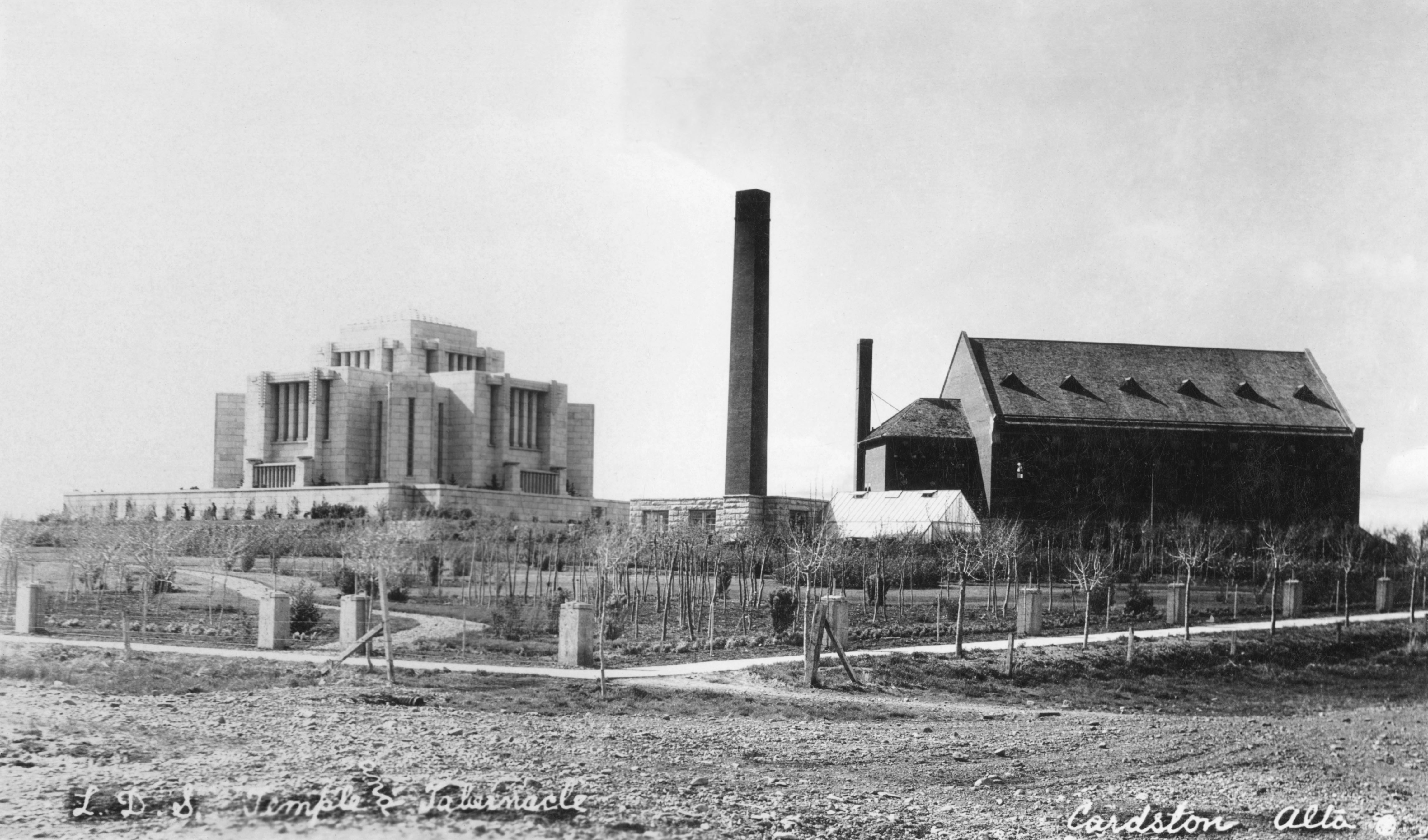 The Cardston Tabernacle, located on the northeast corner of the temple block, was completed in 1912 under the direction of E. J. Wood. It was a focal point for community, cultural, social, and religious gatherings for many years. It was demolished in 1954 when a new Church building was built to accommodate multiple wards. (Glenbow Archives PA-3689-400)
The Cardston Tabernacle, located on the northeast corner of the temple block, was completed in 1912 under the direction of E. J. Wood. It was a focal point for community, cultural, social, and religious gatherings for many years. It was demolished in 1954 when a new Church building was built to accommodate multiple wards. (Glenbow Archives PA-3689-400)
Construction of the temple was largely complete by 1921, but a shortage of finances resulted in a delay in putting in the furnishings of the temple and dedicating the structure.[290] In the meantime, E. J. Wood and his counselors took thousands of visitors on tours of the building. President Thomas L. Duce of the Alberta Stake presidency alone recorded having escorted thirty-five thousand people through the temple.[291]
On 26 August 1923, the long-awaited day came for the temple dedication. Church President Heber J. Grant and Anthony W. Ivins of the First Presidency, as well as nine members of the Quorum of Twelve Apostles, David A. Smith of the Presiding Bishopric, Church Patriarch Hyrum G. Smith, and Assistant Church Historian Andrew Jenson came on a special excursion train, along with stake and ward officers from all over the Church.[292] Elder John A. Widtsoe stated, “It was the first time in the history of the Church . . . that so many of the General Authorities of the Church had been assembled at one time outside the boundaries of the United States.”[293]
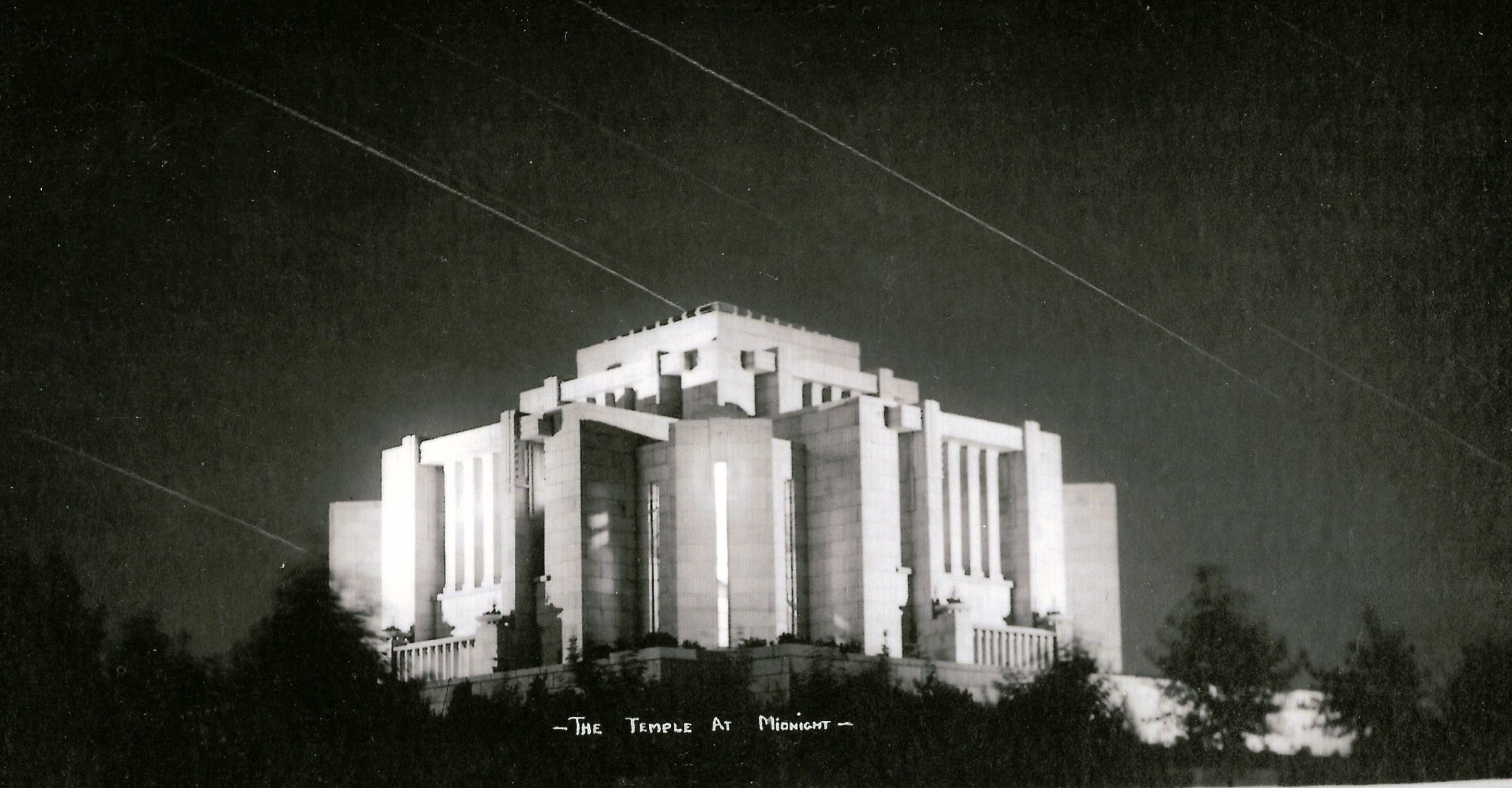 This dramatic night photograph of the recently constructed Cardston Alberta Temple was taken in the 1920s by G. E. Anderson of Springville, Utah, using the glass-plate process. The long exposure required by this process took nearly all night, creating the star traces in the sky. (Courtesy of Lynn Rosenvall)
This dramatic night photograph of the recently constructed Cardston Alberta Temple was taken in the 1920s by G. E. Anderson of Springville, Utah, using the glass-plate process. The long exposure required by this process took nearly all night, creating the star traces in the sky. (Courtesy of Lynn Rosenvall)
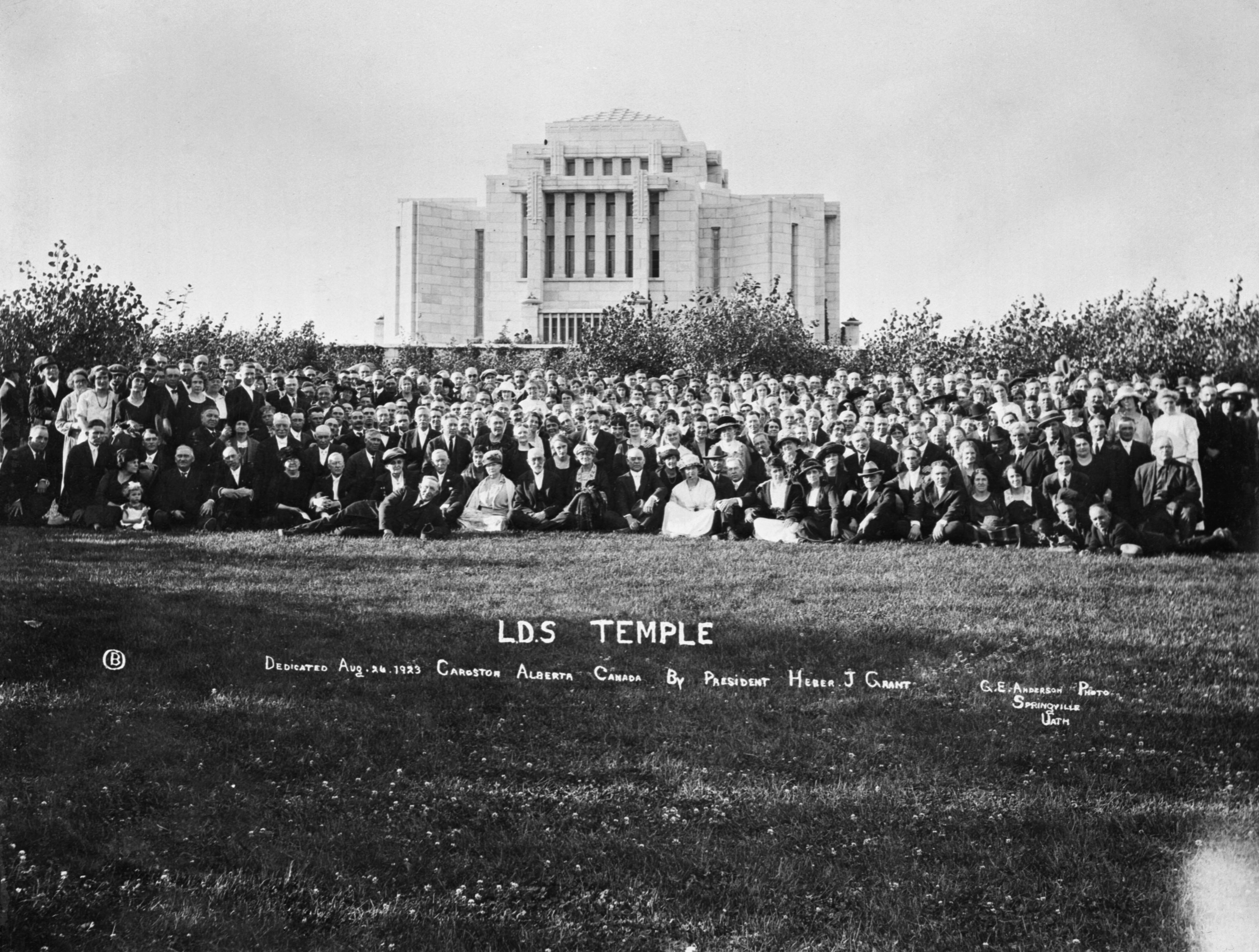 Dedicated in August 1923, the Cardston Alberta Temple was a symbol of the people’s faithfulness and the permanent establishment of the Church in Canada. Church President Heber J. Grant and other General Church leaders are seated with local Saints on the lawn of the temple on the day of its dedication. (Glenbow Archives, NA-512-3)
Dedicated in August 1923, the Cardston Alberta Temple was a symbol of the people’s faithfulness and the permanent establishment of the Church in Canada. Church President Heber J. Grant and other General Church leaders are seated with local Saints on the lawn of the temple on the day of its dedication. (Glenbow Archives, NA-512-3)
By 1923, the LDS population in southern Alberta had swelled to 9,500. In order to accommodate all who wished to attend the dedication, eleven dedicatory sessions were held, with over six hundred people attending each session. There were three sessions held per day from Sunday the 26th until Wednesday the 29th of August. [294] Special choirs from surrounding settlements sang at each session. On the last day of the dedication, those who had travelled from far away had the opportunity to participate in temple ceremonies. Lee Gilchrist and his wife, Edna Harker Gilchrist, were the first couple to have their marriage solemnized for eternity in the Cardston temple.[295] E. J. Wood was named temple president, and he served in that capacity for the next twenty-five years, nineteen of which he also served as stake president. [296]
C. Frank Steele, Canadian-Mormon writer and Church leader, expressed what it meant to the Canadian Saints to have a temple dedicated: “With the completion of the Alberta Temple at Cardston . . . came a re-orientation of their whole thought, purpose and outlook.” The temple, he said, represented “a crowning reward for their faithfulness, a symbol of permanency in their new Canadian home” and would be a future gathering place. The temple would unify the Saints and fortify them for their trials.[297]
The dedicatory prayer read in each session by President Heber J. Grant touched on several of the themes developed in this chapter. He expressed the profound appreciation of the Canadian Saints for having a temple dedicated in this “choice land,” their love and appreciation for Charles Ora Card’s work in pioneering LDS settlement in Canada, and for the “faithful and diligent” men who were then presiding in the Alberta stakes. He noted that Canada had been a land of liberty for the Saints, where they had received “splendid treatment” from Canadian government officials, and he expressed the hope that the members of the Church would live in “truth and righteousness” so as to merit the goodwill they had been accorded. Another of the items mentioned in the prayer, specific to local circumstances, was a plea for the land to produce harvests “that all who dwell hereon may be prospered in righteousness.”[298]
Conclusion
These themes from the dedicatory prayer are also key themes from this chapter. God led many of his faithful Saints to settle in Canada, where they experienced refuge, liberty, and fair treatment under Canadian law. In turn, Mormon settlers in Alberta made a tremendous contribution to the overall development of southern Alberta, being instrumental in bringing in large-scale irrigation, developing the sugar beet industry, establishing flour mills, pioneering sheep farming, and bringing in other innovations. Further, the success of their settlements was an essential precursor to the widespread settlement of the Palliser Triangle. They were at all times ably guided by inspired priesthood leaders and over time prospered, despite hardships and challenging weather, because of their faithfulness in following their leaders and the Lord. In thirty-six years, three stakes had been established with over nine thousand members, and an exquisite temple constructed.[299] As a result, the Latter-day Saints had a mature, stable, and permanent presence in southern Alberta and were poised to be a seedbed for the growth of the Church all across Canada.
Notes
[1] Though properly known as Lee Creek, locals, past and present, including Charles Ora Card, commonly call it Lee’s Creek.
[2] The authors express their appreciation for the research contribution of Daniel H. Olsen on the popular response to early Mormons, the trip to Ottawa and other topics of the early settlement period. See John C. Lehr and Yossi Katz, “Crown, Corporation and Church: The Role of Institutions in the Stability of Pioneer Settlements in the Canadian West, 1870–1914,” Journal of Historical Geography 21, no. 4 (1995): 413–29. Dan Erickson, “Alberta Polygamists? The Canadian Climate and Response to the Introduction of Mormonism’s ‘Peculiar Institution,’” Pacific Northwest Quarterly 85, no. 4 (1995): 155–64, 1995. Sarah Carter, The Importance of Being Monogamous: Marriage and Nation Building in Western Canada to 1915 (Edmonton: University of Alberta Press, 2008) 41-50.
[3] For more on Canadian Confederation, see, for example, Donald G. Creighton, The Road to Confederation: The Emergence of Canada, 1863–1867 (Toronto: Houghton Mifflin, 1964).
[4] A. A. Den Otter, Civilizing the West: The Galts and the Development of Western Canada (Edmonton, University of Alberta Press, 1982), 76.
[5] For a more detailed discussion of what southern Alberta was like when the first Mormon settlers came, see A. A. Den Otter, “A Congenial Environment: Southern Alberta on the Arrival of the Mormons,” in The Mormon Presence in Canada, ed. Brigham Y. Card et al. (Edmonton: University of Alberta Press, 1990), 53–74.
[6] Leonard Arrington, “Historical Roots of the Mormon Settlement,” in Card, Mormon Presence in Canada, 8.
[7] Arrington, “Historical Roots,” 4–5.
[8] Arrington, “Historical Roots,” 7.
[9] Irene Rose and Myrtle Morgan, “Railroading in Canada,” in The Mormons in Canada, vol. 2 of Treasures of Pioneer History, comp. Kate B. Carter (Salt Lake City: Daughters of Utah Pioneers, 1953), 47.
[10] Donald G. Godfrey and Brigham Y. Card, eds., The Diaries of Charles Ora Card: The Canadian Years, 1886–1903 (Salt Lake City: University of Utah Press, 1993), 19. Hereafter referred to as Card Diaries.
[11] From 1 to 12 November 1886, Card was awaiting instructions from Church President John Taylor on whether his labors were accepted and whether he was free to return to Utah. (Card Diaries, 21–22)
[12] Arrington, “Historical Roots,” 6.
[13] Arrington, “Historical Roots,” 8.
[14] Arrington, “Historical Roots,” 8.
[15] Card Diaries, xxxvi–xxxvii.
[16] “Canada’s Brigham Young: The Life of Charles O. Card,” 17 May 2012, https://
[17] “Canada’s Brigham Young.”
[18] Card Diaries, xxxviii.
[19] “Canada’s Brigham Young.”
[20] Card Diaries, 3–4.
[21] Card Diaries, xxxviii.
[22] “Canada’s Brigham Young.”
[23] Card Diaries, 12; emphasis added by Card.
[24] Card Diaries, 13–14.
[25] Lethbridge Stake, A History of the Mormon Church in Canada (Lethbridge, Alberta: Lethbridge Herald, 1968), 25. This quote was shared after the fact by Zina Young Card, one of Card’s wives, and these may or may not be the words he actually spoke. In Card Diaries it also tells of them meeting (15). Card tells us that the mountaineer’s name is McDonald.
[26] Card Diaries, 17.
[27] “We rested here at ‘Stand off’ to day which is a place given this name by some men that stood off the U.S. Martial that were smuggling whiskey into these part[s] to sell to indians.” (Card Diaries, 18.)
[28] Card Diaries, 18.
[29] He is referring to Lee Creek and the St. Mary River. (Card Diaries, 18.)
[30] See Card Diaries, 23, 25–28, 30, 32.
[31] Card Diaries, 35.
[32] The Old Testament story of Gideon is told in Judges 7. God reduced an Israelite army of thirty-two thousand men led by Gideon to three hundred men by subjecting them to a series of tests. In the end, three hundred of God’s choicest men defeated a vast army of Midianites by relying on help from God.
[33] Card Diaries, 36.
[34] Lethbridge Stake, Mormon Church in Canada, 28.
[35] Jessie L. Embry, “Exiles for the Principle: LDS Polygamy in Canada,” Dialogue: A Journal of Mormon Thought 18 (Fall 1985): 109.
[36] Lethbridge Stake, Mormon Church in Canada, 30.
[37] The Book of Mormon is a religious history of the ancient inhabitants of the American continent. Mormons identify American Indians as descendants of these Book of Mormon peoples and members of the House of Israel with promises of latter-day redemption. See for example “Mingled Destinies: The Lamanites and the Latter-day Saints,” Ensign, December 1975, https://
[38] Card Diaries, 52.
[39] Card Diaries, 53
[40] Card Diaries, 53–55. “[Zina] traveled in company with John A. Woolf and his wife, Mary and their seven children. Six other families joined them on the way.” (Zina Y. C. Brown, “Mother of Cardston,” in Mormons in Canada, vol. 2 of Treasures of Pioneer History, ed. Kate B. Carter, 53.)
[41] Card Diaries, 57; emphasis in original. This commemorative monument is very similar to what the Israelites did in crossing the Jordan River to enter the land of Israel. The Lord told Joshua to erect a monument in memory of their crossing into the Promised Land, and he told them “these stones shall be for a memorial unto the children of Israel for ever. And the children of Israel did so as Joshua commanded, and took up twelve stones out of the midst of Jordan, as the Lord spake unto Joshua, according to the number of the tribes of the children of Israel, and carried them over with them unto the place where they lodged, and laid them down there. …and they are there unto this day” (Joshua 4:7–9). See also Dennis A. Wright and others, “Mapping the Alberta Route of the 1887 Mormon Trek from Utah to Cardston,” in Alberta History 51, no. 3 (Summer 2003), 2–11.
[42] This account was written by two sisters, Jane Eliza Woolf Bates and Zina Alberta Woolf Hickman. Jane was thirteen at the time the family came to Canada, and Zina was born four months later, on 17 December 1887, the first child born in Cardston. Years later, the two sisters wrote their memories of coming to Canada. Jane Eliza Woolf Bates and Zina Alberta Woolf Hickman, Founding of Cardston and Vicinity (Charles Ursenbach, 1974), 16; “Jane Eliza Woolf Bates and Zina Alberta Woolf Hickman: The Great Trek,” Mary’s Genealogy Treasures, www.telusplanet.net/
[43] The St. Mary River was and still is commonly referred to by locals, including Charles Ora Card, as the St. Mary’s River.
[44] Card Diaries, 58.
[45] Card Diaries, 58.
[46] Bates and Hickman, Founding of Cardston and Vicinity, 17.
[47] Card Diaries, 58.
[48] Embry, “LDS Polygamy in Canada,” 109.
[49] Card Diaries, 58.
[50] Card Diaries, 59; Lethbridge Stake, Mormon Church in Canada, 36–38.
[51] Lethbridge Stake, Mormon Church in Canada, 45. Card Diaries, 59.
[52] A. A. Den Otter, “Congenial Environment,” Brigham Y. Card, “Charles Ora Card and the Founding of the Mormon Settlements in Southwestern Alberta, North-West Territories,” and Maureen Ursenbach Beecher, “Mormon Women in Southern Alberta,” in Mormon Presence in Canada, 67, 91–92, 223.
[53] Card Diaries, 61.
[54] For more information on the land in southern Alberta and the variability and extremes of southern Alberta weather and how they impacted early Mormon settlers, see Andrew H. Hedges, “‘I Wondered If I Could Feel at Home’: Southern Alberta Through the Eyes of Its Early Saints, 1883–1910,” in Western Canada, vol. 2 of Regional Studies in LDS Church History, ed. Dennis A. Wright, Robert C. Freeman, Andrew H. Hedges, and Matthew O. Richardson (Provo, UT: Brigham Young University, 2000), 76–88.
[55] Card Diaries, 59–60.
[56] Card Diaries, 61.
[57] Card Diaries, 62.
[58] Quoted in Lethbridge Stake, Mormon Church in Canada, 47.
[59] Lethbridge Stake, Mormon Church in Canada, 47–48.
[60] V. A. Wood, The Alberta Temple, Centre and Symbol of Faith (Calgary, Alberta: Detselig Enterprises, 1989), 26.
[61] Wood, The Alberta Temple, 27.
[62] A more detailed discussion of the delegation to Ottawa in 1888 is contained in Dennis A. Wright, “We Met ‘Sir John’ at 1:30 to the Minute: The 1888 Meeting of Mormon Leader, Charles O. Card and Sir John A. Macdonald, Prime Minister of Canada,” in Western Canada, vol. 2 of Regional Studies in LDS Church History, 99–122.
[63] Card Diaries, 66.
[64] Card Diaries, 66.
[65] Card Diaries, 66–67.
[66] Card Diaries, 67. Card recorded that by the end of the interview, Sir John’s “heart seemed to soften” and that “we all felt satisfied with the manner in which Sir John received us.”
[67] Card Diaries, 68.
[68] Card Diaries, 68.
[69] Card Diaries, 69.
[70] Card Diaries, 69.
[71] Card Diaries, 69.
[72] Card Diaries, 68.
[73] Card Diaries, 68.
[74] Jessie L. Embry, “Two Legal Wives,” in Mormon Presence in Canada, 173.
[75] Card did not record this promise in his journal at the time, but he refers to it in a letter to the Honourable A. M. Burgess, Deputy Minister of the Interior, which he copied to his journal on 22 February 1890.
[76] Card Diaries, 114.
[77] Card Diaries, 114.
[78] Embry, “Two Legal Wives,” 178. Embry lists John Lye Gibb, Franklin Dewey Leavitt, and Thomas Rowell Leavitt as three known cases of men having two wives in Canada. In each case, the two wives lived in separate communities.
[79] See the entry for Thomas Rowell Leavitt on FamilySearch, https://
[80] Embry, “Two Legal Wives,” 178. See also Embry, “LDS Polygamy in Canada,” 110.
[81] Howard Palmer, “Polygamy and Progress: The Reaction to Mormons in Canada, 1887–1923,” in Mormon Presence in Canada, 115.
[82] Fred E. Woods, “The Mormons and the Mounties: Contact and Assimilation in the Late Nineteenth Century,” Alberta History (Winter 2013), 14–15.
[83] “The Manifesto and the End of Plural Marriage,” https://
[84] Doctrine and Covenants, Official Declaration 1, 293.
[85] Doctrine and Covenants, Official Declaration 1, 292.
[86] “The Manifesto and the End of Plural Marriage.”
[87] Embry, “Two Legal Wives,” 175.
[88] See the entry for Theodore Brandley on FamilySearch, https://
[89] Embry, “LDS Polygamy in Canada,” 112.
[90] Embry, “LDS Polygamy in Canada,” 112. See the entry for Heber Simeon Allen on FamilySearch, https://
[91] Embry, “LDS Polygamy in Canada,” 112. See the entry for Edward James Wood on FamilySearch, https://
[92] Howard Palmer, Land of the Second Chance (Lethbridge, Alberta: Lethbridge Herald, 1972), 141.
[93] Embry, “LDS Polygamy in Canada,” 112. Embry cites one example, Edwin Bennion, president of the Granite Stake, who came to Canada to have his second marriage solemnized.
[94] “The Manifesto and the End of Plural Marriage.”
[95] Palmer, Land of the Second Chance, 141.
[96] See Embry, “Two Legal Wives,” 175; and “The Manifesto and the End of Plural Marriage.”
[97] Lynn A. Rosenvall, “The Transfer of Mormon Culture to Alberta,” in Essays on the Historical Geography of the Canadian West: Regional Perspectives on the Settlement Process, ed. L. A. Rosenvall and S. M. Evans (Calgary: University of Calgary, 1987), 134.
[98] Rosenvall, “The Transfer of Mormon Culture to Alberta,” 136.
[99] Lethbridge Stake, Mormon Church in Canada, 53.
[100] Lethbridge Stake, Mormon Church in Canada, 57.
[101] Card Diaries, 91, mentions currants and lilacs; 131 mentions rhubarb and trees.
[102] Lethbridge Stake, Mormon Church in Canada, 42.
[103] Lethbridge Stake, Mormon Church in Canada, 57.
[104] Palmer, “Polygamy and Progress,” 120–21.
[105] Lethbridge Stake, Mormon Church in Canada, 45.
[106] Palmer, “Polygamy and Progress,” 114.
[107] Card Diaries, 62.
[108] Card Diaries, 100.
[109] Palmer, “Polygamy and Progress,” 114.
[110] Quoted in A. A. Den Otter, Civilizing the West, 223.
[111] Quoted in Lethbridge Stake, Mormon Church in Canada, 46.
[112] Palmer, “Polygamy and Progress,” 127–28.
[113] Palmer, “Polygamy and Progress,” 130.
[114] Card Diaries, 18.
[115] A more detailed discussion of relationships between the Blood Indians and the early Mormon settlers can be found in Andrew H. Hedges, “I Wondered If I Could Feel at Home,” 90–91.
[116] Card Diaries, 369.
[117] Card Diaries, 244–45.
[118] Lethbridge Stake, Mormon Church in Canada, 45.
[119] Lynn Rosenvall, “The Church of Jesus Christ of Latter-day Saints in Alberta,” in Western Canada, vol. 2 of Regional Studies in LDS Church History, 4; Wood, The Alberta Temple, 14.
[120] Card Diaries, 273.
[121] Lethbridge Stake, Mormon Church in Canada, 59.
[122] See Card Diaries, 260 and 348, where on Thursday, 24 May 1904, he wrote, “Many people during my sojourn at Logan this time as before enquired about Canada,” or on 22 June 1896, when he wrote that “many of the people from Utah write me about the Country it causes me much work.”
[123] According to Lethbridge Stake, Mormon Church in Canada, 58, the population was 674 in October 1894. The population was 780 by the end of 1895 according to Gladys H. Noyce, Church Membership Statistical Summaries, CHL, CR 100 326.
[124] Noyce, Church Membership Statistical Summaries.
[125] For some examples see Card Diaries, 205, 269, 296, 302, 319, 326–28, 332, 346–47, 354, 356, 370, 373, 407–8, 411, 417, 461, 498, 512, 634.
[126] Card’s prophecies include finding work the first winter. (Card Diaries, 60–61.)
[127] In addition to the temple prophecy already cited, see ibid., 97, 227–28, 242; and Samuel Wooley Taylor, Family Kingdom (New York: McGraw-Hill, 1951), 132, 137–39.
[128] There are many examples of this. See for instance Card Diaries, 94, 97 (prayers for spring rain, 1889); 352 (fasting and prayer for summer rain, 1896); and 372–73 (fasting and prayer for excessive snow to melt to preserve stock, 1896).
[129] Card Diaries, 92. In May 1889, Card states, “Many times the brethren and sisters here in exile feel they are tried almost beyond that which they can bear.”
[130] “The Father of Magrath: Levi Harker Left Lasting Legacy in Magrath,” 31 May 2012, https://
[131] C. O. Card and Ephraim Harker purchased the first sheep from a ranch east of Choteau, Montana, in November 1890. This was a venture supported by the Church. See Card Diaries, 157–58.
[132] Harker Heritage, 33–34.
[133] The Harker family has printed a book highlighting the family history and personal accomplishments of Levi Harker and his wife, Martha. It is Harker Heritage (Magrath, Alberta: Harker Family, 1993).
[134] C. A. Magrath, The Galts, Father and Son: Pioneers in the Development of Southern Alberta and How Alberta Grew Up: Brief Outline of Development in the Lethbridge District (Lethbridge: Lethbridge Herald, 1936), 41.
[135] For Card’s campaigning, see Card Diaries, 259, 263, 267, 276, 301. For John W. Taylor’s promotion of irrigation, see John R. Hicken, Events Leading to the Settlement of the Communities of Cardston, Magrath, Stirling, and Raymond, Alberta (master’s thesis, Utah State University, 1968), 68. Richard Pilling’s role is suggested in John F. Gilpin, “The Mormons and the Beginning of the Irrigation Industry in Alberta,” in Western Canada, vol. 2 of Regional Studies in Latter-day Saint Church History, 142–43, 148. Card Diaries records that Richard Pilling went to Ottawa to lobby for irrigation in May 1894 when Card and Taylor were unable to go (258). Gilpin also suggests that Card, Taylor, and Apostle Francis M. Lyman spoke with Sir John A. Macdonald about their “practical experience with irrigation techniques in Utah” (145).
[136] Gilpin, “Mormons and the Beginning of the Irrigation Industry in Alberta,” 142.
[137] Gilpin, “Mormons and the Beginning of the Irrigation Industry,” 142.
[138] See Hicken, Events Leading to the Settlement of the Communities, 62.
[139] Gilpin, “Mormons and the Beginning of the Irrigation Industry,” 151–55.
[140] See A. A. Den Otter, Civilizing the West, 203. Every time they began a new project, changed their objectives, or needed to change the investment structure, a new company emerged. Their companies included The Northwestern Coal and Navigation Company (NWC & N Co; coal mining and transport of coal to Dunmore by steam ship, incorporated in 1882), Alberta Railway and Coal Company (coal mining and narrow gauge railway from Dunmore to Lethbridge. This company absorbed the assets of the NWC & N Co. Incorporated in 1884), Alberta Irrigation Company (AIC, which bought lands from the AR & C Co. and invested in irrigation projects, incorporated in 1893), St. Mary’s River Railway Company (which built the railway from Stirling to Cardston and on to Kimball, incorporated in 1900), Alberta Railway and Irrigation Company (AR & IC; incorporated in 1904, which absorbed all other Galt companies).
[141] Hicken, Events Leading to the Settlement of the Communities, 57.
[142] Gilpin, Quenching the Prairie Thirst, 16.
[143] Gilpin, Quenching the Prairie Thirst, 17.
[144] Gilpin, “Mormons and the Beginning of the Irrigation Industry,” 141, 143–45.
[145] Gilpin, “Mormons and the Beginning of the Irrigation Industry,” 146.
[146] Gilpin, Quenching the Prairie Thirst, 12, 14.
[147] Gilpin, “Mormons and the Beginning of the Irrigation Industry,” 147, 151, 154.
[148] See Hicken, Events Leading to the Settlement of the Communities, 66.
[149] Gilpin, “Mormons and the Beginning of the Irrigation Industry,” 159. Clifford Sifton arranged an Order in Council whereby they were rebated ten cents per acre in survey fees, conditional on the company spending $200,000 in three years on the irrigation project and having settlers on the land as per their plans.
[150] Byron C. Palmer and Craig J. Palmer, “Mormons in Western Canadian Agriculture,” in Mormon Presence in Canada, 236.
[151] Card, “Charles Ora Card and the Founding of the Mormon Settlements,” 94.
[152] See Card Diaries, 391, and Mary B. Pharis, “The Development of Irrigation in Southern Alberta,” unpublished history paper, 1969, http://
[153] See Card Diaries, 424; Lethbridge Stake, Mormon Church in Canada, 64; Card, “Charles Ora Card and the Founding of the Mormon Settlements,” 94–95 and Gilpin, Quenching the Prairie Thirst, 23. Each source refers to different aspects of the contract with Gilpin providing the most comprehensive explanation of the terms which were not as simple as some sources suggest.
[154] Gilpin, Quenching the Prairie Thirst, 23.
[155] A. A. Den Otter, Civilizing the West, 226.
[156] Palmer, Land of the Second Chance, 147.
[157] Palmer, Land of the Second Chance, 147.
[158] Palmer, “Polygamy and Progress,” 113.
[159] Card Diaries, 423.
[160] Judith P. Nilsson, ed., Stirling, Its Story and People, 1899–1980 (Stirling, Alberta: Stirling Sunset Society, 1981), 4.
[161] Gilpin, “Mormons and the Beginning of the Irrigation Industry,” 27–28.
[162] Hicken, “Events Leading to the Settlement of the Communities,” 65.
[163] Card Diaries, 478–79.
[164] “Lethbridge,” Historica Canada, http://
[165] Card, “Charles Ora Card and the Founding of the Mormon Settlements,” 94.
[166] Card Diaries, 457.
[167] Card Diaries, 470.
[168] Kathy Bly and Gary Harker, Power of the Dream (Magrath, Alberta: Keyline Publishing, 1999), 14.
[169] Card Diaries, 491–97.
[170] Card, “Charles Ora Card and the Founding of the Mormon Settlements,” 95.
[171] Card, “Charles Ora Card and the Founding of the Mormon Settlements,” 97.
[172] Card Diaries, 484.
[173] Nilsson, Stirling, Its Story and People, 8.
[174] For a detailed story of one family’s experience travelling to Canada, see Mame’s Story, A Life Sketch of Mary Clark Hardy, researched by Marilynne Hardy Jorgensen, March 2005. The original source was taken from a life history written by Harriet Penelope Clark Hardy. Harriet was the older sister to Mame (Mary), and after the death of Mame, she married Mame’s husband, Raymond Gardner Hardy.
[175] Mame’s Story.
[176] Bly and Harker, Power of the Dream, 26.
[177] Taylor, Family Kingdom, 137-139.
[178] Card Diaries, 520.
[179] Rosenvall, “The Transfer of Mormon Culture to Alberta,” 138.
[180] Card Diaries, 502.
[181] See Nilsson, Stirling, Its Story and People, 9; Bly and Harker, Power of the Dream, 27.
[182] Nilsson, Stirling, Its Story and People, 9-10.
[183] Bly and Harker, Power of the Dream, 33.
[184] For more discussion on the culture of these communities, see chapter 6.
[185] See, for example, Bly and Harker, Power of the Dream: A Collection of Photographs and Stories of Magrath through the 20th Century, 18–20; Nilsson, Stirling, Its Story and People, 10.
[186] Palmer, Land of the Second Chance, 143-44.
[187] Palmer, Land of the Second Chance, 143.
[188] Magrath, How Alberta Grew Up, 53.
[189] Card Diaries, 314.
[190] Magrath, How Alberta Grew Up, 53–54.
[191] Magrath, How Alberta Grew Up, 53.
[192] J. William Knight, The Jesse Knight Family: Jesse Knight, His Forebears, and Family, (Salt Lake City: Deseret News Press, 1940), 37.
[193] Reese, “Uncle Jesse,” 29. See also Hicken, Events Leading to the Settlement of the Communities, 94.
[194] Lorenzo Snow, “New Century: Greeting to the World,” delivered at the Centennial Services in the Latter-day Saints Tabernacle, Salt Lake City, 1 January 1901, CHL, M247 S674g 1901; Knight, The Jesse Knight Family, 59–60.
[195] The History Book Committee, Raymond Remembered: Settlers, Sugar and Stampedes (Raymond, Alberta: Town of Raymond, 1993), 31.
[196] Magrath, How Alberta Grew Up, 54–55. The Bar K2 ranch land and other ranch property, originally owned by the Knights, was eventually purchased by the Church in a series of transactions between 1947 and 1979. Now, over 115 years after the original purchase, the Church operates “Deseret Ranches,” which include the original Bar K2 and Knight ranches. See also Raymond Remembered, 27.
[197] Since imperial measurements were used during the time period of this chapter, I have left these units in the text.
[198] Magrath, How Alberta Grew Up, 55.
[199] A Planting of the Lord: A Century of Latter-day Saints in Raymond, 1901–2001, (Raymond, Alberta: Raymond Alberta Stake, 2001), 67, 115; Hicken, Events Leading to the Settlement of the Communities, 9.
[200] A Planting of the Lord, 7.
[201] A Planting of the Lord, 115. See also Knight, The Jesse Knight Family, 56.
[202] Knight, The Jesse Knight Family, 57, 58.
[203] A Planting of the Lord, 8.
[204] Noyce, Church Membership Statistical Summaries.
[205] A Planting of the Lord, 7–8.
[206] Lethbridge Stake, Mormon Church in Canada, 100.
[207] Noyce, Church Membership Statistical Summaries.
[208] Lethbridge Stake, Mormon Church in Canada, 100.
[209] The History Book Committee, Raymond Remembered, 39.
[210] Gilpin, Quenching the Prairie Thirst: A History of the Magrath Irrigation District, Raymond Irrigation District, Taber Irrigation District and St. Mary River Irrigation District (Lethbridge: St. Mary River Irrigation Project, 2000), 71.
[211] Gilpin, Quenching the Prairie Thirst, 71.
[212] Gilpin, Quenching the Prairie Thirst, 71.
[213] Belinda Crowson, Alberta’s Sugar-Coated History: The Sugar Beet Industry (Lethbridge: Lethbridge Historical Society, 2013), 22–27. This book gives a very detailed analysis of the sugar-beet industry in southern Alberta from its beginnings until the present.
[214] Crowson, Alberta’s Sugar-Coated History, 27.
[215] Gilpin, Quenching the Prairie Thirst, 74.
[216] The History Book Committee, Raymond Remembered, 73.
[217] Magrath, How Alberta Grew Up, 57.
[218] Den Otter, Civilizing the West, 227.
[219] Fannie Morgan Brown, “In Caldwell,” in Kate B. Carter, ed., Treasures of Pioneer History, 74.
[220] Lethbridge Stake, Mormon Church in Canada, 134.
[221] Taber Alberta Stake, A Choice Land and People: Memories and Events, 1904–2004 (Taber, Alberta: Taber Alberta Stake, 2004), 27.
[222] Taber Alberta Stake, A Choice Land and People, 27, 31.
[223] Taber Alberta Stake, A Choice Land and People, 9.
[224] Taber Alberta Stake, A Choice Land and People, 9, 23. The first school and church building burned down in 1906, and a second school and church building was built to replace it.
[225] In 2016, for example, there were three wards in Taber with a population of just over eight thousand. It is interesting to see a town with such obvious Mormon historical character inhabited by mostly non-LDS residents.
[226] Barnwell Mormon Relief Society, Barnwell History (Ann Arbor, MI: Edwards Brothers, 1952), 20.
[227] Taber Alberta Stake, A Choice Land and People, 10.
[228] In 2016 there were two wards in the village with a population of 771.
[229] Gilpin, Quenching the Prairie Thirst, 101.
[230] Lethbridge Stake, Mormon Church in Canada, 101.
[231] Lethbridge Stake, Mormon Church in Canada, 137–41.
[232] Lethbridge Stake, Mormon Church in Canada, 147–48.
[233] Susan Easton Black, “Edward Wood: An Ordinary Man Who Became Extraordinary through His Service and Devotion to God While in Canada,” in Western Canada, vol. 2 of Regional Studies in LDS Church History, 175.
[234] Melvin S. Tagg, The Life of Edward James Wood: Church Patriot, (master’s thesis, Brigham Young University, 1959), 75.
[235] Tagg, The Life of Edward James Wood, 75.
[236] Tagg, The Life of Edward James Wood, 86.
[237] Lethbridge Stake, Mormon Church in Canada, 134.
[238] Tagg, The Life of Edward James Wood, 65–66.
[239] Tagg, The Life of Edward James Wood, 77.
[240] Black, “Edward Wood,” 179.
[241] Tagg, The Life of Edward James Wood, 77.
[242] Tagg, The Life of Edward James Wood, 105. See also Black, “Edward Wood,” 179.
[243] There are several examples of healings. See Black, “Edward Wood,” 181–82.
[244] The Story of E. J. Wood receiving a visit from Henry Hinman, who was deceased, is recorded in Olive Wood Nielson, A Treasury of E. J. Wood (Salt Lake City: Publishers Press, 1983), 624–27. Two separate accounts of visitations from deceased persons during temple sealings are recorded in the same book, 631–32. Additional accounts of visitations in the temple are also found there, 636–38.
[245] See A Planting of the Lord, 28–30, for accounts by Bob Brandley and William A. Anderson as well as the story as told by President James S. Walker, stake president in 1948.
[246] See Bly and Harker, Power of the Dream, 77, for a discussion of the increased harvest of 1915 over 1914 and its importance to the war effort.
[247] Tagg, The Life of Edward James Wood, 82.
[248] Tagg, The Life of Edward James Wood, 61.
[249] Tagg, The Life of Edward James Wood, 62.
[250] Tagg, The Life of Edward James Wood, 66.
[251] Lethbridge Stake, Mormon Church in Canada, 86–87.
[252] Lethbridge Stake, Mormon Church in Canada, 86.
[253] Daughters of the Utah Pioneers (DUP), “A Legacy for Lethbridge, Plaque #506,” (Lethbridge, Daughters of the Utah Pioneers, 1997), 1.
[254] DUP, “A Legacy for Lethbridge,” 1.
[255] DUP, “A Legacy for Lethbridge,” 2.
[256] DUP, “A Legacy for Lethbridge,” 2; and Palmer, Land of the Second Chance, 146.
[257] Lethbridge Stake, Mormon Church in Canada, 127–28.
[258] DUP, “A Legacy for Lethbridge,” 16.
[259] DUP, “A Legacy for Lethbridge,” 3.
[260] DUP, “A Legacy for Lethbridge,” 6.
[261] “High Level Bridge – Lethbridge, Alberta,” Crown of the Continent, http://
[262] Lethbridge Stake, Mormon Church in Canada, 130–31.
[263] Lethbridge Stake, Mormon Church in Canada, 133.
[264] Eugene E. Campbell and Richard D. Poll, Hugh B. Brown: His Life and Thought (Salt Lake City: Bookcraft, 1975), 53.
[265] Campbell and Poll, Hugh B. Brown, 53.
[266] Campbell and Poll, Hugh B. Brown, 53.
[267] Campbell and Poll, Hugh B. Brown, 54.
[268] Campbell and Poll, Hugh B. Brown, 60.
[269] See Hugh B. Brown, “God is the Gardener,” BYU Speeches, 31 May 1968, https://
[270] The History Book Committee, Raymond Remembered, 164.
[271] Bly and Harker, Power of the Dream, 78.
[272] Tagg, The Life of Edward James Wood, 70.
[273] Bly and Harker, Power of the Dream, 77.
[274] Noyce, Church Membership Statistical Summaries.
[275] Joseph F. Smith, in Conference Report, October 1901, quoted in Wood, The Alberta Temple, 28.
[276] “Approved Design for Temple in Alberta Province,” Deseret Semi-Weekly News, 2 January 1913; Wood, The Alberta Temple, 29.
[277] Wood, The Alberta Temple, 31.
[278] Wood, The Alberta Temple, 38.
[279] 1923 Lethbridge Herald article quoted in Wood, The Alberta Temple, 37.
[280] Wood, The Alberta Temple, 38–39.
[281] Wood, The Alberta Temple, 36, 90.
[282] Excerpt from a talk by Bishop David A. Smith during the temple dedication, in Wood, The Alberta Temple, 90.
[283] Wood, The Alberta Temple, 91.
[284] Wood, The Alberta Temple, 48. Wood’s book also contains stories that show the faithfulness of Church members who worked on the temple, 42–45.
[285] Wood, The Alberta Temple, 52–53; excerpts from Jennie Hinman Vance, “My Memories of the Temple,” compiled in temple book by Dora S. Bennett, matron 1982–1986.
[286] Paul Anderson, “First of the Modern Temples,” Ensign, July 1977, https://
[287] Lynn Rosenvall compiled a wonderful collection of photos, documents, biographies, and information about the Cardston Temple, which were donated to the University of Lethbridge. This collection, entitled “Cardston Alberta Temple: An Historical Record,” is available online at http://
[288] Account by Elizabeth Jean Sefcik, shared with permission by her son, Douglas Martin Sefcik.
[289] Account by Elizabeth Jean Sefcik, shared with permission by her son, Douglas Martin Sefcik.
[290] Wood, The Alberta Temple, 62.
[291] Wood, The Alberta Temple, 66.
[292] Tagg, The Life of Edward James Wood, 95.
[293] Wood, The Alberta Temple, 74; see also Lethbridge Stake, Mormon Church in Canada, 74.
[294] Nielson, A Treasury of Edward J. Wood, 473.
[295] Nielson, A Treasury of Edward J. Wood, 473. Lee Gilchrist was sealed to Edna Harker. Lee operated the steam hoist that lifted the granite blocks during the construction of the temple. He was the first engineer of the temple, and he worked on the boilers that heated the temple. Fifty-five years later, in 1978, their son, Vede Gilchrist, began serving as the temple recorder, and would for ten years Steve Gilchrist, the son of Vede, served in the same position as acting recorder in 2004 and temple recorder from 2005 until 2009. (Interview with Steve Gilchrist, Logan Zemp, and Jack Stone, April 2016). See also https://
[296] Nielson, A Treasury of Edward J. Wood, 618. President Wood passed away in 1956, just a half a year before his ninetieth birthday. J. M. Todd, “Edward J. Wood: ‘Faith Personified,’” Ensign, September 1988 , https://
[297] Lethbridge Stake, Mormon Church in Canada, 76.
[298] The dedicatory prayer is transcribed in full in Wood, The Alberta Temple, 77–84.
[299] Noyce, Church Membership Statistical Summaries.
